Impact of Social Media on Hotel Industry
VerifiedAdded on 2022/11/19
|83
|18246
|418
AI Summary
The paper focuses on the impact of social media on the success of the hospitality industry. It discusses the theoretical concepts, related discussion on the key topics, findings, investigation, and ways by which social media can be utilized as a tool to improve the operations of the hotel industry.
Contribute Materials
Your contribution can guide someone’s learning journey. Share your
documents today.
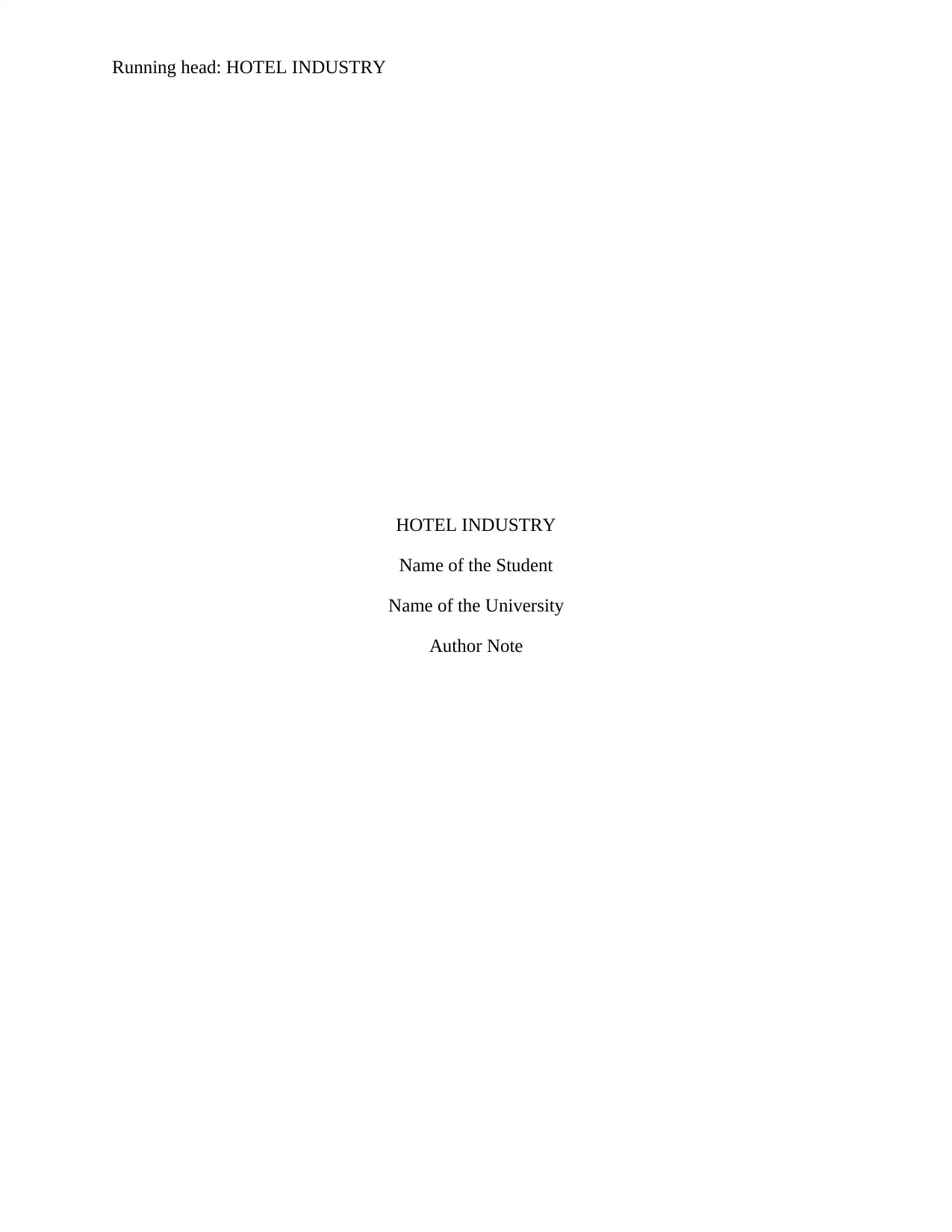
Running head: HOTEL INDUSTRY
HOTEL INDUSTRY
Name of the Student
Name of the University
Author Note
HOTEL INDUSTRY
Name of the Student
Name of the University
Author Note
Secure Best Marks with AI Grader
Need help grading? Try our AI Grader for instant feedback on your assignments.
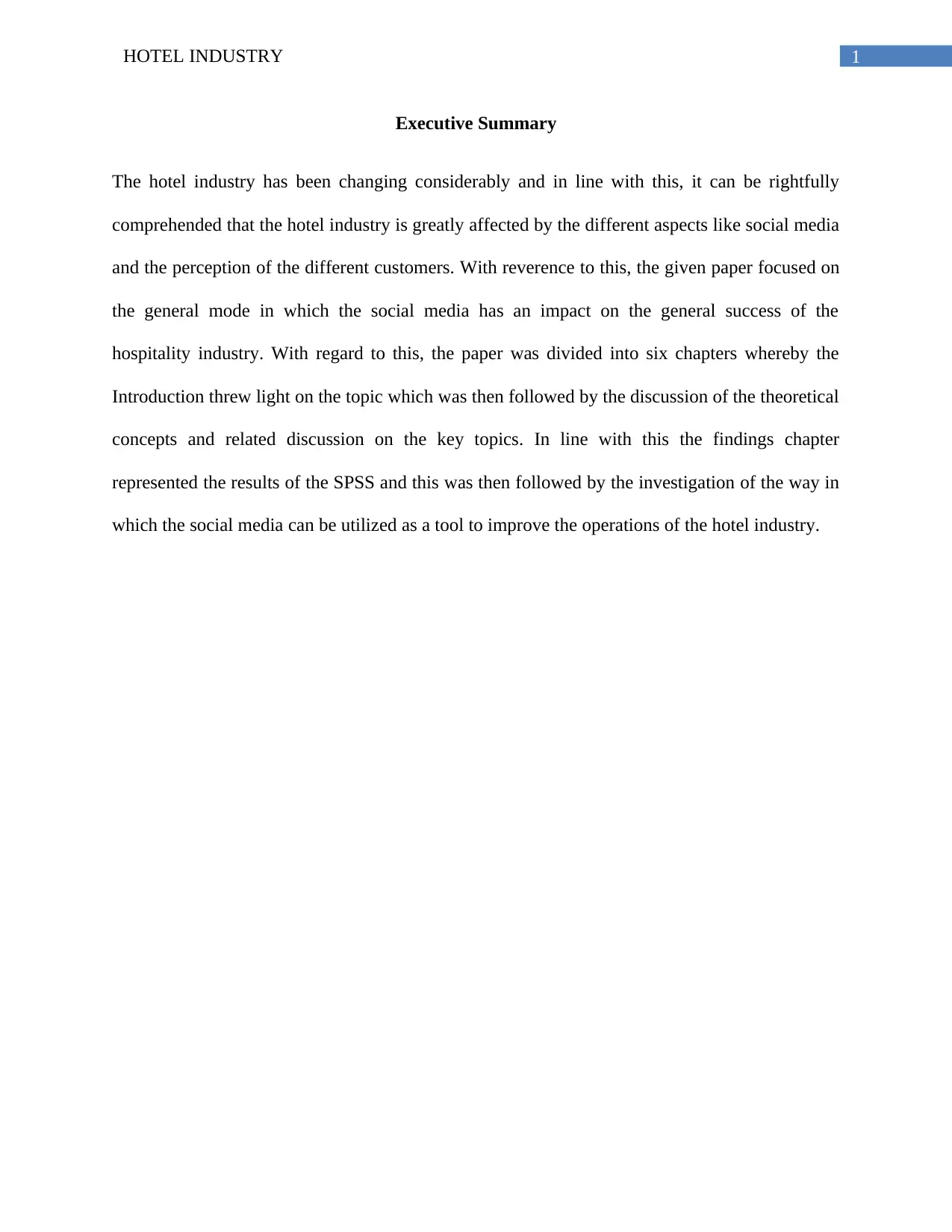
1HOTEL INDUSTRY
Executive Summary
The hotel industry has been changing considerably and in line with this, it can be rightfully
comprehended that the hotel industry is greatly affected by the different aspects like social media
and the perception of the different customers. With reverence to this, the given paper focused on
the general mode in which the social media has an impact on the general success of the
hospitality industry. With regard to this, the paper was divided into six chapters whereby the
Introduction threw light on the topic which was then followed by the discussion of the theoretical
concepts and related discussion on the key topics. In line with this the findings chapter
represented the results of the SPSS and this was then followed by the investigation of the way in
which the social media can be utilized as a tool to improve the operations of the hotel industry.
Executive Summary
The hotel industry has been changing considerably and in line with this, it can be rightfully
comprehended that the hotel industry is greatly affected by the different aspects like social media
and the perception of the different customers. With reverence to this, the given paper focused on
the general mode in which the social media has an impact on the general success of the
hospitality industry. With regard to this, the paper was divided into six chapters whereby the
Introduction threw light on the topic which was then followed by the discussion of the theoretical
concepts and related discussion on the key topics. In line with this the findings chapter
represented the results of the SPSS and this was then followed by the investigation of the way in
which the social media can be utilized as a tool to improve the operations of the hotel industry.
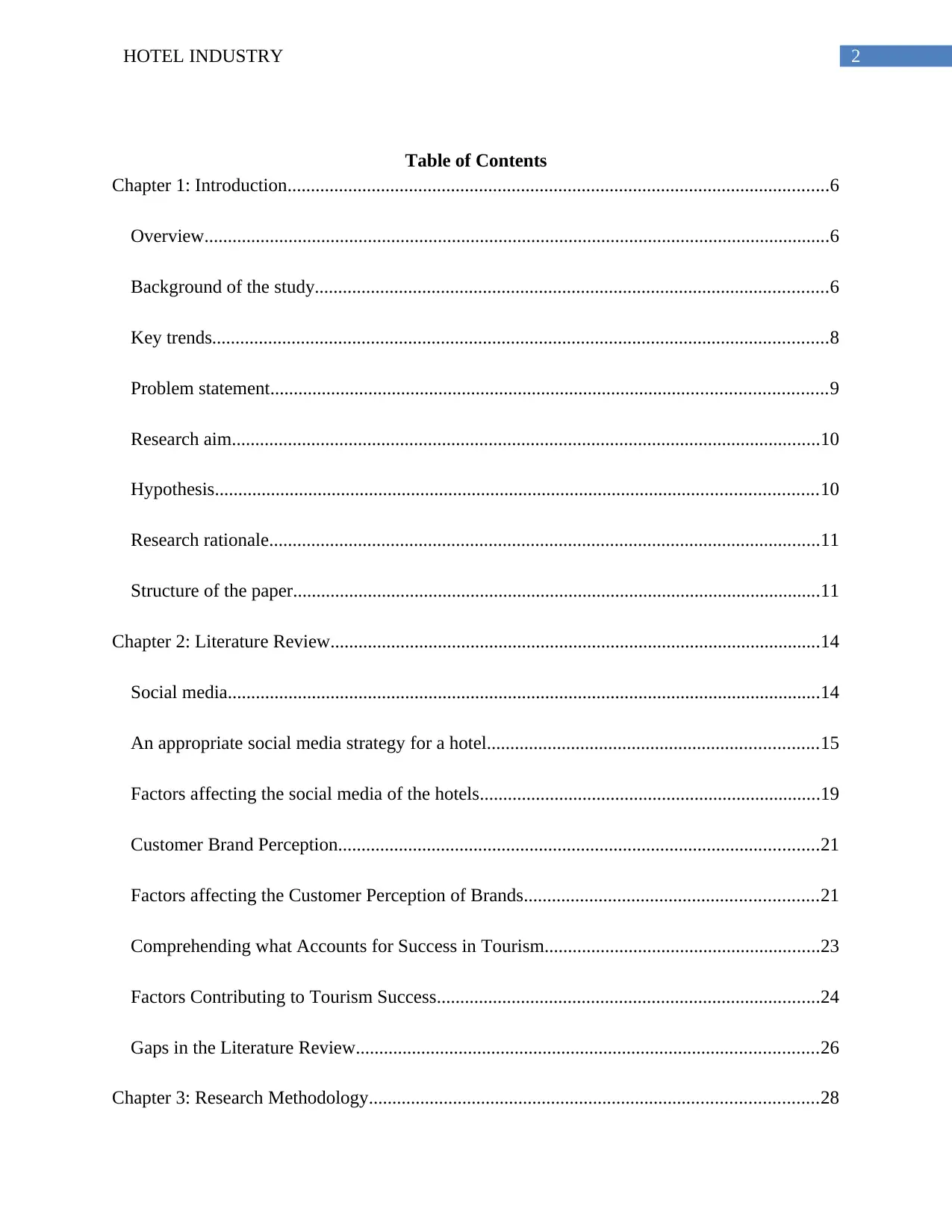
2HOTEL INDUSTRY
Table of Contents
Chapter 1: Introduction....................................................................................................................6
Overview......................................................................................................................................6
Background of the study..............................................................................................................6
Key trends....................................................................................................................................8
Problem statement.......................................................................................................................9
Research aim..............................................................................................................................10
Hypothesis.................................................................................................................................10
Research rationale......................................................................................................................11
Structure of the paper.................................................................................................................11
Chapter 2: Literature Review.........................................................................................................14
Social media...............................................................................................................................14
An appropriate social media strategy for a hotel.......................................................................15
Factors affecting the social media of the hotels.........................................................................19
Customer Brand Perception.......................................................................................................21
Factors affecting the Customer Perception of Brands...............................................................21
Comprehending what Accounts for Success in Tourism...........................................................23
Factors Contributing to Tourism Success..................................................................................24
Gaps in the Literature Review...................................................................................................26
Chapter 3: Research Methodology................................................................................................28
Table of Contents
Chapter 1: Introduction....................................................................................................................6
Overview......................................................................................................................................6
Background of the study..............................................................................................................6
Key trends....................................................................................................................................8
Problem statement.......................................................................................................................9
Research aim..............................................................................................................................10
Hypothesis.................................................................................................................................10
Research rationale......................................................................................................................11
Structure of the paper.................................................................................................................11
Chapter 2: Literature Review.........................................................................................................14
Social media...............................................................................................................................14
An appropriate social media strategy for a hotel.......................................................................15
Factors affecting the social media of the hotels.........................................................................19
Customer Brand Perception.......................................................................................................21
Factors affecting the Customer Perception of Brands...............................................................21
Comprehending what Accounts for Success in Tourism...........................................................23
Factors Contributing to Tourism Success..................................................................................24
Gaps in the Literature Review...................................................................................................26
Chapter 3: Research Methodology................................................................................................28
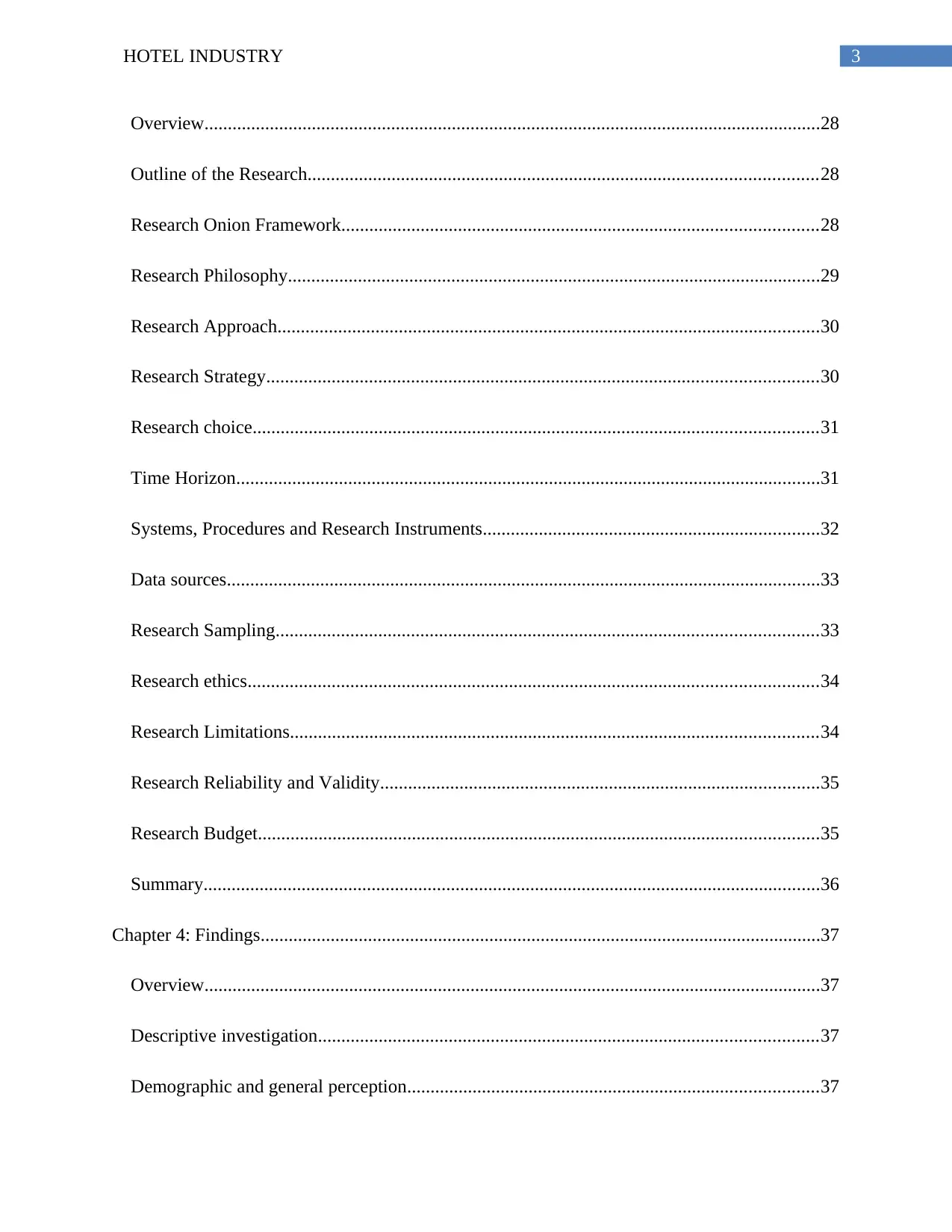
3HOTEL INDUSTRY
Overview....................................................................................................................................28
Outline of the Research.............................................................................................................28
Research Onion Framework......................................................................................................28
Research Philosophy..................................................................................................................29
Research Approach....................................................................................................................30
Research Strategy......................................................................................................................30
Research choice.........................................................................................................................31
Time Horizon.............................................................................................................................31
Systems, Procedures and Research Instruments........................................................................32
Data sources...............................................................................................................................33
Research Sampling....................................................................................................................33
Research ethics..........................................................................................................................34
Research Limitations.................................................................................................................34
Research Reliability and Validity..............................................................................................35
Research Budget........................................................................................................................35
Summary....................................................................................................................................36
Chapter 4: Findings........................................................................................................................37
Overview....................................................................................................................................37
Descriptive investigation...........................................................................................................37
Demographic and general perception........................................................................................37
Overview....................................................................................................................................28
Outline of the Research.............................................................................................................28
Research Onion Framework......................................................................................................28
Research Philosophy..................................................................................................................29
Research Approach....................................................................................................................30
Research Strategy......................................................................................................................30
Research choice.........................................................................................................................31
Time Horizon.............................................................................................................................31
Systems, Procedures and Research Instruments........................................................................32
Data sources...............................................................................................................................33
Research Sampling....................................................................................................................33
Research ethics..........................................................................................................................34
Research Limitations.................................................................................................................34
Research Reliability and Validity..............................................................................................35
Research Budget........................................................................................................................35
Summary....................................................................................................................................36
Chapter 4: Findings........................................................................................................................37
Overview....................................................................................................................................37
Descriptive investigation...........................................................................................................37
Demographic and general perception........................................................................................37
Secure Best Marks with AI Grader
Need help grading? Try our AI Grader for instant feedback on your assignments.
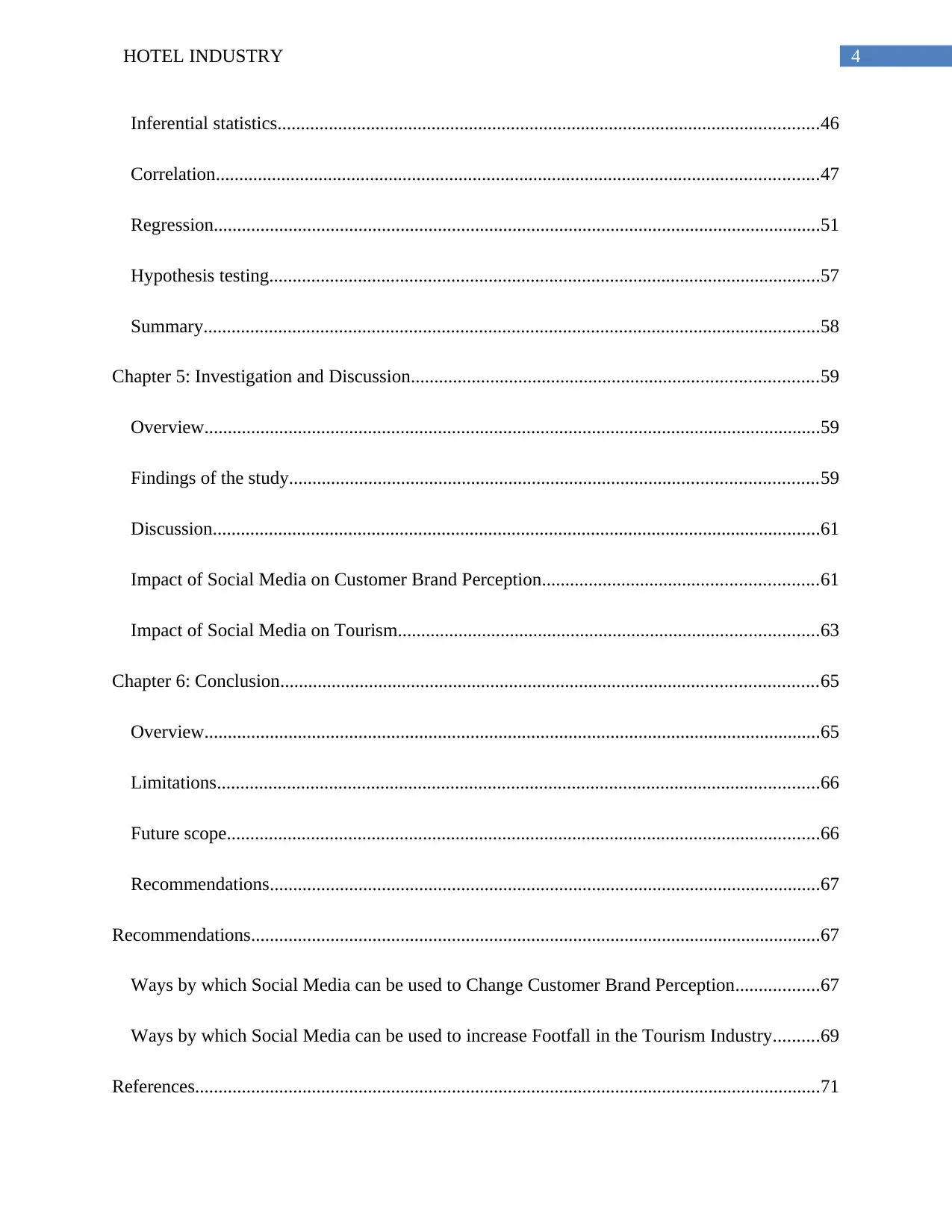
4HOTEL INDUSTRY
Inferential statistics....................................................................................................................46
Correlation.................................................................................................................................47
Regression..................................................................................................................................51
Hypothesis testing......................................................................................................................57
Summary....................................................................................................................................58
Chapter 5: Investigation and Discussion.......................................................................................59
Overview....................................................................................................................................59
Findings of the study.................................................................................................................59
Discussion..................................................................................................................................61
Impact of Social Media on Customer Brand Perception...........................................................61
Impact of Social Media on Tourism..........................................................................................63
Chapter 6: Conclusion...................................................................................................................65
Overview....................................................................................................................................65
Limitations.................................................................................................................................66
Future scope...............................................................................................................................66
Recommendations......................................................................................................................67
Recommendations..........................................................................................................................67
Ways by which Social Media can be used to Change Customer Brand Perception..................67
Ways by which Social Media can be used to increase Footfall in the Tourism Industry..........69
References......................................................................................................................................71
Inferential statistics....................................................................................................................46
Correlation.................................................................................................................................47
Regression..................................................................................................................................51
Hypothesis testing......................................................................................................................57
Summary....................................................................................................................................58
Chapter 5: Investigation and Discussion.......................................................................................59
Overview....................................................................................................................................59
Findings of the study.................................................................................................................59
Discussion..................................................................................................................................61
Impact of Social Media on Customer Brand Perception...........................................................61
Impact of Social Media on Tourism..........................................................................................63
Chapter 6: Conclusion...................................................................................................................65
Overview....................................................................................................................................65
Limitations.................................................................................................................................66
Future scope...............................................................................................................................66
Recommendations......................................................................................................................67
Recommendations..........................................................................................................................67
Ways by which Social Media can be used to Change Customer Brand Perception..................67
Ways by which Social Media can be used to increase Footfall in the Tourism Industry..........69
References......................................................................................................................................71
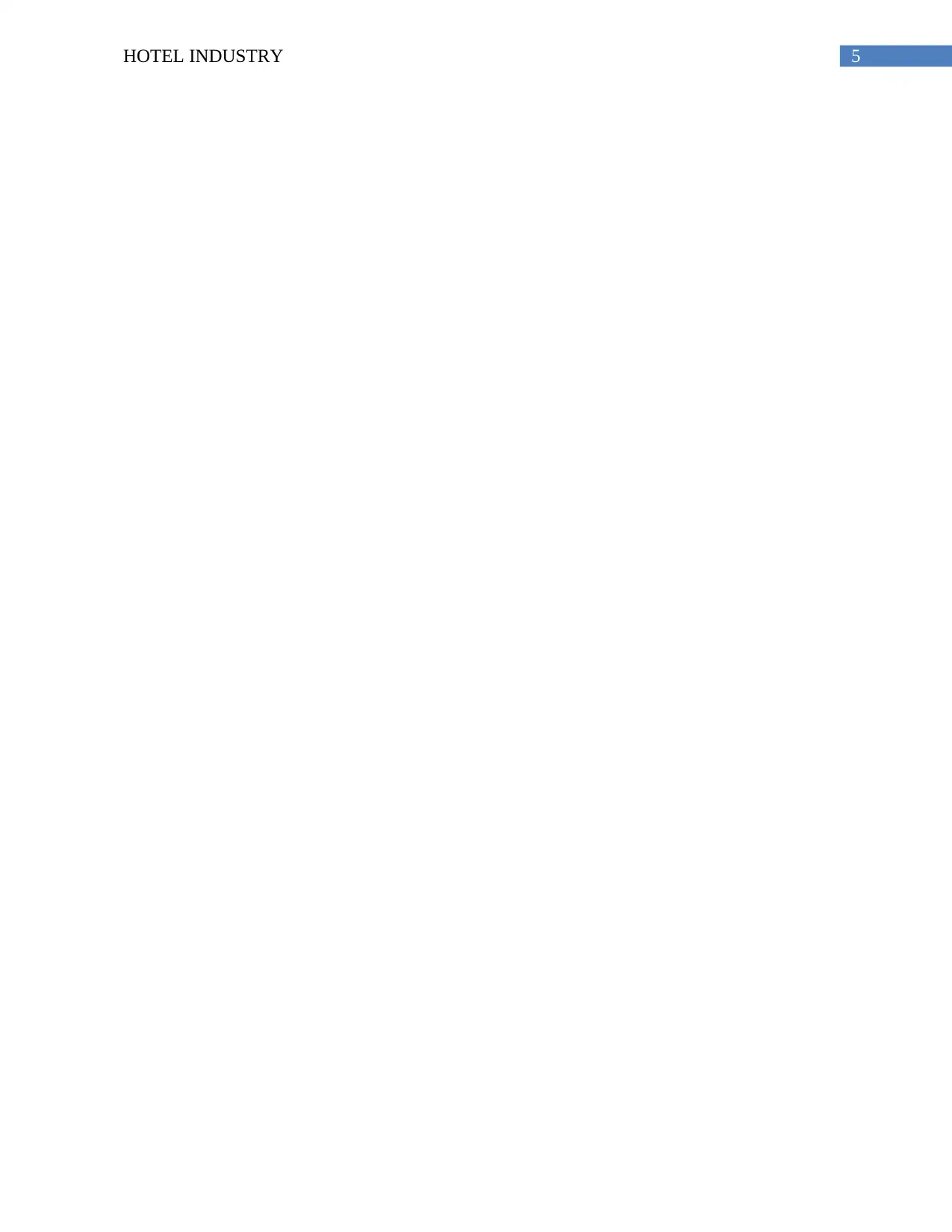
5HOTEL INDUSTRY
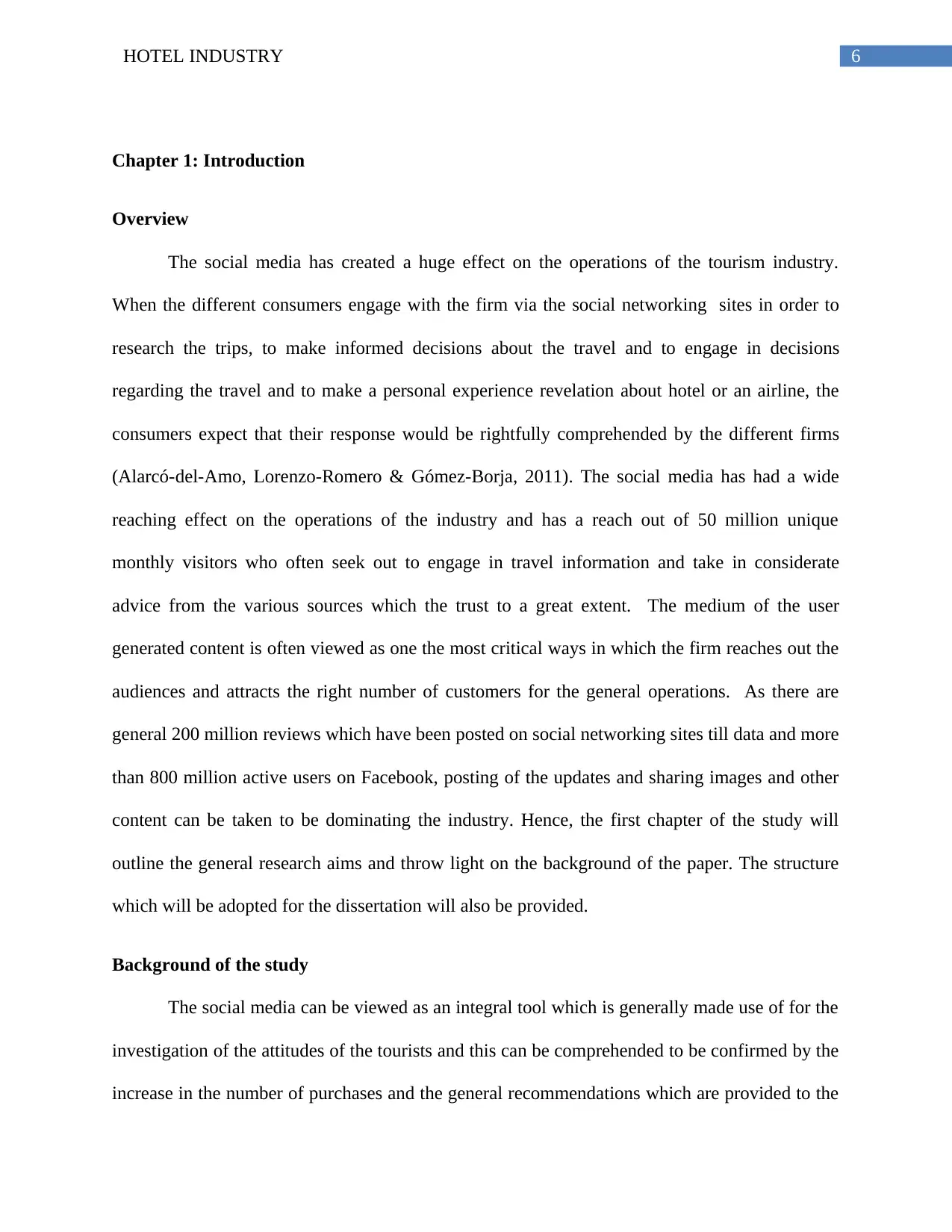
6HOTEL INDUSTRY
Chapter 1: Introduction
Overview
The social media has created a huge effect on the operations of the tourism industry.
When the different consumers engage with the firm via the social networking sites in order to
research the trips, to make informed decisions about the travel and to engage in decisions
regarding the travel and to make a personal experience revelation about hotel or an airline, the
consumers expect that their response would be rightfully comprehended by the different firms
(Alarcó-del-Amo, Lorenzo-Romero & Gómez-Borja, 2011). The social media has had a wide
reaching effect on the operations of the industry and has a reach out of 50 million unique
monthly visitors who often seek out to engage in travel information and take in considerate
advice from the various sources which the trust to a great extent. The medium of the user
generated content is often viewed as one the most critical ways in which the firm reaches out the
audiences and attracts the right number of customers for the general operations. As there are
general 200 million reviews which have been posted on social networking sites till data and more
than 800 million active users on Facebook, posting of the updates and sharing images and other
content can be taken to be dominating the industry. Hence, the first chapter of the study will
outline the general research aims and throw light on the background of the paper. The structure
which will be adopted for the dissertation will also be provided.
Background of the study
The social media can be viewed as an integral tool which is generally made use of for the
investigation of the attitudes of the tourists and this can be comprehended to be confirmed by the
increase in the number of purchases and the general recommendations which are provided to the
Chapter 1: Introduction
Overview
The social media has created a huge effect on the operations of the tourism industry.
When the different consumers engage with the firm via the social networking sites in order to
research the trips, to make informed decisions about the travel and to engage in decisions
regarding the travel and to make a personal experience revelation about hotel or an airline, the
consumers expect that their response would be rightfully comprehended by the different firms
(Alarcó-del-Amo, Lorenzo-Romero & Gómez-Borja, 2011). The social media has had a wide
reaching effect on the operations of the industry and has a reach out of 50 million unique
monthly visitors who often seek out to engage in travel information and take in considerate
advice from the various sources which the trust to a great extent. The medium of the user
generated content is often viewed as one the most critical ways in which the firm reaches out the
audiences and attracts the right number of customers for the general operations. As there are
general 200 million reviews which have been posted on social networking sites till data and more
than 800 million active users on Facebook, posting of the updates and sharing images and other
content can be taken to be dominating the industry. Hence, the first chapter of the study will
outline the general research aims and throw light on the background of the paper. The structure
which will be adopted for the dissertation will also be provided.
Background of the study
The social media can be viewed as an integral tool which is generally made use of for the
investigation of the attitudes of the tourists and this can be comprehended to be confirmed by the
increase in the number of purchases and the general recommendations which are provided to the
Paraphrase This Document
Need a fresh take? Get an instant paraphrase of this document with our AI Paraphraser
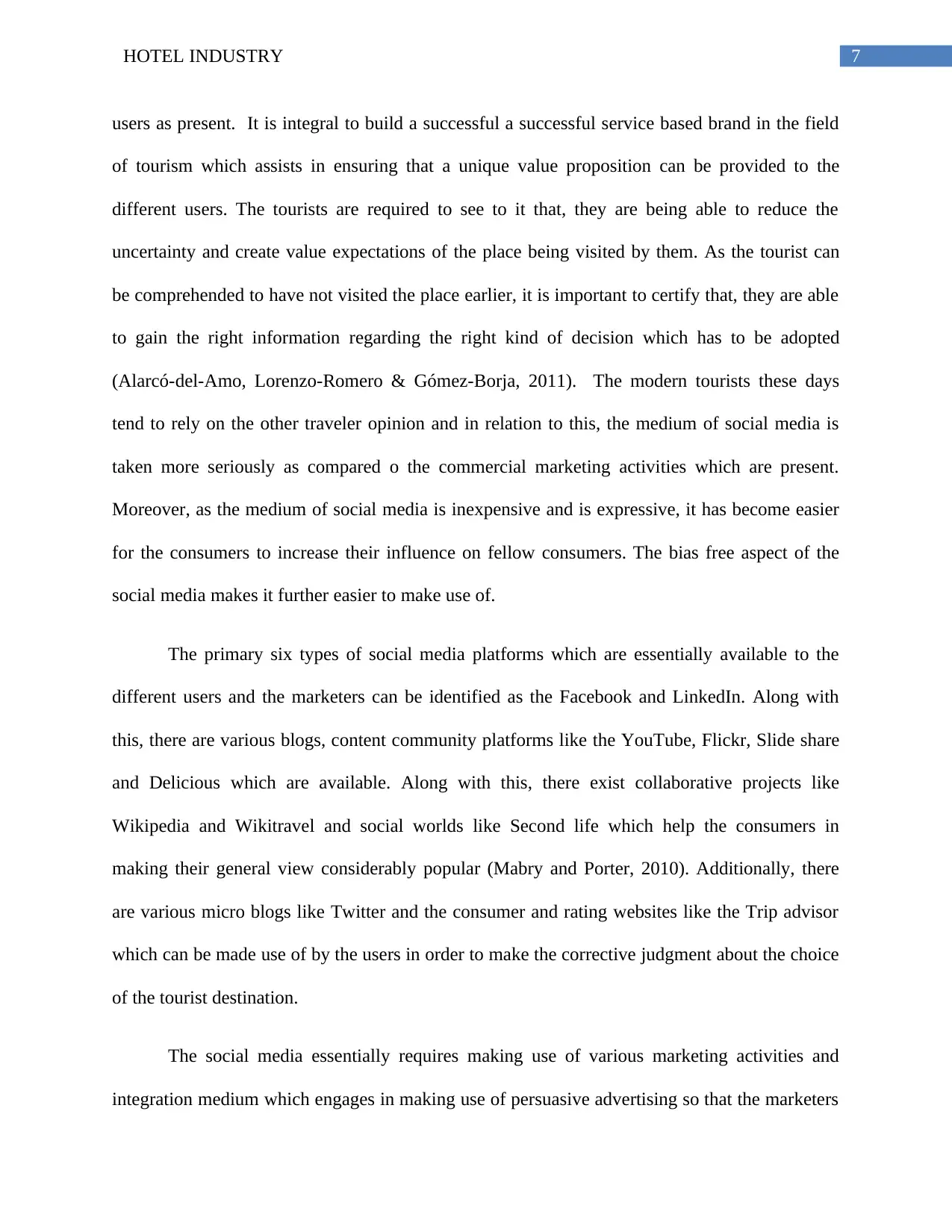
7HOTEL INDUSTRY
users as present. It is integral to build a successful a successful service based brand in the field
of tourism which assists in ensuring that a unique value proposition can be provided to the
different users. The tourists are required to see to it that, they are being able to reduce the
uncertainty and create value expectations of the place being visited by them. As the tourist can
be comprehended to have not visited the place earlier, it is important to certify that, they are able
to gain the right information regarding the right kind of decision which has to be adopted
(Alarcó-del-Amo, Lorenzo-Romero & Gómez-Borja, 2011). The modern tourists these days
tend to rely on the other traveler opinion and in relation to this, the medium of social media is
taken more seriously as compared o the commercial marketing activities which are present.
Moreover, as the medium of social media is inexpensive and is expressive, it has become easier
for the consumers to increase their influence on fellow consumers. The bias free aspect of the
social media makes it further easier to make use of.
The primary six types of social media platforms which are essentially available to the
different users and the marketers can be identified as the Facebook and LinkedIn. Along with
this, there are various blogs, content community platforms like the YouTube, Flickr, Slide share
and Delicious which are available. Along with this, there exist collaborative projects like
Wikipedia and Wikitravel and social worlds like Second life which help the consumers in
making their general view considerably popular (Mabry and Porter, 2010). Additionally, there
are various micro blogs like Twitter and the consumer and rating websites like the Trip advisor
which can be made use of by the users in order to make the corrective judgment about the choice
of the tourist destination.
The social media essentially requires making use of various marketing activities and
integration medium which engages in making use of persuasive advertising so that the marketers
users as present. It is integral to build a successful a successful service based brand in the field
of tourism which assists in ensuring that a unique value proposition can be provided to the
different users. The tourists are required to see to it that, they are being able to reduce the
uncertainty and create value expectations of the place being visited by them. As the tourist can
be comprehended to have not visited the place earlier, it is important to certify that, they are able
to gain the right information regarding the right kind of decision which has to be adopted
(Alarcó-del-Amo, Lorenzo-Romero & Gómez-Borja, 2011). The modern tourists these days
tend to rely on the other traveler opinion and in relation to this, the medium of social media is
taken more seriously as compared o the commercial marketing activities which are present.
Moreover, as the medium of social media is inexpensive and is expressive, it has become easier
for the consumers to increase their influence on fellow consumers. The bias free aspect of the
social media makes it further easier to make use of.
The primary six types of social media platforms which are essentially available to the
different users and the marketers can be identified as the Facebook and LinkedIn. Along with
this, there are various blogs, content community platforms like the YouTube, Flickr, Slide share
and Delicious which are available. Along with this, there exist collaborative projects like
Wikipedia and Wikitravel and social worlds like Second life which help the consumers in
making their general view considerably popular (Mabry and Porter, 2010). Additionally, there
are various micro blogs like Twitter and the consumer and rating websites like the Trip advisor
which can be made use of by the users in order to make the corrective judgment about the choice
of the tourist destination.
The social media essentially requires making use of various marketing activities and
integration medium which engages in making use of persuasive advertising so that the marketers
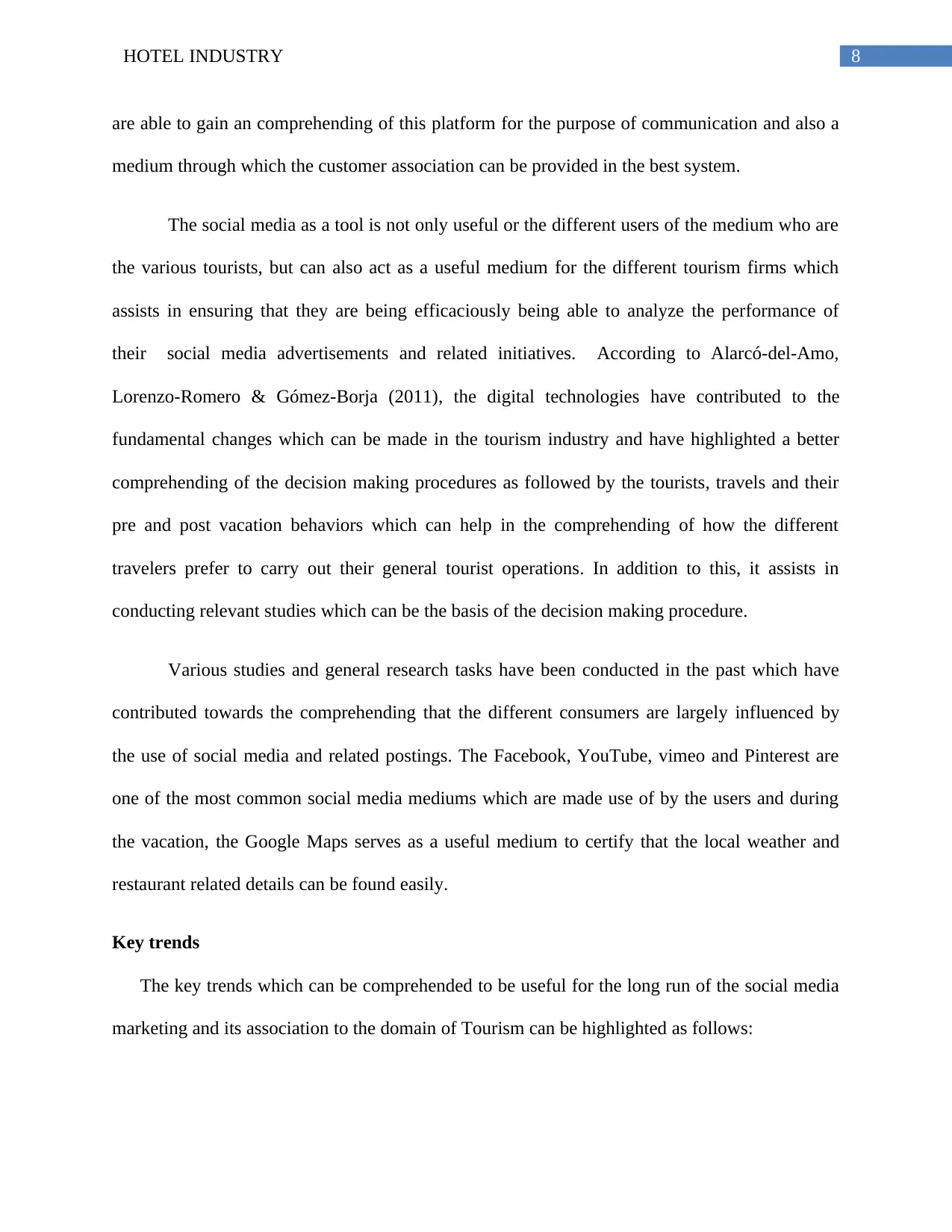
8HOTEL INDUSTRY
are able to gain an comprehending of this platform for the purpose of communication and also a
medium through which the customer association can be provided in the best system.
The social media as a tool is not only useful or the different users of the medium who are
the various tourists, but can also act as a useful medium for the different tourism firms which
assists in ensuring that they are being efficaciously being able to analyze the performance of
their social media advertisements and related initiatives. According to Alarcó-del-Amo,
Lorenzo-Romero & Gómez-Borja (2011), the digital technologies have contributed to the
fundamental changes which can be made in the tourism industry and have highlighted a better
comprehending of the decision making procedures as followed by the tourists, travels and their
pre and post vacation behaviors which can help in the comprehending of how the different
travelers prefer to carry out their general tourist operations. In addition to this, it assists in
conducting relevant studies which can be the basis of the decision making procedure.
Various studies and general research tasks have been conducted in the past which have
contributed towards the comprehending that the different consumers are largely influenced by
the use of social media and related postings. The Facebook, YouTube, vimeo and Pinterest are
one of the most common social media mediums which are made use of by the users and during
the vacation, the Google Maps serves as a useful medium to certify that the local weather and
restaurant related details can be found easily.
Key trends
The key trends which can be comprehended to be useful for the long run of the social media
marketing and its association to the domain of Tourism can be highlighted as follows:
are able to gain an comprehending of this platform for the purpose of communication and also a
medium through which the customer association can be provided in the best system.
The social media as a tool is not only useful or the different users of the medium who are
the various tourists, but can also act as a useful medium for the different tourism firms which
assists in ensuring that they are being efficaciously being able to analyze the performance of
their social media advertisements and related initiatives. According to Alarcó-del-Amo,
Lorenzo-Romero & Gómez-Borja (2011), the digital technologies have contributed to the
fundamental changes which can be made in the tourism industry and have highlighted a better
comprehending of the decision making procedures as followed by the tourists, travels and their
pre and post vacation behaviors which can help in the comprehending of how the different
travelers prefer to carry out their general tourist operations. In addition to this, it assists in
conducting relevant studies which can be the basis of the decision making procedure.
Various studies and general research tasks have been conducted in the past which have
contributed towards the comprehending that the different consumers are largely influenced by
the use of social media and related postings. The Facebook, YouTube, vimeo and Pinterest are
one of the most common social media mediums which are made use of by the users and during
the vacation, the Google Maps serves as a useful medium to certify that the local weather and
restaurant related details can be found easily.
Key trends
The key trends which can be comprehended to be useful for the long run of the social media
marketing and its association to the domain of Tourism can be highlighted as follows:
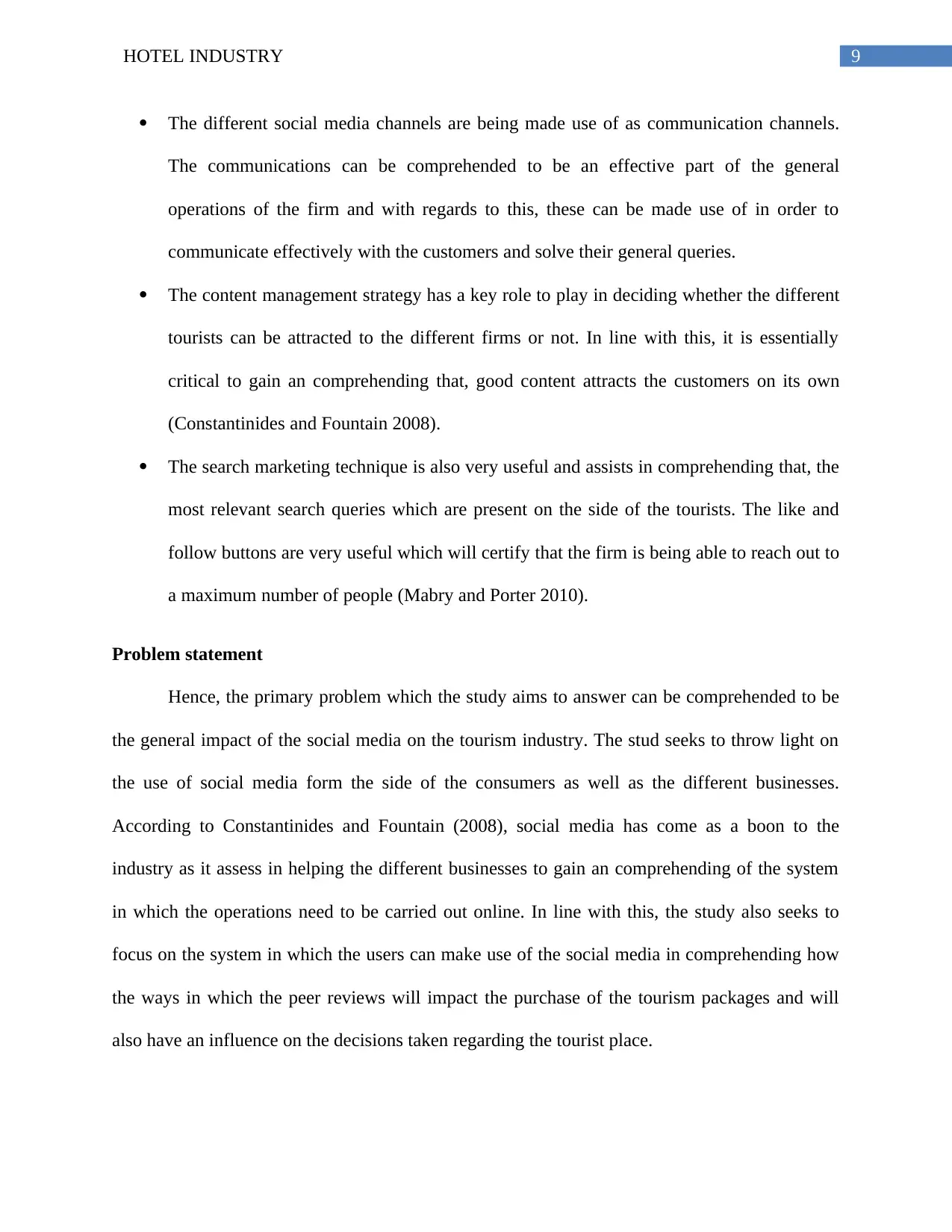
9HOTEL INDUSTRY
The different social media channels are being made use of as communication channels.
The communications can be comprehended to be an effective part of the general
operations of the firm and with regards to this, these can be made use of in order to
communicate effectively with the customers and solve their general queries.
The content management strategy has a key role to play in deciding whether the different
tourists can be attracted to the different firms or not. In line with this, it is essentially
critical to gain an comprehending that, good content attracts the customers on its own
(Constantinides and Fountain 2008).
The search marketing technique is also very useful and assists in comprehending that, the
most relevant search queries which are present on the side of the tourists. The like and
follow buttons are very useful which will certify that the firm is being able to reach out to
a maximum number of people (Mabry and Porter 2010).
Problem statement
Hence, the primary problem which the study aims to answer can be comprehended to be
the general impact of the social media on the tourism industry. The stud seeks to throw light on
the use of social media form the side of the consumers as well as the different businesses.
According to Constantinides and Fountain (2008), social media has come as a boon to the
industry as it assess in helping the different businesses to gain an comprehending of the system
in which the operations need to be carried out online. In line with this, the study also seeks to
focus on the system in which the users can make use of the social media in comprehending how
the ways in which the peer reviews will impact the purchase of the tourism packages and will
also have an influence on the decisions taken regarding the tourist place.
The different social media channels are being made use of as communication channels.
The communications can be comprehended to be an effective part of the general
operations of the firm and with regards to this, these can be made use of in order to
communicate effectively with the customers and solve their general queries.
The content management strategy has a key role to play in deciding whether the different
tourists can be attracted to the different firms or not. In line with this, it is essentially
critical to gain an comprehending that, good content attracts the customers on its own
(Constantinides and Fountain 2008).
The search marketing technique is also very useful and assists in comprehending that, the
most relevant search queries which are present on the side of the tourists. The like and
follow buttons are very useful which will certify that the firm is being able to reach out to
a maximum number of people (Mabry and Porter 2010).
Problem statement
Hence, the primary problem which the study aims to answer can be comprehended to be
the general impact of the social media on the tourism industry. The stud seeks to throw light on
the use of social media form the side of the consumers as well as the different businesses.
According to Constantinides and Fountain (2008), social media has come as a boon to the
industry as it assess in helping the different businesses to gain an comprehending of the system
in which the operations need to be carried out online. In line with this, the study also seeks to
focus on the system in which the users can make use of the social media in comprehending how
the ways in which the peer reviews will impact the purchase of the tourism packages and will
also have an influence on the decisions taken regarding the tourist place.
Secure Best Marks with AI Grader
Need help grading? Try our AI Grader for instant feedback on your assignments.
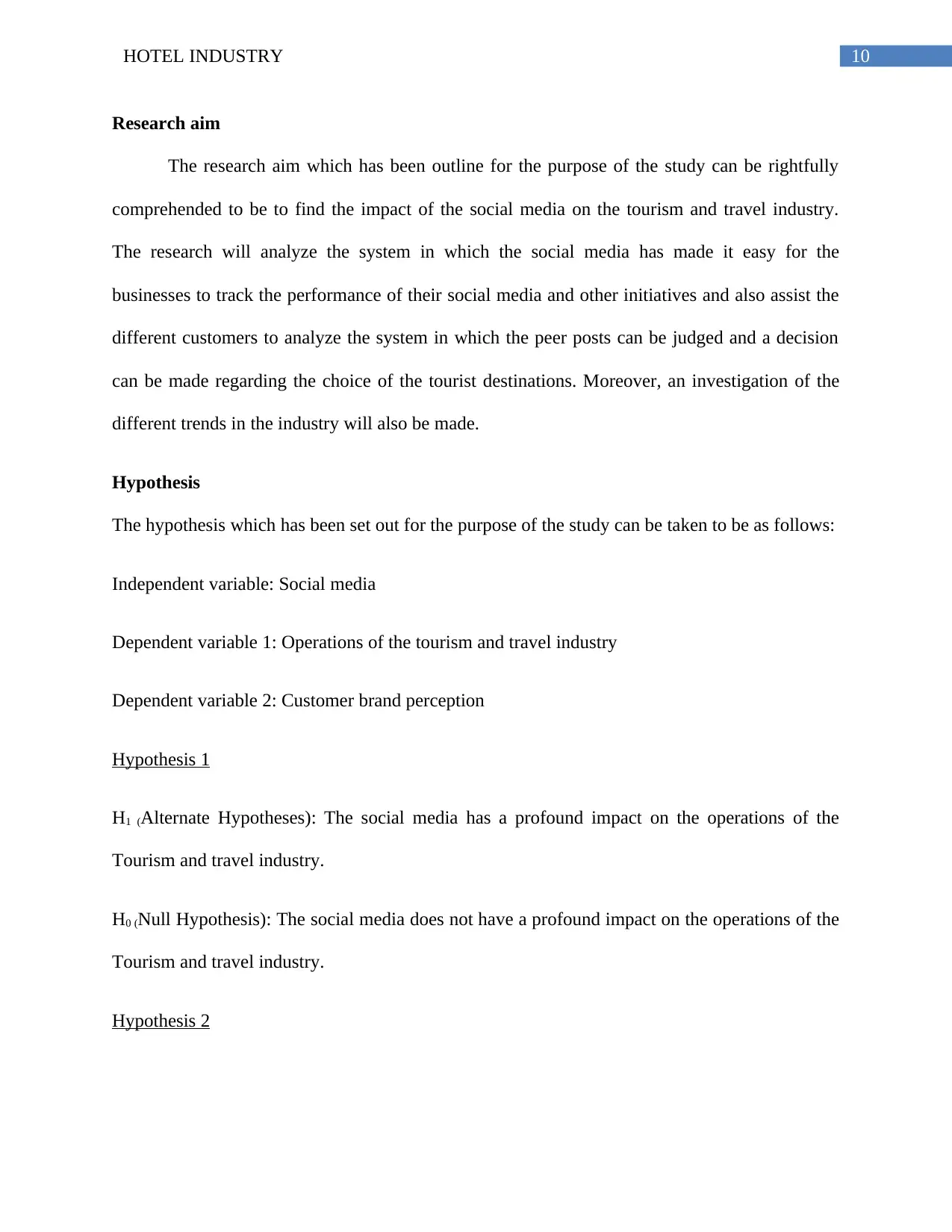
10HOTEL INDUSTRY
Research aim
The research aim which has been outline for the purpose of the study can be rightfully
comprehended to be to find the impact of the social media on the tourism and travel industry.
The research will analyze the system in which the social media has made it easy for the
businesses to track the performance of their social media and other initiatives and also assist the
different customers to analyze the system in which the peer posts can be judged and a decision
can be made regarding the choice of the tourist destinations. Moreover, an investigation of the
different trends in the industry will also be made.
Hypothesis
The hypothesis which has been set out for the purpose of the study can be taken to be as follows:
Independent variable: Social media
Dependent variable 1: Operations of the tourism and travel industry
Dependent variable 2: Customer brand perception
Hypothesis 1
H1 (Alternate Hypotheses): The social media has a profound impact on the operations of the
Tourism and travel industry.
H0 (Null Hypothesis): The social media does not have a profound impact on the operations of the
Tourism and travel industry.
Hypothesis 2
Research aim
The research aim which has been outline for the purpose of the study can be rightfully
comprehended to be to find the impact of the social media on the tourism and travel industry.
The research will analyze the system in which the social media has made it easy for the
businesses to track the performance of their social media and other initiatives and also assist the
different customers to analyze the system in which the peer posts can be judged and a decision
can be made regarding the choice of the tourist destinations. Moreover, an investigation of the
different trends in the industry will also be made.
Hypothesis
The hypothesis which has been set out for the purpose of the study can be taken to be as follows:
Independent variable: Social media
Dependent variable 1: Operations of the tourism and travel industry
Dependent variable 2: Customer brand perception
Hypothesis 1
H1 (Alternate Hypotheses): The social media has a profound impact on the operations of the
Tourism and travel industry.
H0 (Null Hypothesis): The social media does not have a profound impact on the operations of the
Tourism and travel industry.
Hypothesis 2
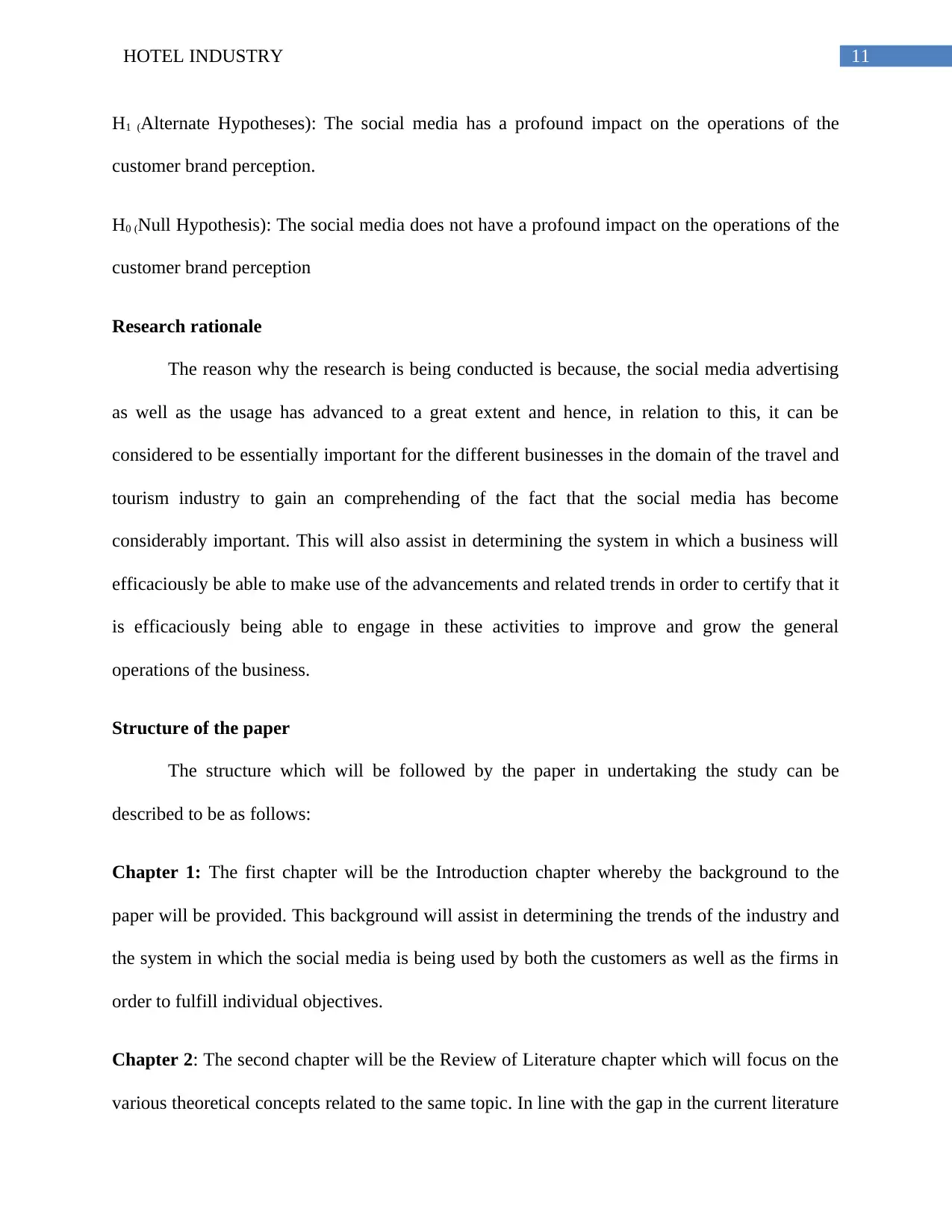
11HOTEL INDUSTRY
H1 (Alternate Hypotheses): The social media has a profound impact on the operations of the
customer brand perception.
H0 (Null Hypothesis): The social media does not have a profound impact on the operations of the
customer brand perception
Research rationale
The reason why the research is being conducted is because, the social media advertising
as well as the usage has advanced to a great extent and hence, in relation to this, it can be
considered to be essentially important for the different businesses in the domain of the travel and
tourism industry to gain an comprehending of the fact that the social media has become
considerably important. This will also assist in determining the system in which a business will
efficaciously be able to make use of the advancements and related trends in order to certify that it
is efficaciously being able to engage in these activities to improve and grow the general
operations of the business.
Structure of the paper
The structure which will be followed by the paper in undertaking the study can be
described to be as follows:
Chapter 1: The first chapter will be the Introduction chapter whereby the background to the
paper will be provided. This background will assist in determining the trends of the industry and
the system in which the social media is being used by both the customers as well as the firms in
order to fulfill individual objectives.
Chapter 2: The second chapter will be the Review of Literature chapter which will focus on the
various theoretical concepts related to the same topic. In line with the gap in the current literature
H1 (Alternate Hypotheses): The social media has a profound impact on the operations of the
customer brand perception.
H0 (Null Hypothesis): The social media does not have a profound impact on the operations of the
customer brand perception
Research rationale
The reason why the research is being conducted is because, the social media advertising
as well as the usage has advanced to a great extent and hence, in relation to this, it can be
considered to be essentially important for the different businesses in the domain of the travel and
tourism industry to gain an comprehending of the fact that the social media has become
considerably important. This will also assist in determining the system in which a business will
efficaciously be able to make use of the advancements and related trends in order to certify that it
is efficaciously being able to engage in these activities to improve and grow the general
operations of the business.
Structure of the paper
The structure which will be followed by the paper in undertaking the study can be
described to be as follows:
Chapter 1: The first chapter will be the Introduction chapter whereby the background to the
paper will be provided. This background will assist in determining the trends of the industry and
the system in which the social media is being used by both the customers as well as the firms in
order to fulfill individual objectives.
Chapter 2: The second chapter will be the Review of Literature chapter which will focus on the
various theoretical concepts related to the same topic. In line with the gap in the current literature
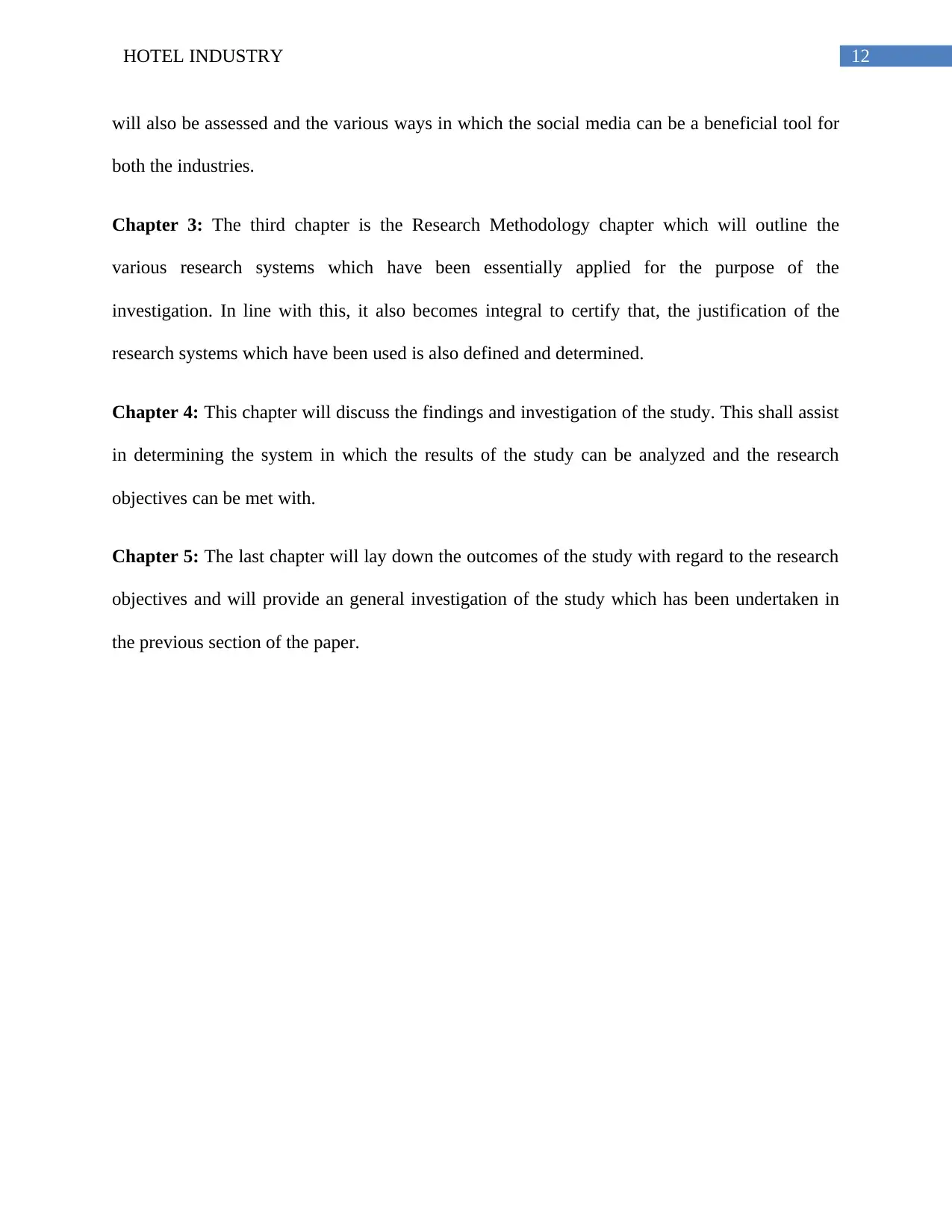
12HOTEL INDUSTRY
will also be assessed and the various ways in which the social media can be a beneficial tool for
both the industries.
Chapter 3: The third chapter is the Research Methodology chapter which will outline the
various research systems which have been essentially applied for the purpose of the
investigation. In line with this, it also becomes integral to certify that, the justification of the
research systems which have been used is also defined and determined.
Chapter 4: This chapter will discuss the findings and investigation of the study. This shall assist
in determining the system in which the results of the study can be analyzed and the research
objectives can be met with.
Chapter 5: The last chapter will lay down the outcomes of the study with regard to the research
objectives and will provide an general investigation of the study which has been undertaken in
the previous section of the paper.
will also be assessed and the various ways in which the social media can be a beneficial tool for
both the industries.
Chapter 3: The third chapter is the Research Methodology chapter which will outline the
various research systems which have been essentially applied for the purpose of the
investigation. In line with this, it also becomes integral to certify that, the justification of the
research systems which have been used is also defined and determined.
Chapter 4: This chapter will discuss the findings and investigation of the study. This shall assist
in determining the system in which the results of the study can be analyzed and the research
objectives can be met with.
Chapter 5: The last chapter will lay down the outcomes of the study with regard to the research
objectives and will provide an general investigation of the study which has been undertaken in
the previous section of the paper.
Paraphrase This Document
Need a fresh take? Get an instant paraphrase of this document with our AI Paraphraser
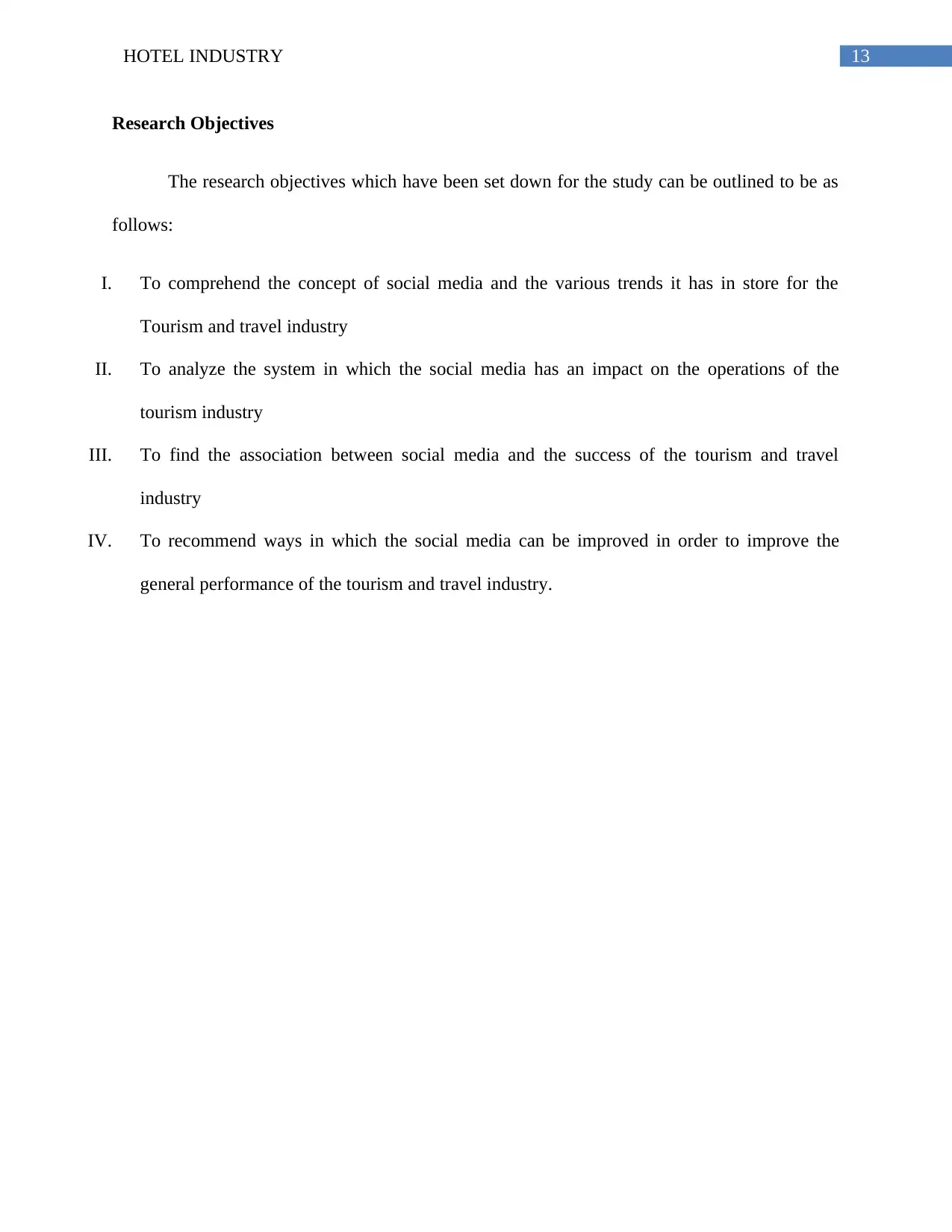
13HOTEL INDUSTRY
Research Objectives
The research objectives which have been set down for the study can be outlined to be as
follows:
I. To comprehend the concept of social media and the various trends it has in store for the
Tourism and travel industry
II. To analyze the system in which the social media has an impact on the operations of the
tourism industry
III. To find the association between social media and the success of the tourism and travel
industry
IV. To recommend ways in which the social media can be improved in order to improve the
general performance of the tourism and travel industry.
Research Objectives
The research objectives which have been set down for the study can be outlined to be as
follows:
I. To comprehend the concept of social media and the various trends it has in store for the
Tourism and travel industry
II. To analyze the system in which the social media has an impact on the operations of the
tourism industry
III. To find the association between social media and the success of the tourism and travel
industry
IV. To recommend ways in which the social media can be improved in order to improve the
general performance of the tourism and travel industry.
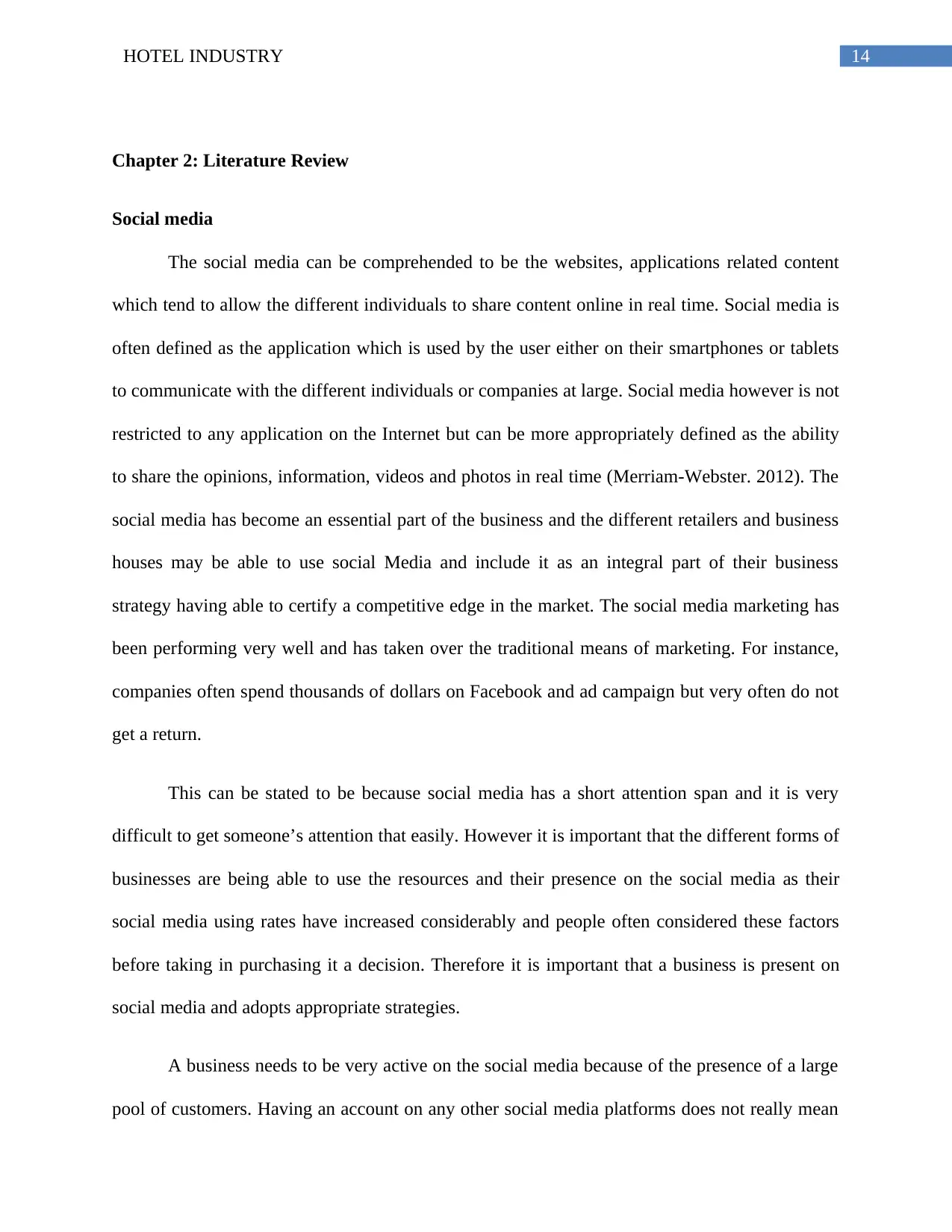
14HOTEL INDUSTRY
Chapter 2: Literature Review
Social media
The social media can be comprehended to be the websites, applications related content
which tend to allow the different individuals to share content online in real time. Social media is
often defined as the application which is used by the user either on their smartphones or tablets
to communicate with the different individuals or companies at large. Social media however is not
restricted to any application on the Internet but can be more appropriately defined as the ability
to share the opinions, information, videos and photos in real time (Merriam-Webster. 2012). The
social media has become an essential part of the business and the different retailers and business
houses may be able to use social Media and include it as an integral part of their business
strategy having able to certify a competitive edge in the market. The social media marketing has
been performing very well and has taken over the traditional means of marketing. For instance,
companies often spend thousands of dollars on Facebook and ad campaign but very often do not
get a return.
This can be stated to be because social media has a short attention span and it is very
difficult to get someone’s attention that easily. However it is important that the different forms of
businesses are being able to use the resources and their presence on the social media as their
social media using rates have increased considerably and people often considered these factors
before taking in purchasing it a decision. Therefore it is important that a business is present on
social media and adopts appropriate strategies.
A business needs to be very active on the social media because of the presence of a large
pool of customers. Having an account on any other social media platforms does not really mean
Chapter 2: Literature Review
Social media
The social media can be comprehended to be the websites, applications related content
which tend to allow the different individuals to share content online in real time. Social media is
often defined as the application which is used by the user either on their smartphones or tablets
to communicate with the different individuals or companies at large. Social media however is not
restricted to any application on the Internet but can be more appropriately defined as the ability
to share the opinions, information, videos and photos in real time (Merriam-Webster. 2012). The
social media has become an essential part of the business and the different retailers and business
houses may be able to use social Media and include it as an integral part of their business
strategy having able to certify a competitive edge in the market. The social media marketing has
been performing very well and has taken over the traditional means of marketing. For instance,
companies often spend thousands of dollars on Facebook and ad campaign but very often do not
get a return.
This can be stated to be because social media has a short attention span and it is very
difficult to get someone’s attention that easily. However it is important that the different forms of
businesses are being able to use the resources and their presence on the social media as their
social media using rates have increased considerably and people often considered these factors
before taking in purchasing it a decision. Therefore it is important that a business is present on
social media and adopts appropriate strategies.
A business needs to be very active on the social media because of the presence of a large
pool of customers. Having an account on any other social media platforms does not really mean
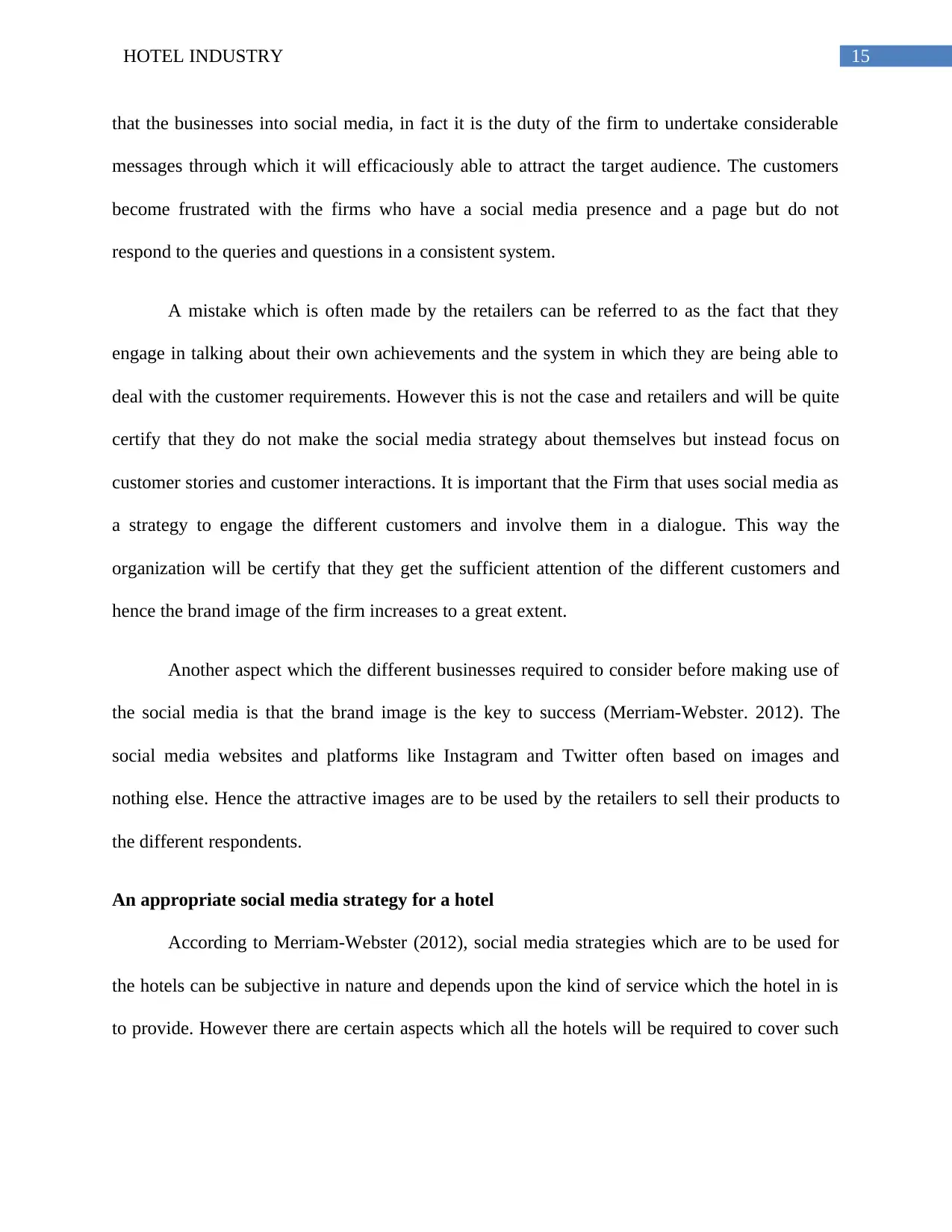
15HOTEL INDUSTRY
that the businesses into social media, in fact it is the duty of the firm to undertake considerable
messages through which it will efficaciously able to attract the target audience. The customers
become frustrated with the firms who have a social media presence and a page but do not
respond to the queries and questions in a consistent system.
A mistake which is often made by the retailers can be referred to as the fact that they
engage in talking about their own achievements and the system in which they are being able to
deal with the customer requirements. However this is not the case and retailers and will be quite
certify that they do not make the social media strategy about themselves but instead focus on
customer stories and customer interactions. It is important that the Firm that uses social media as
a strategy to engage the different customers and involve them in a dialogue. This way the
organization will be certify that they get the sufficient attention of the different customers and
hence the brand image of the firm increases to a great extent.
Another aspect which the different businesses required to consider before making use of
the social media is that the brand image is the key to success (Merriam-Webster. 2012). The
social media websites and platforms like Instagram and Twitter often based on images and
nothing else. Hence the attractive images are to be used by the retailers to sell their products to
the different respondents.
An appropriate social media strategy for a hotel
According to Merriam-Webster (2012), social media strategies which are to be used for
the hotels can be subjective in nature and depends upon the kind of service which the hotel in is
to provide. However there are certain aspects which all the hotels will be required to cover such
that the businesses into social media, in fact it is the duty of the firm to undertake considerable
messages through which it will efficaciously able to attract the target audience. The customers
become frustrated with the firms who have a social media presence and a page but do not
respond to the queries and questions in a consistent system.
A mistake which is often made by the retailers can be referred to as the fact that they
engage in talking about their own achievements and the system in which they are being able to
deal with the customer requirements. However this is not the case and retailers and will be quite
certify that they do not make the social media strategy about themselves but instead focus on
customer stories and customer interactions. It is important that the Firm that uses social media as
a strategy to engage the different customers and involve them in a dialogue. This way the
organization will be certify that they get the sufficient attention of the different customers and
hence the brand image of the firm increases to a great extent.
Another aspect which the different businesses required to consider before making use of
the social media is that the brand image is the key to success (Merriam-Webster. 2012). The
social media websites and platforms like Instagram and Twitter often based on images and
nothing else. Hence the attractive images are to be used by the retailers to sell their products to
the different respondents.
An appropriate social media strategy for a hotel
According to Merriam-Webster (2012), social media strategies which are to be used for
the hotels can be subjective in nature and depends upon the kind of service which the hotel in is
to provide. However there are certain aspects which all the hotels will be required to cover such
Secure Best Marks with AI Grader
Need help grading? Try our AI Grader for instant feedback on your assignments.
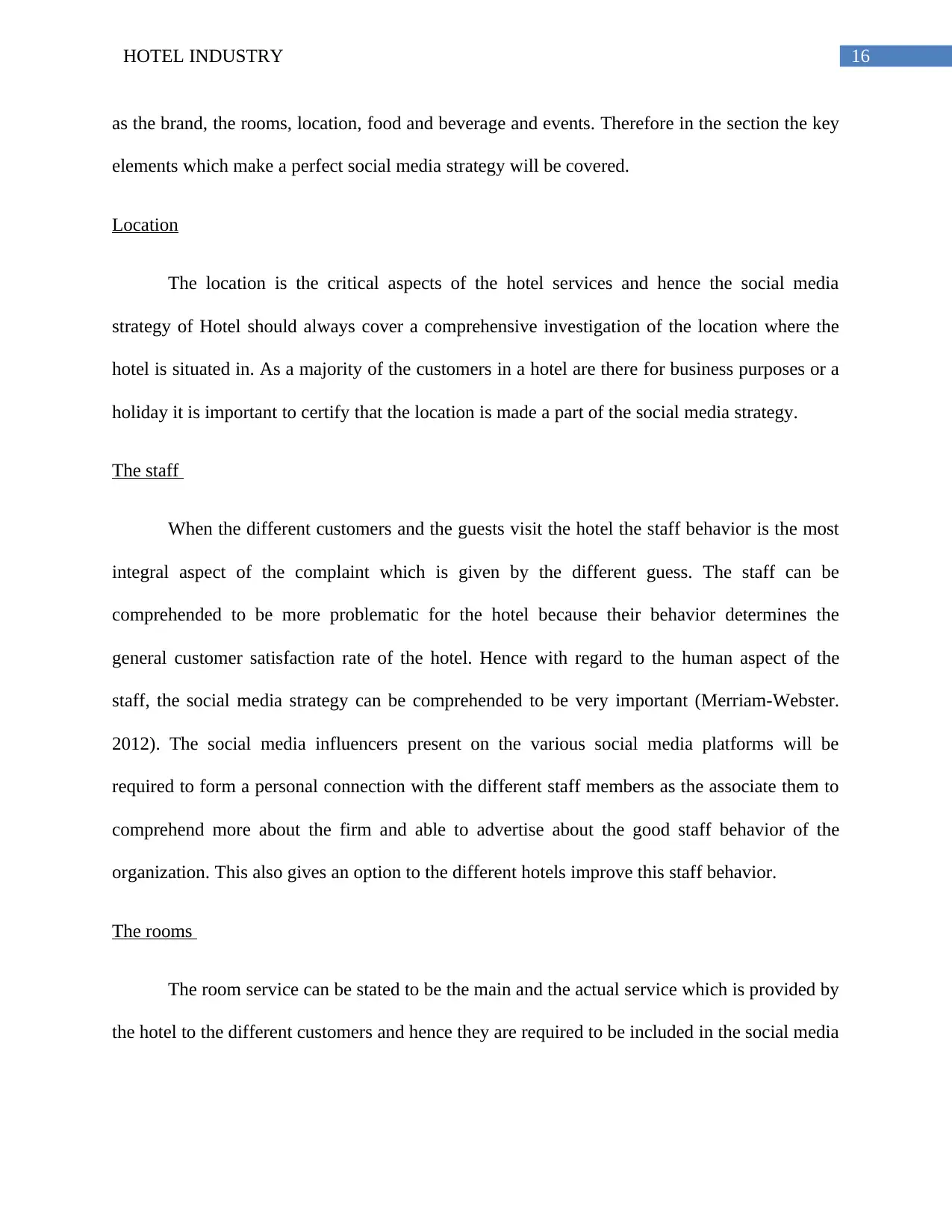
16HOTEL INDUSTRY
as the brand, the rooms, location, food and beverage and events. Therefore in the section the key
elements which make a perfect social media strategy will be covered.
Location
The location is the critical aspects of the hotel services and hence the social media
strategy of Hotel should always cover a comprehensive investigation of the location where the
hotel is situated in. As a majority of the customers in a hotel are there for business purposes or a
holiday it is important to certify that the location is made a part of the social media strategy.
The staff
When the different customers and the guests visit the hotel the staff behavior is the most
integral aspect of the complaint which is given by the different guess. The staff can be
comprehended to be more problematic for the hotel because their behavior determines the
general customer satisfaction rate of the hotel. Hence with regard to the human aspect of the
staff, the social media strategy can be comprehended to be very important (Merriam-Webster.
2012). The social media influencers present on the various social media platforms will be
required to form a personal connection with the different staff members as the associate them to
comprehend more about the firm and able to advertise about the good staff behavior of the
organization. This also gives an option to the different hotels improve this staff behavior.
The rooms
The room service can be stated to be the main and the actual service which is provided by
the hotel to the different customers and hence they are required to be included in the social media
as the brand, the rooms, location, food and beverage and events. Therefore in the section the key
elements which make a perfect social media strategy will be covered.
Location
The location is the critical aspects of the hotel services and hence the social media
strategy of Hotel should always cover a comprehensive investigation of the location where the
hotel is situated in. As a majority of the customers in a hotel are there for business purposes or a
holiday it is important to certify that the location is made a part of the social media strategy.
The staff
When the different customers and the guests visit the hotel the staff behavior is the most
integral aspect of the complaint which is given by the different guess. The staff can be
comprehended to be more problematic for the hotel because their behavior determines the
general customer satisfaction rate of the hotel. Hence with regard to the human aspect of the
staff, the social media strategy can be comprehended to be very important (Merriam-Webster.
2012). The social media influencers present on the various social media platforms will be
required to form a personal connection with the different staff members as the associate them to
comprehend more about the firm and able to advertise about the good staff behavior of the
organization. This also gives an option to the different hotels improve this staff behavior.
The rooms
The room service can be stated to be the main and the actual service which is provided by
the hotel to the different customers and hence they are required to be included in the social media
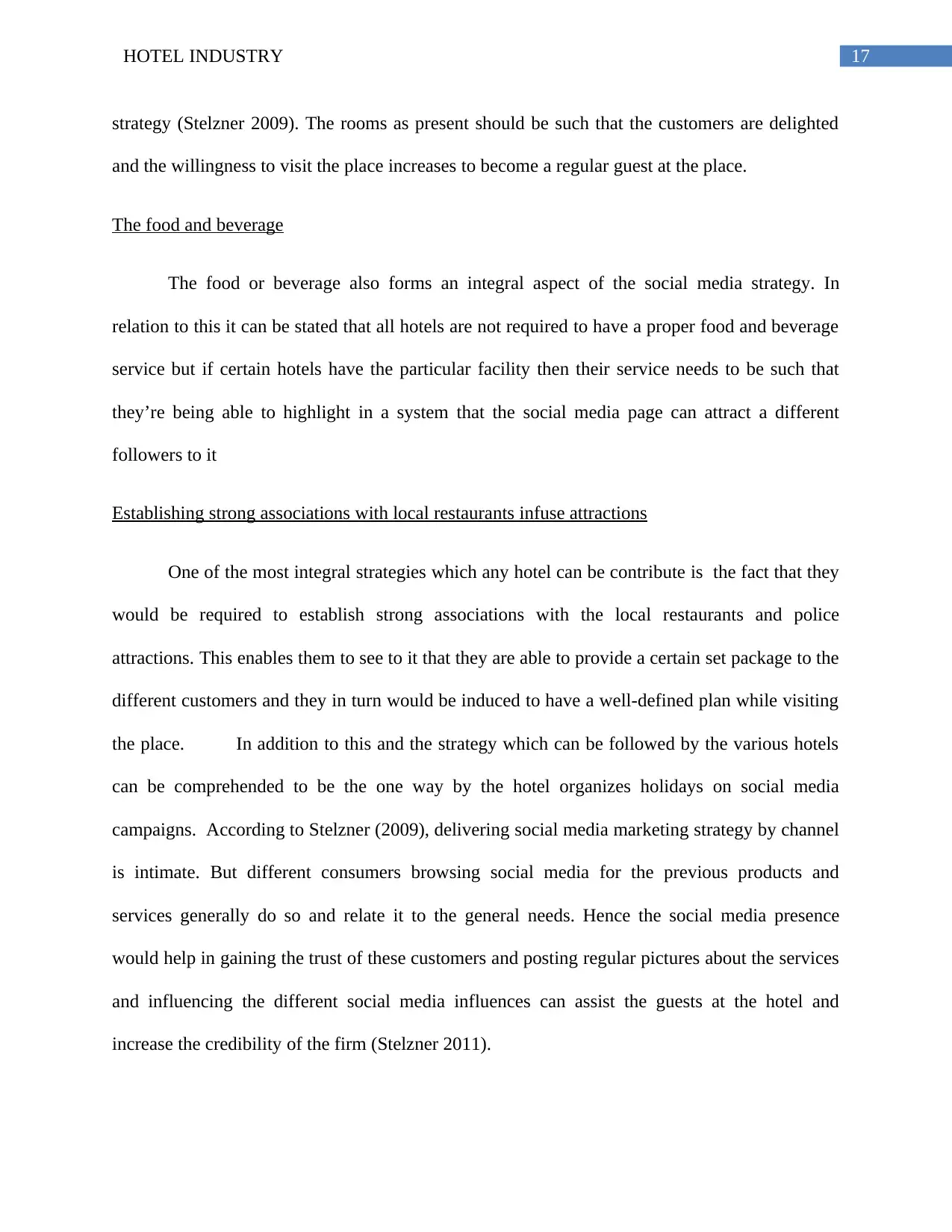
17HOTEL INDUSTRY
strategy (Stelzner 2009). The rooms as present should be such that the customers are delighted
and the willingness to visit the place increases to become a regular guest at the place.
The food and beverage
The food or beverage also forms an integral aspect of the social media strategy. In
relation to this it can be stated that all hotels are not required to have a proper food and beverage
service but if certain hotels have the particular facility then their service needs to be such that
they’re being able to highlight in a system that the social media page can attract a different
followers to it
Establishing strong associations with local restaurants infuse attractions
One of the most integral strategies which any hotel can be contribute is the fact that they
would be required to establish strong associations with the local restaurants and police
attractions. This enables them to see to it that they are able to provide a certain set package to the
different customers and they in turn would be induced to have a well-defined plan while visiting
the place. In addition to this and the strategy which can be followed by the various hotels
can be comprehended to be the one way by the hotel organizes holidays on social media
campaigns. According to Stelzner (2009), delivering social media marketing strategy by channel
is intimate. But different consumers browsing social media for the previous products and
services generally do so and relate it to the general needs. Hence the social media presence
would help in gaining the trust of these customers and posting regular pictures about the services
and influencing the different social media influences can assist the guests at the hotel and
increase the credibility of the firm (Stelzner 2011).
strategy (Stelzner 2009). The rooms as present should be such that the customers are delighted
and the willingness to visit the place increases to become a regular guest at the place.
The food and beverage
The food or beverage also forms an integral aspect of the social media strategy. In
relation to this it can be stated that all hotels are not required to have a proper food and beverage
service but if certain hotels have the particular facility then their service needs to be such that
they’re being able to highlight in a system that the social media page can attract a different
followers to it
Establishing strong associations with local restaurants infuse attractions
One of the most integral strategies which any hotel can be contribute is the fact that they
would be required to establish strong associations with the local restaurants and police
attractions. This enables them to see to it that they are able to provide a certain set package to the
different customers and they in turn would be induced to have a well-defined plan while visiting
the place. In addition to this and the strategy which can be followed by the various hotels
can be comprehended to be the one way by the hotel organizes holidays on social media
campaigns. According to Stelzner (2009), delivering social media marketing strategy by channel
is intimate. But different consumers browsing social media for the previous products and
services generally do so and relate it to the general needs. Hence the social media presence
would help in gaining the trust of these customers and posting regular pictures about the services
and influencing the different social media influences can assist the guests at the hotel and
increase the credibility of the firm (Stelzner 2011).

18HOTEL INDUSTRY
Audience engagement
One of the best strategies which can be applied to different hotels can be comprehended
to be engaging with the audience. As the hotel industry is a service industry it is important that
the hotel is able to engage in the right system with the different audiences and learn about their
opinions. The portals like the trip advisor or the Google reviews are important (Stelzner 2011).
As the customers provide their responses to the different hotels, they should take it as a positive
encouragement to comprehend the areas where they are lagging and formulate formal strategies
to improve the same. In line of this they will not only be able to attract more customers but also
be able to retain their old customers. Hence effective media social media team who are into
managing the social media of the hotel help to provide a successful return to their organization
and certify that the firms being able to engage in a sustainable competitive advantage (The
eMarketer 2011).
An effective social media marketing strategy can help in improving the general
performance of the hotel and thereby ensuring that the visibility of the hotel and the booking
rates also increased to read extent. According to The eMarketer (2011), around 52% of the
Facebook users mention that that the photos of the family and friends of the hotels to visit inspire
them to visit the scene and book the trips. In addition to this as committed social media strategy
needs to have better interaction with the customers as well. Hence as the different customers
check the images and postings of the actual guests when visited the place, having a social media
strategy is realistic as it speaks for itself. The current and potential guests of the hotel can get a
taste of the hospitality and customer service through the Internet about the firm on social media.
In addition to this regular posting also assists in seeing to it that the firm can remain updated and
that the customers are able to gather adequate information about the hotel.
Audience engagement
One of the best strategies which can be applied to different hotels can be comprehended
to be engaging with the audience. As the hotel industry is a service industry it is important that
the hotel is able to engage in the right system with the different audiences and learn about their
opinions. The portals like the trip advisor or the Google reviews are important (Stelzner 2011).
As the customers provide their responses to the different hotels, they should take it as a positive
encouragement to comprehend the areas where they are lagging and formulate formal strategies
to improve the same. In line of this they will not only be able to attract more customers but also
be able to retain their old customers. Hence effective media social media team who are into
managing the social media of the hotel help to provide a successful return to their organization
and certify that the firms being able to engage in a sustainable competitive advantage (The
eMarketer 2011).
An effective social media marketing strategy can help in improving the general
performance of the hotel and thereby ensuring that the visibility of the hotel and the booking
rates also increased to read extent. According to The eMarketer (2011), around 52% of the
Facebook users mention that that the photos of the family and friends of the hotels to visit inspire
them to visit the scene and book the trips. In addition to this as committed social media strategy
needs to have better interaction with the customers as well. Hence as the different customers
check the images and postings of the actual guests when visited the place, having a social media
strategy is realistic as it speaks for itself. The current and potential guests of the hotel can get a
taste of the hospitality and customer service through the Internet about the firm on social media.
In addition to this regular posting also assists in seeing to it that the firm can remain updated and
that the customers are able to gather adequate information about the hotel.
Paraphrase This Document
Need a fresh take? Get an instant paraphrase of this document with our AI Paraphraser
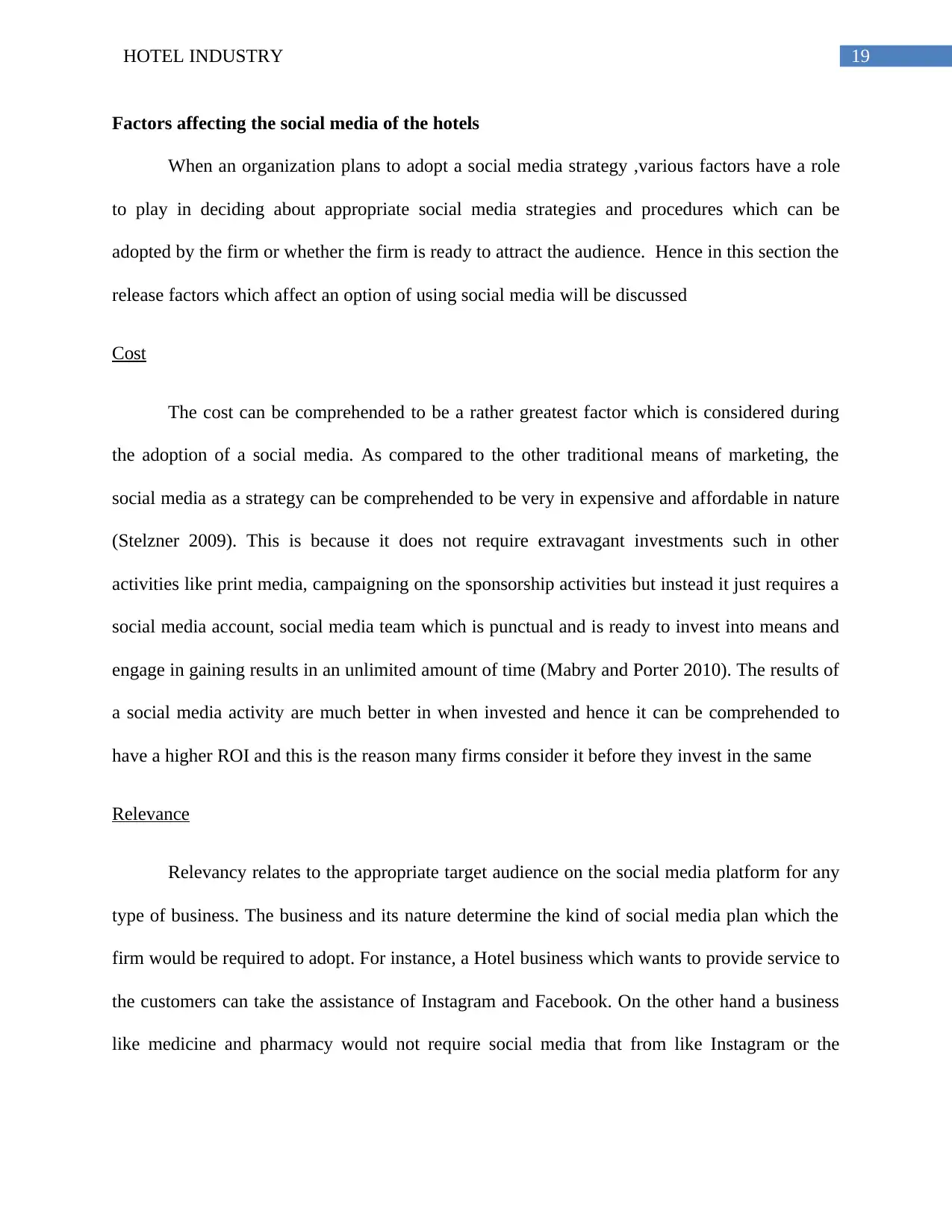
19HOTEL INDUSTRY
Factors affecting the social media of the hotels
When an organization plans to adopt a social media strategy ,various factors have a role
to play in deciding about appropriate social media strategies and procedures which can be
adopted by the firm or whether the firm is ready to attract the audience. Hence in this section the
release factors which affect an option of using social media will be discussed
Cost
The cost can be comprehended to be a rather greatest factor which is considered during
the adoption of a social media. As compared to the other traditional means of marketing, the
social media as a strategy can be comprehended to be very in expensive and affordable in nature
(Stelzner 2009). This is because it does not require extravagant investments such in other
activities like print media, campaigning on the sponsorship activities but instead it just requires a
social media account, social media team which is punctual and is ready to invest into means and
engage in gaining results in an unlimited amount of time (Mabry and Porter 2010). The results of
a social media activity are much better in when invested and hence it can be comprehended to
have a higher ROI and this is the reason many firms consider it before they invest in the same
Relevance
Relevancy relates to the appropriate target audience on the social media platform for any
type of business. The business and its nature determine the kind of social media plan which the
firm would be required to adopt. For instance, a Hotel business which wants to provide service to
the customers can take the assistance of Instagram and Facebook. On the other hand a business
like medicine and pharmacy would not require social media that from like Instagram or the
Factors affecting the social media of the hotels
When an organization plans to adopt a social media strategy ,various factors have a role
to play in deciding about appropriate social media strategies and procedures which can be
adopted by the firm or whether the firm is ready to attract the audience. Hence in this section the
release factors which affect an option of using social media will be discussed
Cost
The cost can be comprehended to be a rather greatest factor which is considered during
the adoption of a social media. As compared to the other traditional means of marketing, the
social media as a strategy can be comprehended to be very in expensive and affordable in nature
(Stelzner 2009). This is because it does not require extravagant investments such in other
activities like print media, campaigning on the sponsorship activities but instead it just requires a
social media account, social media team which is punctual and is ready to invest into means and
engage in gaining results in an unlimited amount of time (Mabry and Porter 2010). The results of
a social media activity are much better in when invested and hence it can be comprehended to
have a higher ROI and this is the reason many firms consider it before they invest in the same
Relevance
Relevancy relates to the appropriate target audience on the social media platform for any
type of business. The business and its nature determine the kind of social media plan which the
firm would be required to adopt. For instance, a Hotel business which wants to provide service to
the customers can take the assistance of Instagram and Facebook. On the other hand a business
like medicine and pharmacy would not require social media that from like Instagram or the
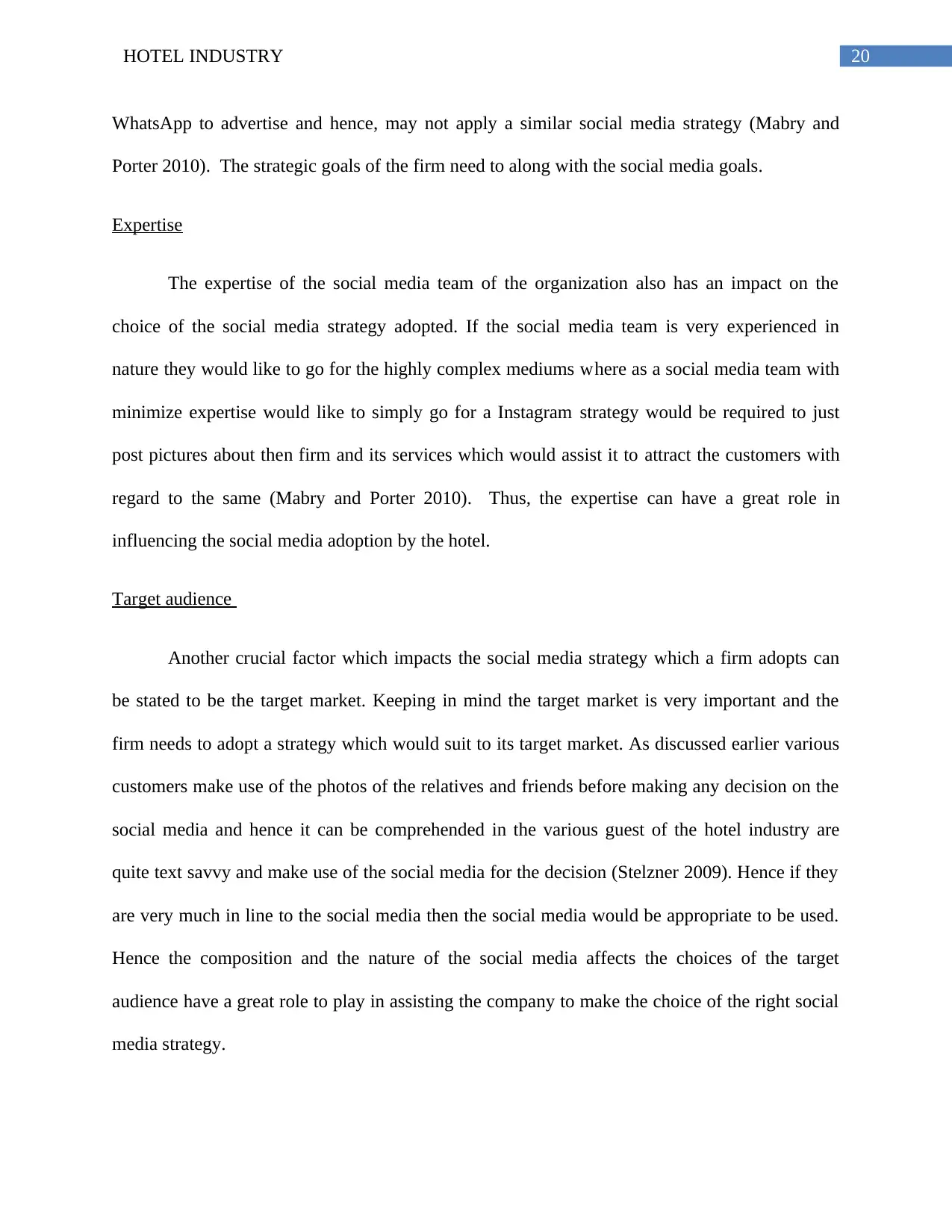
20HOTEL INDUSTRY
WhatsApp to advertise and hence, may not apply a similar social media strategy (Mabry and
Porter 2010). The strategic goals of the firm need to along with the social media goals.
Expertise
The expertise of the social media team of the organization also has an impact on the
choice of the social media strategy adopted. If the social media team is very experienced in
nature they would like to go for the highly complex mediums where as a social media team with
minimize expertise would like to simply go for a Instagram strategy would be required to just
post pictures about then firm and its services which would assist it to attract the customers with
regard to the same (Mabry and Porter 2010). Thus, the expertise can have a great role in
influencing the social media adoption by the hotel.
Target audience
Another crucial factor which impacts the social media strategy which a firm adopts can
be stated to be the target market. Keeping in mind the target market is very important and the
firm needs to adopt a strategy which would suit to its target market. As discussed earlier various
customers make use of the photos of the relatives and friends before making any decision on the
social media and hence it can be comprehended in the various guest of the hotel industry are
quite text savvy and make use of the social media for the decision (Stelzner 2009). Hence if they
are very much in line to the social media then the social media would be appropriate to be used.
Hence the composition and the nature of the social media affects the choices of the target
audience have a great role to play in assisting the company to make the choice of the right social
media strategy.
WhatsApp to advertise and hence, may not apply a similar social media strategy (Mabry and
Porter 2010). The strategic goals of the firm need to along with the social media goals.
Expertise
The expertise of the social media team of the organization also has an impact on the
choice of the social media strategy adopted. If the social media team is very experienced in
nature they would like to go for the highly complex mediums where as a social media team with
minimize expertise would like to simply go for a Instagram strategy would be required to just
post pictures about then firm and its services which would assist it to attract the customers with
regard to the same (Mabry and Porter 2010). Thus, the expertise can have a great role in
influencing the social media adoption by the hotel.
Target audience
Another crucial factor which impacts the social media strategy which a firm adopts can
be stated to be the target market. Keeping in mind the target market is very important and the
firm needs to adopt a strategy which would suit to its target market. As discussed earlier various
customers make use of the photos of the relatives and friends before making any decision on the
social media and hence it can be comprehended in the various guest of the hotel industry are
quite text savvy and make use of the social media for the decision (Stelzner 2009). Hence if they
are very much in line to the social media then the social media would be appropriate to be used.
Hence the composition and the nature of the social media affects the choices of the target
audience have a great role to play in assisting the company to make the choice of the right social
media strategy.
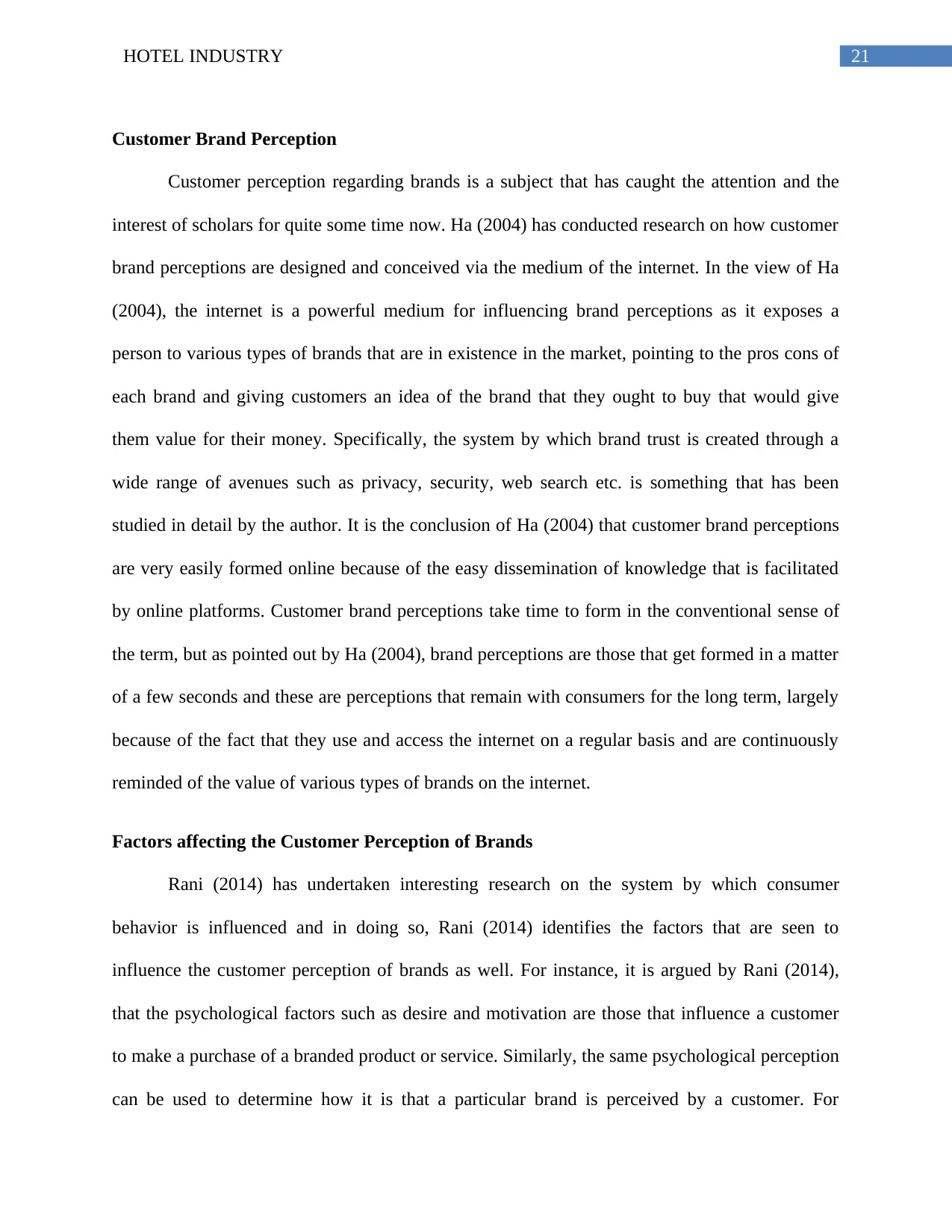
21HOTEL INDUSTRY
Customer Brand Perception
Customer perception regarding brands is a subject that has caught the attention and the
interest of scholars for quite some time now. Ha (2004) has conducted research on how customer
brand perceptions are designed and conceived via the medium of the internet. In the view of Ha
(2004), the internet is a powerful medium for influencing brand perceptions as it exposes a
person to various types of brands that are in existence in the market, pointing to the pros cons of
each brand and giving customers an idea of the brand that they ought to buy that would give
them value for their money. Specifically, the system by which brand trust is created through a
wide range of avenues such as privacy, security, web search etc. is something that has been
studied in detail by the author. It is the conclusion of Ha (2004) that customer brand perceptions
are very easily formed online because of the easy dissemination of knowledge that is facilitated
by online platforms. Customer brand perceptions take time to form in the conventional sense of
the term, but as pointed out by Ha (2004), brand perceptions are those that get formed in a matter
of a few seconds and these are perceptions that remain with consumers for the long term, largely
because of the fact that they use and access the internet on a regular basis and are continuously
reminded of the value of various types of brands on the internet.
Factors affecting the Customer Perception of Brands
Rani (2014) has undertaken interesting research on the system by which consumer
behavior is influenced and in doing so, Rani (2014) identifies the factors that are seen to
influence the customer perception of brands as well. For instance, it is argued by Rani (2014),
that the psychological factors such as desire and motivation are those that influence a customer
to make a purchase of a branded product or service. Similarly, the same psychological perception
can be used to determine how it is that a particular brand is perceived by a customer. For
Customer Brand Perception
Customer perception regarding brands is a subject that has caught the attention and the
interest of scholars for quite some time now. Ha (2004) has conducted research on how customer
brand perceptions are designed and conceived via the medium of the internet. In the view of Ha
(2004), the internet is a powerful medium for influencing brand perceptions as it exposes a
person to various types of brands that are in existence in the market, pointing to the pros cons of
each brand and giving customers an idea of the brand that they ought to buy that would give
them value for their money. Specifically, the system by which brand trust is created through a
wide range of avenues such as privacy, security, web search etc. is something that has been
studied in detail by the author. It is the conclusion of Ha (2004) that customer brand perceptions
are very easily formed online because of the easy dissemination of knowledge that is facilitated
by online platforms. Customer brand perceptions take time to form in the conventional sense of
the term, but as pointed out by Ha (2004), brand perceptions are those that get formed in a matter
of a few seconds and these are perceptions that remain with consumers for the long term, largely
because of the fact that they use and access the internet on a regular basis and are continuously
reminded of the value of various types of brands on the internet.
Factors affecting the Customer Perception of Brands
Rani (2014) has undertaken interesting research on the system by which consumer
behavior is influenced and in doing so, Rani (2014) identifies the factors that are seen to
influence the customer perception of brands as well. For instance, it is argued by Rani (2014),
that the psychological factors such as desire and motivation are those that influence a customer
to make a purchase of a branded product or service. Similarly, the same psychological perception
can be used to determine how it is that a particular brand is perceived by a customer. For
Secure Best Marks with AI Grader
Need help grading? Try our AI Grader for instant feedback on your assignments.
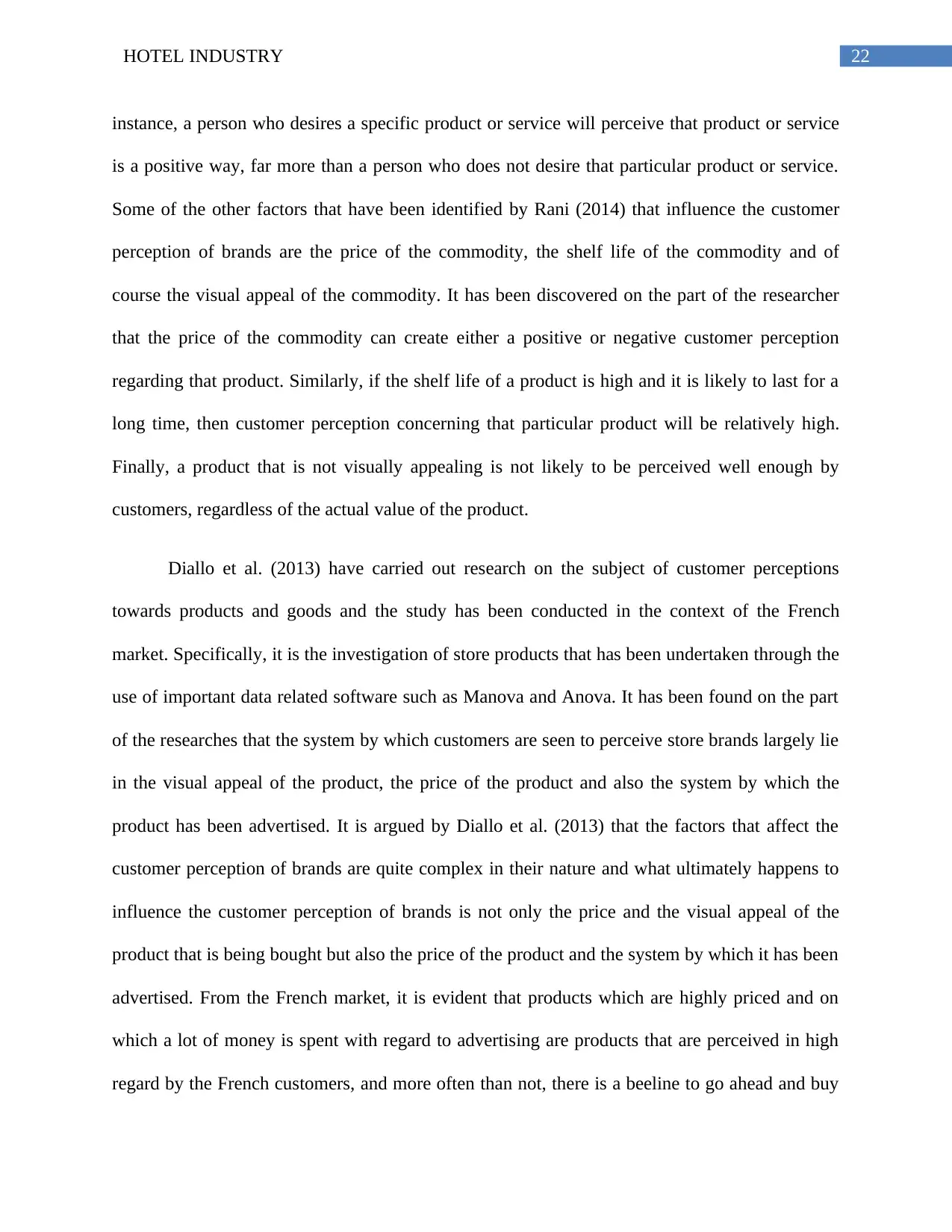
22HOTEL INDUSTRY
instance, a person who desires a specific product or service will perceive that product or service
is a positive way, far more than a person who does not desire that particular product or service.
Some of the other factors that have been identified by Rani (2014) that influence the customer
perception of brands are the price of the commodity, the shelf life of the commodity and of
course the visual appeal of the commodity. It has been discovered on the part of the researcher
that the price of the commodity can create either a positive or negative customer perception
regarding that product. Similarly, if the shelf life of a product is high and it is likely to last for a
long time, then customer perception concerning that particular product will be relatively high.
Finally, a product that is not visually appealing is not likely to be perceived well enough by
customers, regardless of the actual value of the product.
Diallo et al. (2013) have carried out research on the subject of customer perceptions
towards products and goods and the study has been conducted in the context of the French
market. Specifically, it is the investigation of store products that has been undertaken through the
use of important data related software such as Manova and Anova. It has been found on the part
of the researches that the system by which customers are seen to perceive store brands largely lie
in the visual appeal of the product, the price of the product and also the system by which the
product has been advertised. It is argued by Diallo et al. (2013) that the factors that affect the
customer perception of brands are quite complex in their nature and what ultimately happens to
influence the customer perception of brands is not only the price and the visual appeal of the
product that is being bought but also the price of the product and the system by which it has been
advertised. From the French market, it is evident that products which are highly priced and on
which a lot of money is spent with regard to advertising are products that are perceived in high
regard by the French customers, and more often than not, there is a beeline to go ahead and buy
instance, a person who desires a specific product or service will perceive that product or service
is a positive way, far more than a person who does not desire that particular product or service.
Some of the other factors that have been identified by Rani (2014) that influence the customer
perception of brands are the price of the commodity, the shelf life of the commodity and of
course the visual appeal of the commodity. It has been discovered on the part of the researcher
that the price of the commodity can create either a positive or negative customer perception
regarding that product. Similarly, if the shelf life of a product is high and it is likely to last for a
long time, then customer perception concerning that particular product will be relatively high.
Finally, a product that is not visually appealing is not likely to be perceived well enough by
customers, regardless of the actual value of the product.
Diallo et al. (2013) have carried out research on the subject of customer perceptions
towards products and goods and the study has been conducted in the context of the French
market. Specifically, it is the investigation of store products that has been undertaken through the
use of important data related software such as Manova and Anova. It has been found on the part
of the researches that the system by which customers are seen to perceive store brands largely lie
in the visual appeal of the product, the price of the product and also the system by which the
product has been advertised. It is argued by Diallo et al. (2013) that the factors that affect the
customer perception of brands are quite complex in their nature and what ultimately happens to
influence the customer perception of brands is not only the price and the visual appeal of the
product that is being bought but also the price of the product and the system by which it has been
advertised. From the French market, it is evident that products which are highly priced and on
which a lot of money is spent with regard to advertising are products that are perceived in high
regard by the French customers, and more often than not, there is a beeline to go ahead and buy
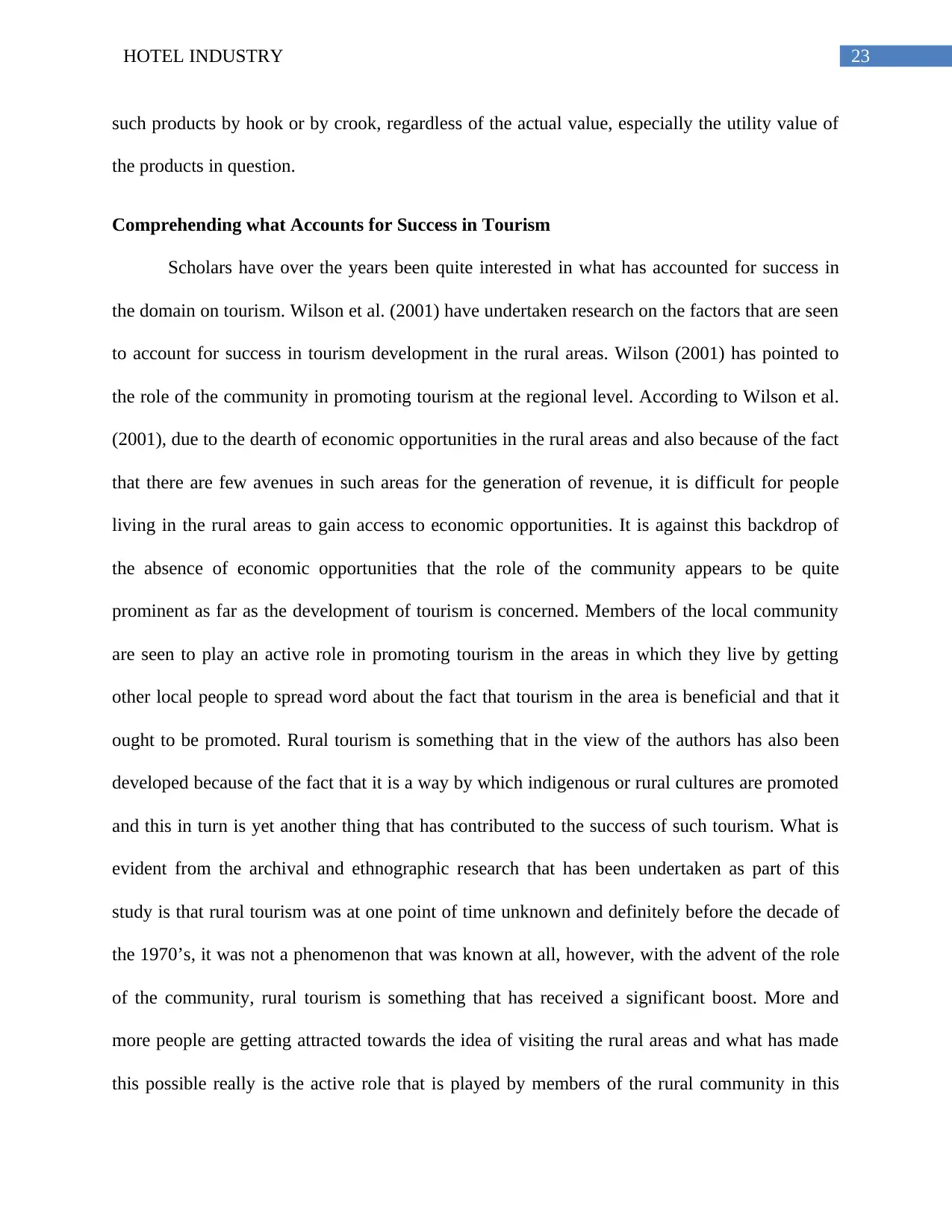
23HOTEL INDUSTRY
such products by hook or by crook, regardless of the actual value, especially the utility value of
the products in question.
Comprehending what Accounts for Success in Tourism
Scholars have over the years been quite interested in what has accounted for success in
the domain on tourism. Wilson et al. (2001) have undertaken research on the factors that are seen
to account for success in tourism development in the rural areas. Wilson (2001) has pointed to
the role of the community in promoting tourism at the regional level. According to Wilson et al.
(2001), due to the dearth of economic opportunities in the rural areas and also because of the fact
that there are few avenues in such areas for the generation of revenue, it is difficult for people
living in the rural areas to gain access to economic opportunities. It is against this backdrop of
the absence of economic opportunities that the role of the community appears to be quite
prominent as far as the development of tourism is concerned. Members of the local community
are seen to play an active role in promoting tourism in the areas in which they live by getting
other local people to spread word about the fact that tourism in the area is beneficial and that it
ought to be promoted. Rural tourism is something that in the view of the authors has also been
developed because of the fact that it is a way by which indigenous or rural cultures are promoted
and this in turn is yet another thing that has contributed to the success of such tourism. What is
evident from the archival and ethnographic research that has been undertaken as part of this
study is that rural tourism was at one point of time unknown and definitely before the decade of
the 1970’s, it was not a phenomenon that was known at all, however, with the advent of the role
of the community, rural tourism is something that has received a significant boost. More and
more people are getting attracted towards the idea of visiting the rural areas and what has made
this possible really is the active role that is played by members of the rural community in this
such products by hook or by crook, regardless of the actual value, especially the utility value of
the products in question.
Comprehending what Accounts for Success in Tourism
Scholars have over the years been quite interested in what has accounted for success in
the domain on tourism. Wilson et al. (2001) have undertaken research on the factors that are seen
to account for success in tourism development in the rural areas. Wilson (2001) has pointed to
the role of the community in promoting tourism at the regional level. According to Wilson et al.
(2001), due to the dearth of economic opportunities in the rural areas and also because of the fact
that there are few avenues in such areas for the generation of revenue, it is difficult for people
living in the rural areas to gain access to economic opportunities. It is against this backdrop of
the absence of economic opportunities that the role of the community appears to be quite
prominent as far as the development of tourism is concerned. Members of the local community
are seen to play an active role in promoting tourism in the areas in which they live by getting
other local people to spread word about the fact that tourism in the area is beneficial and that it
ought to be promoted. Rural tourism is something that in the view of the authors has also been
developed because of the fact that it is a way by which indigenous or rural cultures are promoted
and this in turn is yet another thing that has contributed to the success of such tourism. What is
evident from the archival and ethnographic research that has been undertaken as part of this
study is that rural tourism was at one point of time unknown and definitely before the decade of
the 1970’s, it was not a phenomenon that was known at all, however, with the advent of the role
of the community, rural tourism is something that has received a significant boost. More and
more people are getting attracted towards the idea of visiting the rural areas and what has made
this possible really is the active role that is played by members of the rural community in this
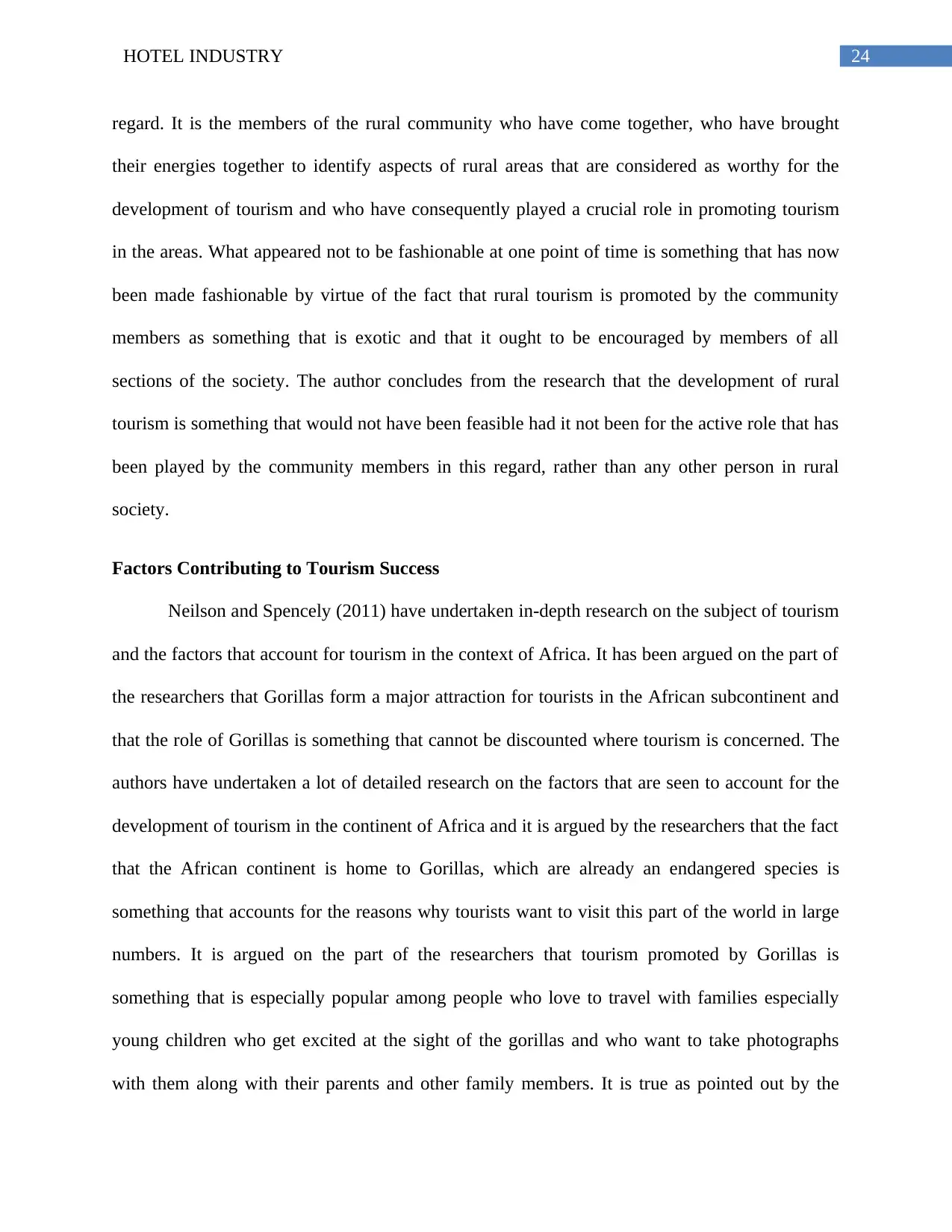
24HOTEL INDUSTRY
regard. It is the members of the rural community who have come together, who have brought
their energies together to identify aspects of rural areas that are considered as worthy for the
development of tourism and who have consequently played a crucial role in promoting tourism
in the areas. What appeared not to be fashionable at one point of time is something that has now
been made fashionable by virtue of the fact that rural tourism is promoted by the community
members as something that is exotic and that it ought to be encouraged by members of all
sections of the society. The author concludes from the research that the development of rural
tourism is something that would not have been feasible had it not been for the active role that has
been played by the community members in this regard, rather than any other person in rural
society.
Factors Contributing to Tourism Success
Neilson and Spencely (2011) have undertaken in-depth research on the subject of tourism
and the factors that account for tourism in the context of Africa. It has been argued on the part of
the researchers that Gorillas form a major attraction for tourists in the African subcontinent and
that the role of Gorillas is something that cannot be discounted where tourism is concerned. The
authors have undertaken a lot of detailed research on the factors that are seen to account for the
development of tourism in the continent of Africa and it is argued by the researchers that the fact
that the African continent is home to Gorillas, which are already an endangered species is
something that accounts for the reasons why tourists want to visit this part of the world in large
numbers. It is argued on the part of the researchers that tourism promoted by Gorillas is
something that is especially popular among people who love to travel with families especially
young children who get excited at the sight of the gorillas and who want to take photographs
with them along with their parents and other family members. It is true as pointed out by the
regard. It is the members of the rural community who have come together, who have brought
their energies together to identify aspects of rural areas that are considered as worthy for the
development of tourism and who have consequently played a crucial role in promoting tourism
in the areas. What appeared not to be fashionable at one point of time is something that has now
been made fashionable by virtue of the fact that rural tourism is promoted by the community
members as something that is exotic and that it ought to be encouraged by members of all
sections of the society. The author concludes from the research that the development of rural
tourism is something that would not have been feasible had it not been for the active role that has
been played by the community members in this regard, rather than any other person in rural
society.
Factors Contributing to Tourism Success
Neilson and Spencely (2011) have undertaken in-depth research on the subject of tourism
and the factors that account for tourism in the context of Africa. It has been argued on the part of
the researchers that Gorillas form a major attraction for tourists in the African subcontinent and
that the role of Gorillas is something that cannot be discounted where tourism is concerned. The
authors have undertaken a lot of detailed research on the factors that are seen to account for the
development of tourism in the continent of Africa and it is argued by the researchers that the fact
that the African continent is home to Gorillas, which are already an endangered species is
something that accounts for the reasons why tourists want to visit this part of the world in large
numbers. It is argued on the part of the researchers that tourism promoted by Gorillas is
something that is especially popular among people who love to travel with families especially
young children who get excited at the sight of the gorillas and who want to take photographs
with them along with their parents and other family members. It is true as pointed out by the
Paraphrase This Document
Need a fresh take? Get an instant paraphrase of this document with our AI Paraphraser
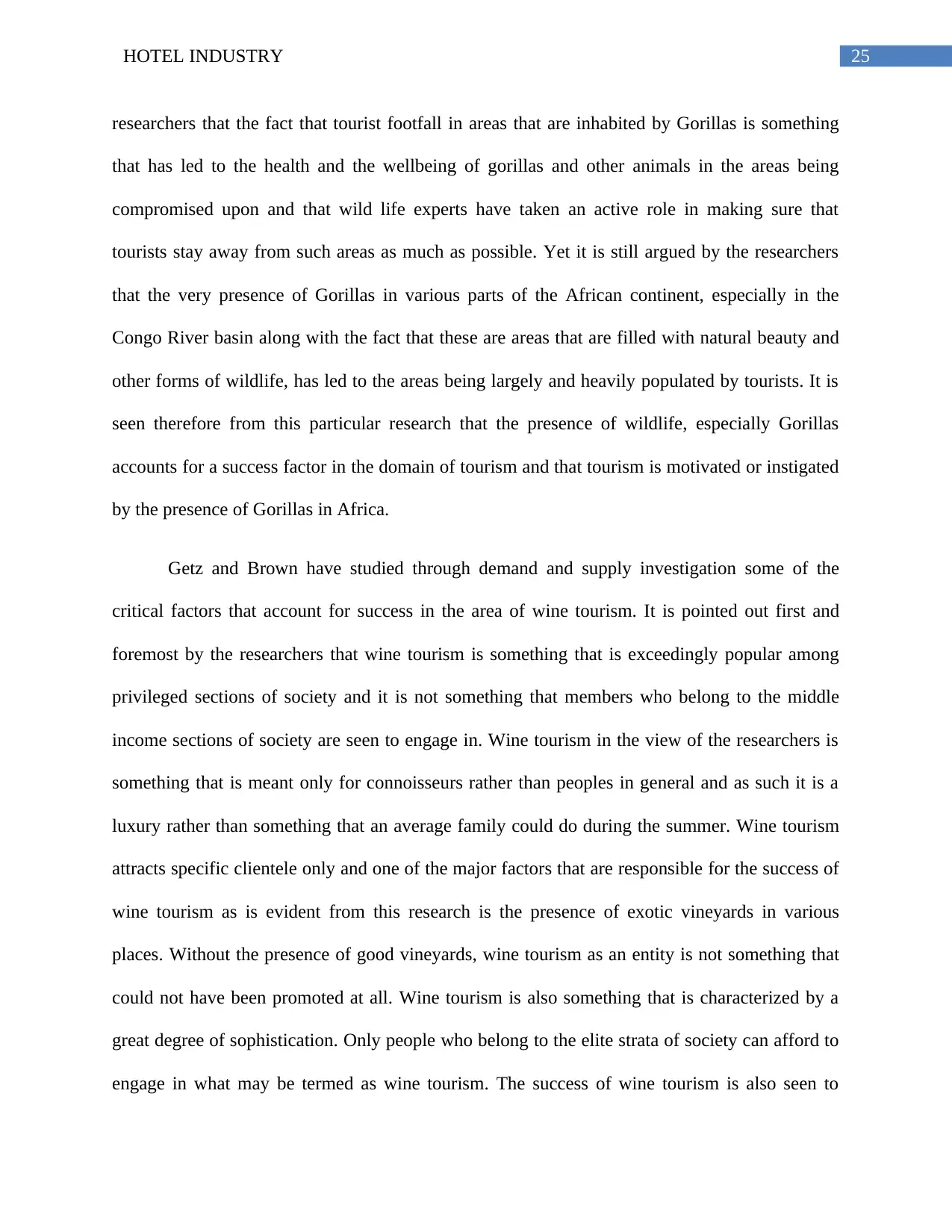
25HOTEL INDUSTRY
researchers that the fact that tourist footfall in areas that are inhabited by Gorillas is something
that has led to the health and the wellbeing of gorillas and other animals in the areas being
compromised upon and that wild life experts have taken an active role in making sure that
tourists stay away from such areas as much as possible. Yet it is still argued by the researchers
that the very presence of Gorillas in various parts of the African continent, especially in the
Congo River basin along with the fact that these are areas that are filled with natural beauty and
other forms of wildlife, has led to the areas being largely and heavily populated by tourists. It is
seen therefore from this particular research that the presence of wildlife, especially Gorillas
accounts for a success factor in the domain of tourism and that tourism is motivated or instigated
by the presence of Gorillas in Africa.
Getz and Brown have studied through demand and supply investigation some of the
critical factors that account for success in the area of wine tourism. It is pointed out first and
foremost by the researchers that wine tourism is something that is exceedingly popular among
privileged sections of society and it is not something that members who belong to the middle
income sections of society are seen to engage in. Wine tourism in the view of the researchers is
something that is meant only for connoisseurs rather than peoples in general and as such it is a
luxury rather than something that an average family could do during the summer. Wine tourism
attracts specific clientele only and one of the major factors that are responsible for the success of
wine tourism as is evident from this research is the presence of exotic vineyards in various
places. Without the presence of good vineyards, wine tourism as an entity is not something that
could not have been promoted at all. Wine tourism is also something that is characterized by a
great degree of sophistication. Only people who belong to the elite strata of society can afford to
engage in what may be termed as wine tourism. The success of wine tourism is also seen to
researchers that the fact that tourist footfall in areas that are inhabited by Gorillas is something
that has led to the health and the wellbeing of gorillas and other animals in the areas being
compromised upon and that wild life experts have taken an active role in making sure that
tourists stay away from such areas as much as possible. Yet it is still argued by the researchers
that the very presence of Gorillas in various parts of the African continent, especially in the
Congo River basin along with the fact that these are areas that are filled with natural beauty and
other forms of wildlife, has led to the areas being largely and heavily populated by tourists. It is
seen therefore from this particular research that the presence of wildlife, especially Gorillas
accounts for a success factor in the domain of tourism and that tourism is motivated or instigated
by the presence of Gorillas in Africa.
Getz and Brown have studied through demand and supply investigation some of the
critical factors that account for success in the area of wine tourism. It is pointed out first and
foremost by the researchers that wine tourism is something that is exceedingly popular among
privileged sections of society and it is not something that members who belong to the middle
income sections of society are seen to engage in. Wine tourism in the view of the researchers is
something that is meant only for connoisseurs rather than peoples in general and as such it is a
luxury rather than something that an average family could do during the summer. Wine tourism
attracts specific clientele only and one of the major factors that are responsible for the success of
wine tourism as is evident from this research is the presence of exotic vineyards in various
places. Without the presence of good vineyards, wine tourism as an entity is not something that
could not have been promoted at all. Wine tourism is also something that is characterized by a
great degree of sophistication. Only people who belong to the elite strata of society can afford to
engage in what may be termed as wine tourism. The success of wine tourism is also seen to
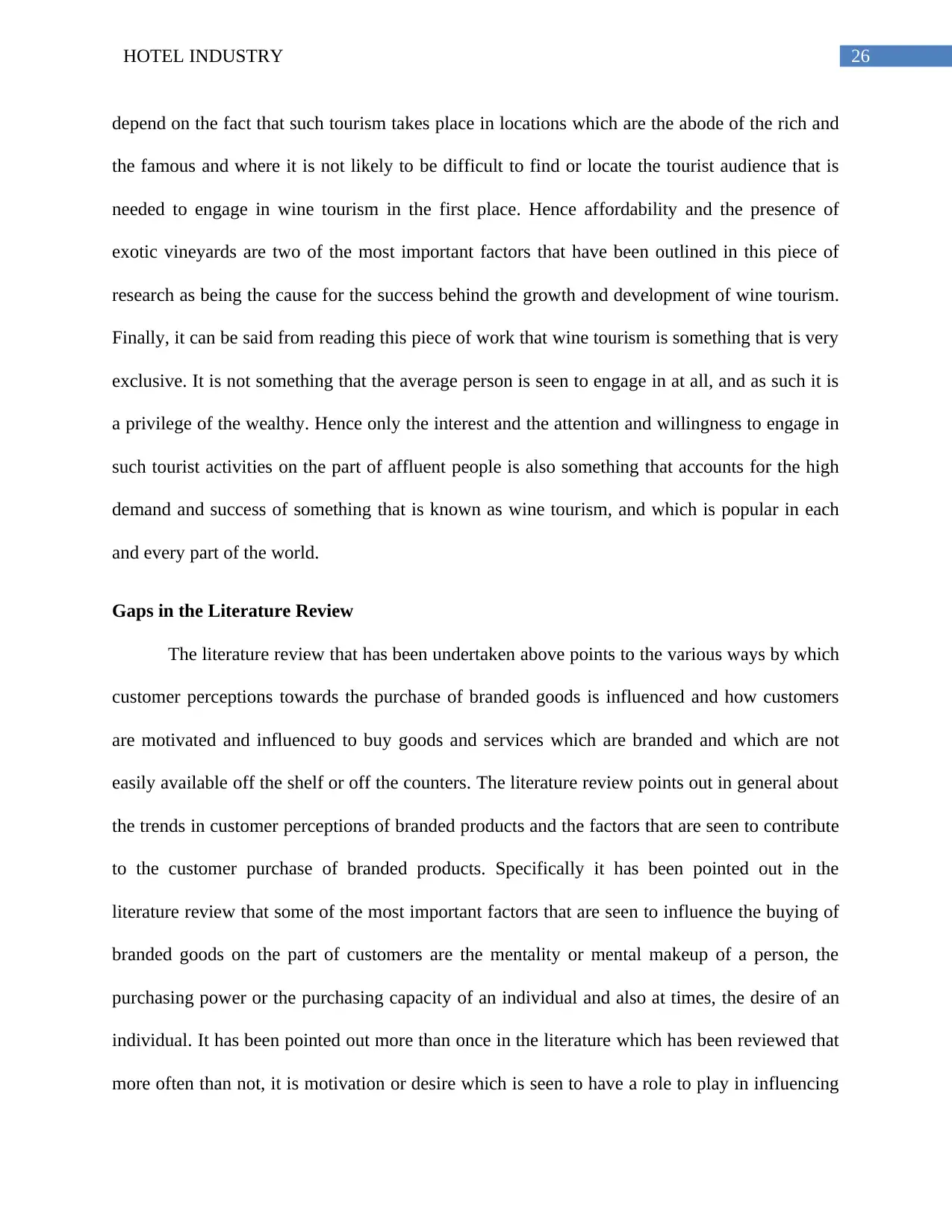
26HOTEL INDUSTRY
depend on the fact that such tourism takes place in locations which are the abode of the rich and
the famous and where it is not likely to be difficult to find or locate the tourist audience that is
needed to engage in wine tourism in the first place. Hence affordability and the presence of
exotic vineyards are two of the most important factors that have been outlined in this piece of
research as being the cause for the success behind the growth and development of wine tourism.
Finally, it can be said from reading this piece of work that wine tourism is something that is very
exclusive. It is not something that the average person is seen to engage in at all, and as such it is
a privilege of the wealthy. Hence only the interest and the attention and willingness to engage in
such tourist activities on the part of affluent people is also something that accounts for the high
demand and success of something that is known as wine tourism, and which is popular in each
and every part of the world.
Gaps in the Literature Review
The literature review that has been undertaken above points to the various ways by which
customer perceptions towards the purchase of branded goods is influenced and how customers
are motivated and influenced to buy goods and services which are branded and which are not
easily available off the shelf or off the counters. The literature review points out in general about
the trends in customer perceptions of branded products and the factors that are seen to contribute
to the customer purchase of branded products. Specifically it has been pointed out in the
literature review that some of the most important factors that are seen to influence the buying of
branded goods on the part of customers are the mentality or mental makeup of a person, the
purchasing power or the purchasing capacity of an individual and also at times, the desire of an
individual. It has been pointed out more than once in the literature which has been reviewed that
more often than not, it is motivation or desire which is seen to have a role to play in influencing
depend on the fact that such tourism takes place in locations which are the abode of the rich and
the famous and where it is not likely to be difficult to find or locate the tourist audience that is
needed to engage in wine tourism in the first place. Hence affordability and the presence of
exotic vineyards are two of the most important factors that have been outlined in this piece of
research as being the cause for the success behind the growth and development of wine tourism.
Finally, it can be said from reading this piece of work that wine tourism is something that is very
exclusive. It is not something that the average person is seen to engage in at all, and as such it is
a privilege of the wealthy. Hence only the interest and the attention and willingness to engage in
such tourist activities on the part of affluent people is also something that accounts for the high
demand and success of something that is known as wine tourism, and which is popular in each
and every part of the world.
Gaps in the Literature Review
The literature review that has been undertaken above points to the various ways by which
customer perceptions towards the purchase of branded goods is influenced and how customers
are motivated and influenced to buy goods and services which are branded and which are not
easily available off the shelf or off the counters. The literature review points out in general about
the trends in customer perceptions of branded products and the factors that are seen to contribute
to the customer purchase of branded products. Specifically it has been pointed out in the
literature review that some of the most important factors that are seen to influence the buying of
branded goods on the part of customers are the mentality or mental makeup of a person, the
purchasing power or the purchasing capacity of an individual and also at times, the desire of an
individual. It has been pointed out more than once in the literature which has been reviewed that
more often than not, it is motivation or desire which is seen to have a role to play in influencing
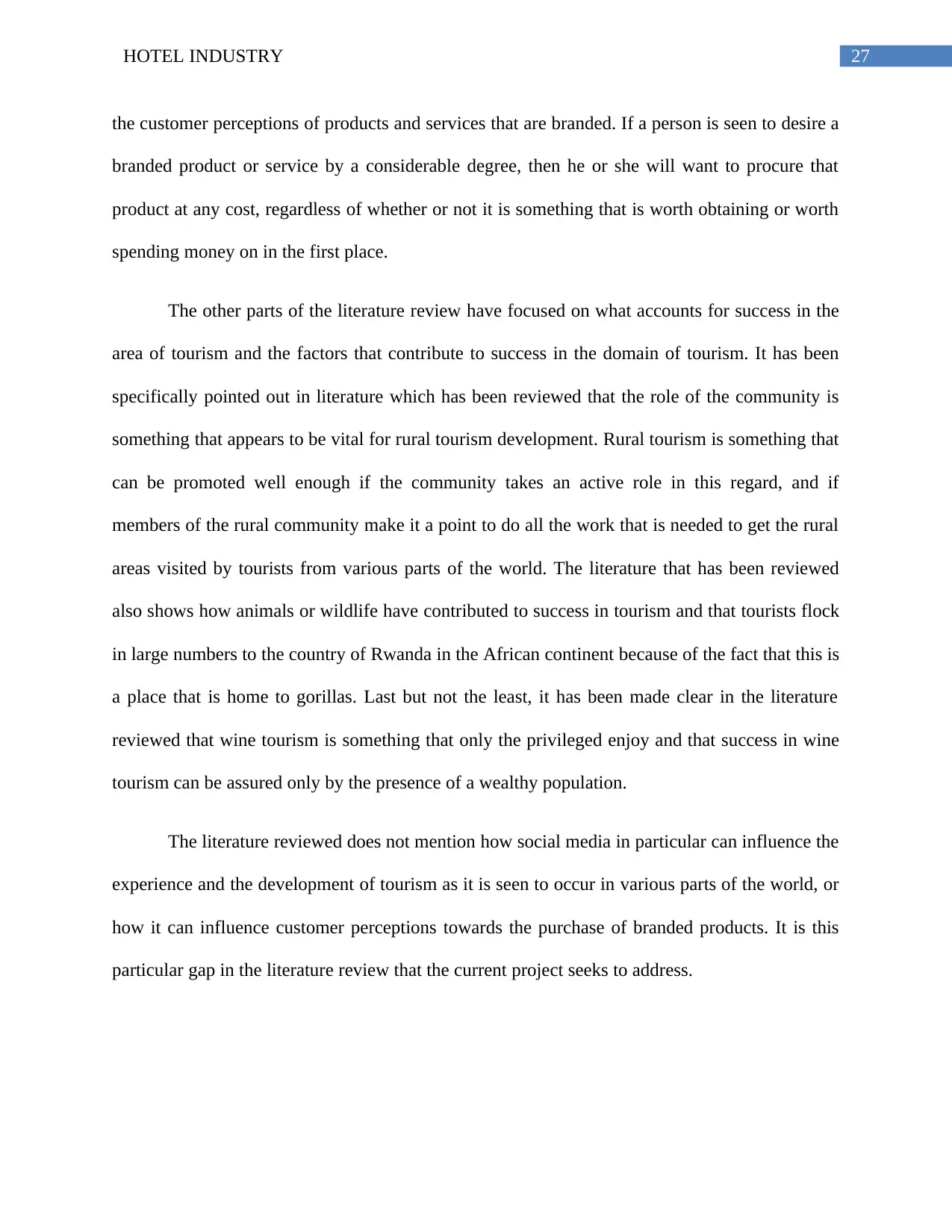
27HOTEL INDUSTRY
the customer perceptions of products and services that are branded. If a person is seen to desire a
branded product or service by a considerable degree, then he or she will want to procure that
product at any cost, regardless of whether or not it is something that is worth obtaining or worth
spending money on in the first place.
The other parts of the literature review have focused on what accounts for success in the
area of tourism and the factors that contribute to success in the domain of tourism. It has been
specifically pointed out in literature which has been reviewed that the role of the community is
something that appears to be vital for rural tourism development. Rural tourism is something that
can be promoted well enough if the community takes an active role in this regard, and if
members of the rural community make it a point to do all the work that is needed to get the rural
areas visited by tourists from various parts of the world. The literature that has been reviewed
also shows how animals or wildlife have contributed to success in tourism and that tourists flock
in large numbers to the country of Rwanda in the African continent because of the fact that this is
a place that is home to gorillas. Last but not the least, it has been made clear in the literature
reviewed that wine tourism is something that only the privileged enjoy and that success in wine
tourism can be assured only by the presence of a wealthy population.
The literature reviewed does not mention how social media in particular can influence the
experience and the development of tourism as it is seen to occur in various parts of the world, or
how it can influence customer perceptions towards the purchase of branded products. It is this
particular gap in the literature review that the current project seeks to address.
the customer perceptions of products and services that are branded. If a person is seen to desire a
branded product or service by a considerable degree, then he or she will want to procure that
product at any cost, regardless of whether or not it is something that is worth obtaining or worth
spending money on in the first place.
The other parts of the literature review have focused on what accounts for success in the
area of tourism and the factors that contribute to success in the domain of tourism. It has been
specifically pointed out in literature which has been reviewed that the role of the community is
something that appears to be vital for rural tourism development. Rural tourism is something that
can be promoted well enough if the community takes an active role in this regard, and if
members of the rural community make it a point to do all the work that is needed to get the rural
areas visited by tourists from various parts of the world. The literature that has been reviewed
also shows how animals or wildlife have contributed to success in tourism and that tourists flock
in large numbers to the country of Rwanda in the African continent because of the fact that this is
a place that is home to gorillas. Last but not the least, it has been made clear in the literature
reviewed that wine tourism is something that only the privileged enjoy and that success in wine
tourism can be assured only by the presence of a wealthy population.
The literature reviewed does not mention how social media in particular can influence the
experience and the development of tourism as it is seen to occur in various parts of the world, or
how it can influence customer perceptions towards the purchase of branded products. It is this
particular gap in the literature review that the current project seeks to address.
Secure Best Marks with AI Grader
Need help grading? Try our AI Grader for instant feedback on your assignments.

28HOTEL INDUSTRY
Chapter 3: Research Methodology
Overview
The chapter will outline the various research systems which have been adopted for the
study. The framework which has been adopted in order to carry out the research is the Research
Onion by Saunders (Bryman and Bell 2011). The research onion serves as a comprehensive
framework which assists in comprehending the system in which the research systems can be
studied in order to determine the general outcomes of the study.
Outline of the Research
The study will follow a systematic format whereby the research onion framework has
been applied and based on this the research will be explained through components of the onion
like the Research Philosophy, Research Approach, the Research Strategy, the Research Choice,
the Time Horizon, the Systems and Procedures along with the Research Instruments. The latter
half of the chapter will focus on the Research Sampling, Research ethics, the Research
Limitations, Reliability and viability along with the discussion on the Research Budget which
shall assist in finding whether the procedures which have been planned to be adopted would be
appropriate to carry out the research or not.
Research Onion Framework
The research onion is generally made use of to explain the research methodology. The
approach which is adopted in the Research Onion is largely based on going from the outer layer
to the inner layer of the research which covers all the different paradigms of aspects which must
be considered prior to any investigation.
Chapter 3: Research Methodology
Overview
The chapter will outline the various research systems which have been adopted for the
study. The framework which has been adopted in order to carry out the research is the Research
Onion by Saunders (Bryman and Bell 2011). The research onion serves as a comprehensive
framework which assists in comprehending the system in which the research systems can be
studied in order to determine the general outcomes of the study.
Outline of the Research
The study will follow a systematic format whereby the research onion framework has
been applied and based on this the research will be explained through components of the onion
like the Research Philosophy, Research Approach, the Research Strategy, the Research Choice,
the Time Horizon, the Systems and Procedures along with the Research Instruments. The latter
half of the chapter will focus on the Research Sampling, Research ethics, the Research
Limitations, Reliability and viability along with the discussion on the Research Budget which
shall assist in finding whether the procedures which have been planned to be adopted would be
appropriate to carry out the research or not.
Research Onion Framework
The research onion is generally made use of to explain the research methodology. The
approach which is adopted in the Research Onion is largely based on going from the outer layer
to the inner layer of the research which covers all the different paradigms of aspects which must
be considered prior to any investigation.
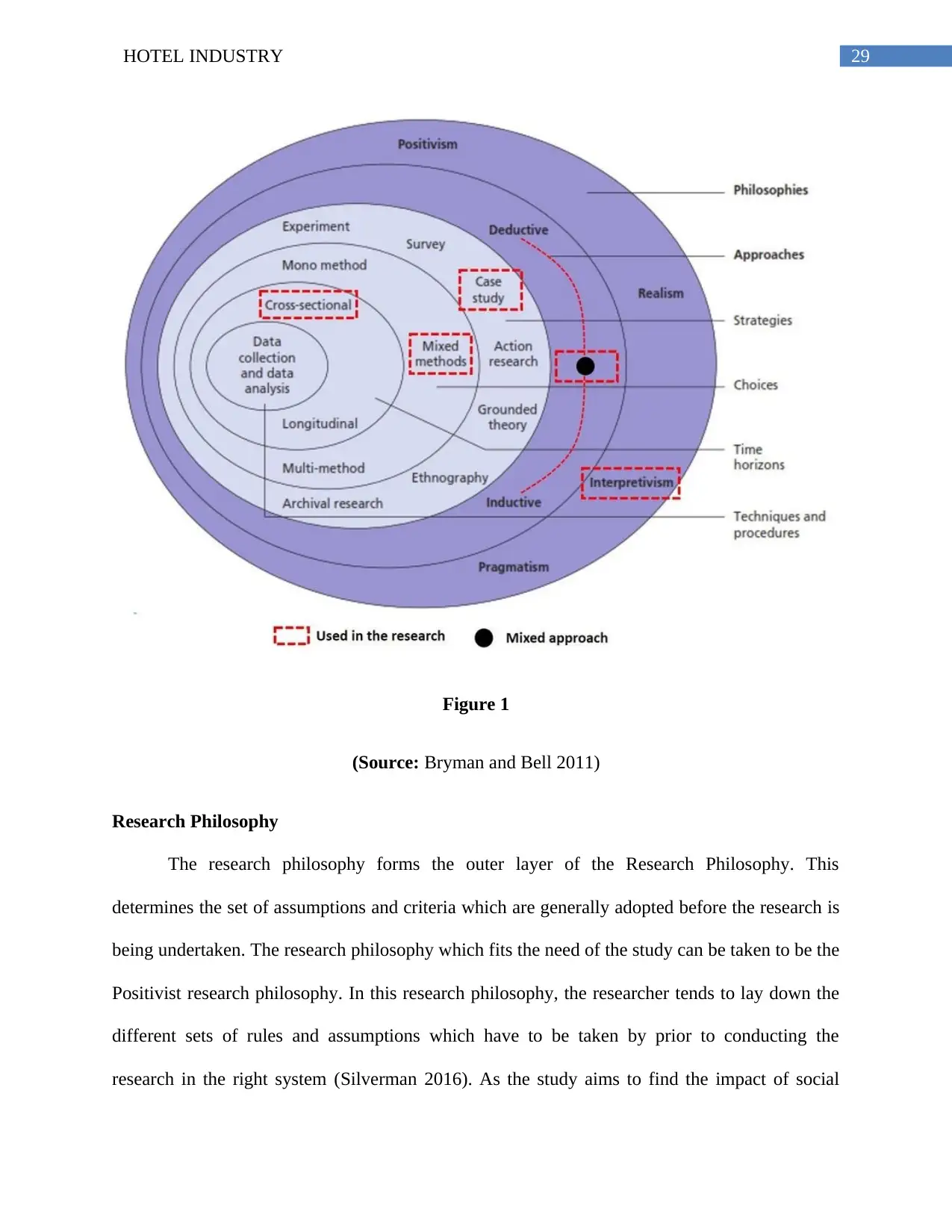
29HOTEL INDUSTRY
Figure 1
(Source: Bryman and Bell 2011)
Research Philosophy
The research philosophy forms the outer layer of the Research Philosophy. This
determines the set of assumptions and criteria which are generally adopted before the research is
being undertaken. The research philosophy which fits the need of the study can be taken to be the
Positivist research philosophy. In this research philosophy, the researcher tends to lay down the
different sets of rules and assumptions which have to be taken by prior to conducting the
research in the right system (Silverman 2016). As the study aims to find the impact of social
Figure 1
(Source: Bryman and Bell 2011)
Research Philosophy
The research philosophy forms the outer layer of the Research Philosophy. This
determines the set of assumptions and criteria which are generally adopted before the research is
being undertaken. The research philosophy which fits the need of the study can be taken to be the
Positivist research philosophy. In this research philosophy, the researcher tends to lay down the
different sets of rules and assumptions which have to be taken by prior to conducting the
research in the right system (Silverman 2016). As the study aims to find the impact of social

30HOTEL INDUSTRY
media on the hotel and tourism industry, it will be suitable for the study to use the Positivist
research philosophy whereby, the different uses of the social media can be well comprehended
before the impact on the hotel and tourism industry is derived.
Research Approach
The research approach is taken to be the system in which the research is carried out by
the researcher. For the study, the research approach which has been adopted can be taken to be
the deductive approach as this tends to fit in with the positivist research philosophy (Kumar
2019.). This deductive approach will contribute towards comprehending the system in which the
social media will contribute to the general field of tourism and hotel and will also help in
comprehending how the customer satisfaction will improve to a great extent if certain strategies
are applied in the field of social media.
Research Strategy
The research strategy is generally assumed to be the general plan of action which is
generally adopted by a researcher to carry out the research procedure. The research strategy
which has been adopted in the given study can be comprehended to be the survey and the
Primary research technique. This means that, the use of a survey will be made in order to gain an
comprehending of the system in which the social media has an impact on the various hotel
operations of the firm (Mackey and Gass 2015). Along with this, the Primary method of data
collection and the quantitative method of data investigation have been applied as this would
contribute towards comprehending how the social media can be taken as a boon for the Hotel and
tourism industry and how the operations can be improvised.
media on the hotel and tourism industry, it will be suitable for the study to use the Positivist
research philosophy whereby, the different uses of the social media can be well comprehended
before the impact on the hotel and tourism industry is derived.
Research Approach
The research approach is taken to be the system in which the research is carried out by
the researcher. For the study, the research approach which has been adopted can be taken to be
the deductive approach as this tends to fit in with the positivist research philosophy (Kumar
2019.). This deductive approach will contribute towards comprehending the system in which the
social media will contribute to the general field of tourism and hotel and will also help in
comprehending how the customer satisfaction will improve to a great extent if certain strategies
are applied in the field of social media.
Research Strategy
The research strategy is generally assumed to be the general plan of action which is
generally adopted by a researcher to carry out the research procedure. The research strategy
which has been adopted in the given study can be comprehended to be the survey and the
Primary research technique. This means that, the use of a survey will be made in order to gain an
comprehending of the system in which the social media has an impact on the various hotel
operations of the firm (Mackey and Gass 2015). Along with this, the Primary method of data
collection and the quantitative method of data investigation have been applied as this would
contribute towards comprehending how the social media can be taken as a boon for the Hotel and
tourism industry and how the operations can be improvised.
Paraphrase This Document
Need a fresh take? Get an instant paraphrase of this document with our AI Paraphraser
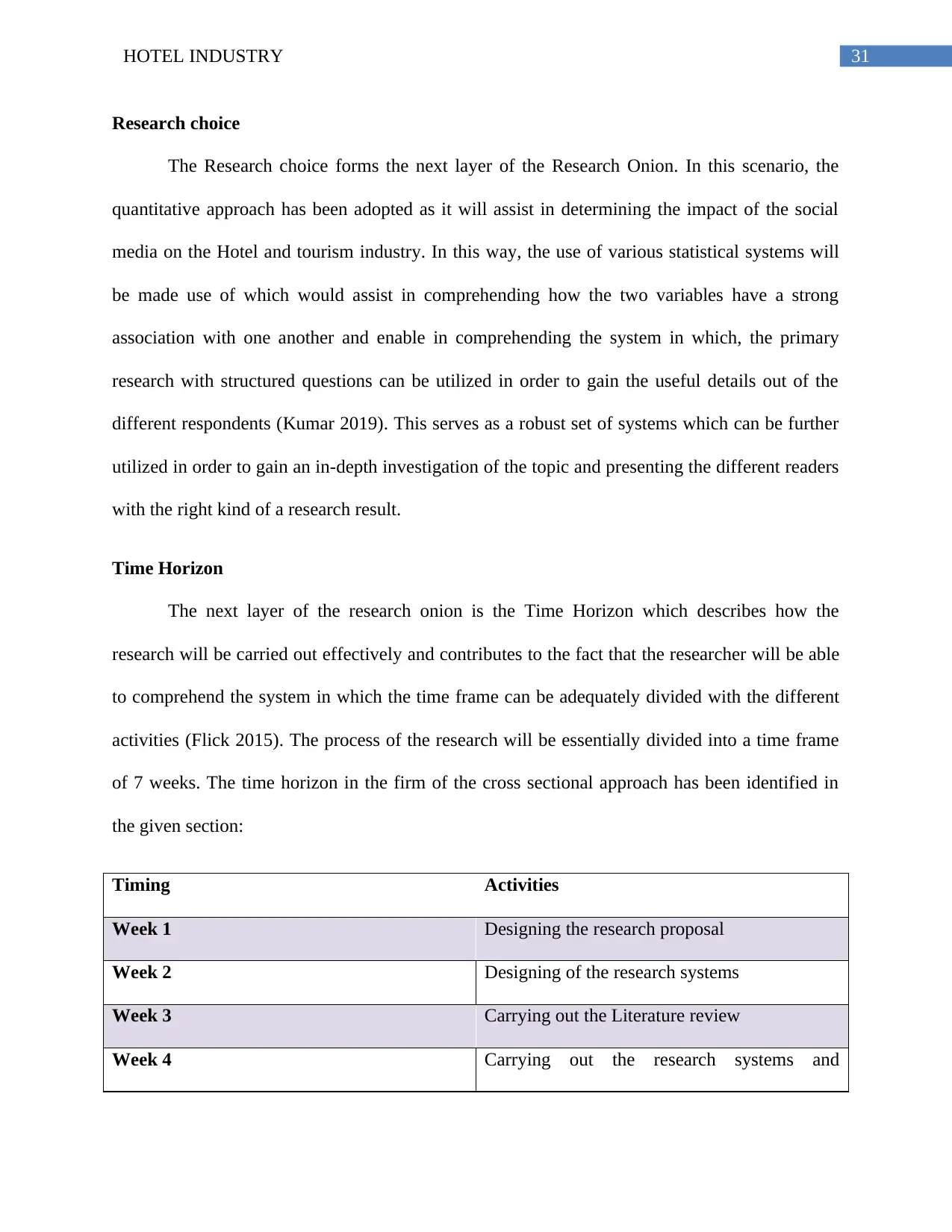
31HOTEL INDUSTRY
Research choice
The Research choice forms the next layer of the Research Onion. In this scenario, the
quantitative approach has been adopted as it will assist in determining the impact of the social
media on the Hotel and tourism industry. In this way, the use of various statistical systems will
be made use of which would assist in comprehending how the two variables have a strong
association with one another and enable in comprehending the system in which, the primary
research with structured questions can be utilized in order to gain the useful details out of the
different respondents (Kumar 2019). This serves as a robust set of systems which can be further
utilized in order to gain an in-depth investigation of the topic and presenting the different readers
with the right kind of a research result.
Time Horizon
The next layer of the research onion is the Time Horizon which describes how the
research will be carried out effectively and contributes to the fact that the researcher will be able
to comprehend the system in which the time frame can be adequately divided with the different
activities (Flick 2015). The process of the research will be essentially divided into a time frame
of 7 weeks. The time horizon in the firm of the cross sectional approach has been identified in
the given section:
Timing Activities
Week 1 Designing the research proposal
Week 2 Designing of the research systems
Week 3 Carrying out the Literature review
Week 4 Carrying out the research systems and
Research choice
The Research choice forms the next layer of the Research Onion. In this scenario, the
quantitative approach has been adopted as it will assist in determining the impact of the social
media on the Hotel and tourism industry. In this way, the use of various statistical systems will
be made use of which would assist in comprehending how the two variables have a strong
association with one another and enable in comprehending the system in which, the primary
research with structured questions can be utilized in order to gain the useful details out of the
different respondents (Kumar 2019). This serves as a robust set of systems which can be further
utilized in order to gain an in-depth investigation of the topic and presenting the different readers
with the right kind of a research result.
Time Horizon
The next layer of the research onion is the Time Horizon which describes how the
research will be carried out effectively and contributes to the fact that the researcher will be able
to comprehend the system in which the time frame can be adequately divided with the different
activities (Flick 2015). The process of the research will be essentially divided into a time frame
of 7 weeks. The time horizon in the firm of the cross sectional approach has been identified in
the given section:
Timing Activities
Week 1 Designing the research proposal
Week 2 Designing of the research systems
Week 3 Carrying out the Literature review
Week 4 Carrying out the research systems and

32HOTEL INDUSTRY
determining the best strategic fit
Week 5 Comprehending the findings of the research
Week 6 Undergoing investigation if the results
Week 7 Summarizing the study and providing
recommendations
Systems, Procedures and Research Instruments
The final layer of the Research Onion generally tends to focus on the Systems and
procedures which ae adopted in relation to the research which is carried out. The study here has
made use of primary research technique whereby the use of a structured questionnaire was made
in order to comprehend the key inputs and approaches which are adopted with regard to the
results of the study hence, the structured questionnaire could be comprehended to be the key
research instrument which was adopted in the research. The focus of the structured questionnaire
lies focused on the use of the social media marketing and links it to the hotel and the tourism
industry success (Alvesson and Sköldberg 2017). The structured questionnaire has been designed
in a system such that the close ended questions were presented to the different respondents and
their answers could be measured with the help of the Liker Scale. This then assists in
comprehending the system in which the different respondents tend to respond to the aspects
related to the Social media and how it will impact the general success of the Hotel industry and
the Tourism industry as well (Quinlan et al. 2019). Another research instrument to be used can
be stated to be the SPSS software which assisted in carrying out the research in a comprehensive
system and also help in preparing the different charts as well as the related graphs regarding the
determining the best strategic fit
Week 5 Comprehending the findings of the research
Week 6 Undergoing investigation if the results
Week 7 Summarizing the study and providing
recommendations
Systems, Procedures and Research Instruments
The final layer of the Research Onion generally tends to focus on the Systems and
procedures which ae adopted in relation to the research which is carried out. The study here has
made use of primary research technique whereby the use of a structured questionnaire was made
in order to comprehend the key inputs and approaches which are adopted with regard to the
results of the study hence, the structured questionnaire could be comprehended to be the key
research instrument which was adopted in the research. The focus of the structured questionnaire
lies focused on the use of the social media marketing and links it to the hotel and the tourism
industry success (Alvesson and Sköldberg 2017). The structured questionnaire has been designed
in a system such that the close ended questions were presented to the different respondents and
their answers could be measured with the help of the Liker Scale. This then assists in
comprehending the system in which the different respondents tend to respond to the aspects
related to the Social media and how it will impact the general success of the Hotel industry and
the Tourism industry as well (Quinlan et al. 2019). Another research instrument to be used can
be stated to be the SPSS software which assisted in carrying out the research in a comprehensive
system and also help in preparing the different charts as well as the related graphs regarding the
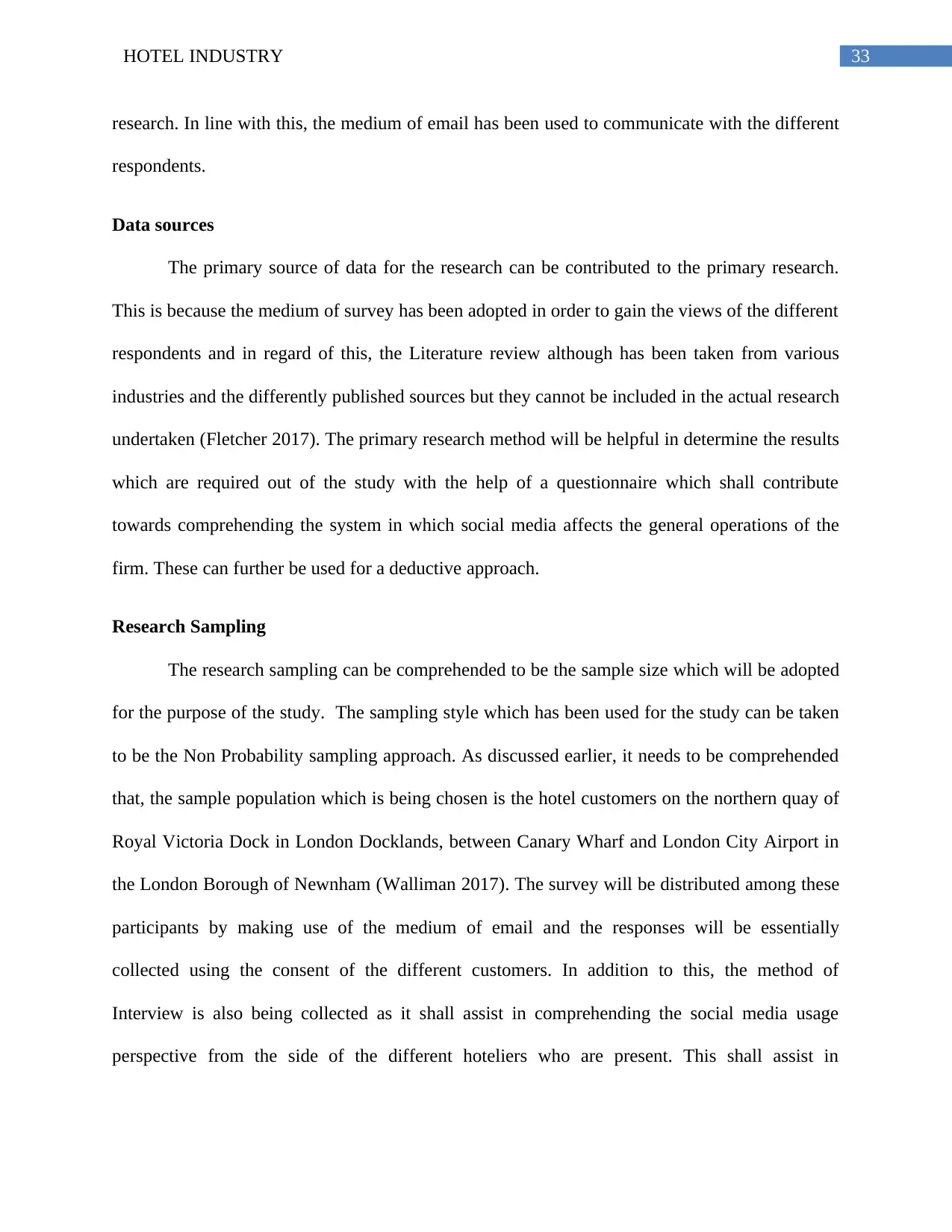
33HOTEL INDUSTRY
research. In line with this, the medium of email has been used to communicate with the different
respondents.
Data sources
The primary source of data for the research can be contributed to the primary research.
This is because the medium of survey has been adopted in order to gain the views of the different
respondents and in regard of this, the Literature review although has been taken from various
industries and the differently published sources but they cannot be included in the actual research
undertaken (Fletcher 2017). The primary research method will be helpful in determine the results
which are required out of the study with the help of a questionnaire which shall contribute
towards comprehending the system in which social media affects the general operations of the
firm. These can further be used for a deductive approach.
Research Sampling
The research sampling can be comprehended to be the sample size which will be adopted
for the purpose of the study. The sampling style which has been used for the study can be taken
to be the Non Probability sampling approach. As discussed earlier, it needs to be comprehended
that, the sample population which is being chosen is the hotel customers on the northern quay of
Royal Victoria Dock in London Docklands, between Canary Wharf and London City Airport in
the London Borough of Newnham (Walliman 2017). The survey will be distributed among these
participants by making use of the medium of email and the responses will be essentially
collected using the consent of the different customers. In addition to this, the method of
Interview is also being collected as it shall assist in comprehending the social media usage
perspective from the side of the different hoteliers who are present. This shall assist in
research. In line with this, the medium of email has been used to communicate with the different
respondents.
Data sources
The primary source of data for the research can be contributed to the primary research.
This is because the medium of survey has been adopted in order to gain the views of the different
respondents and in regard of this, the Literature review although has been taken from various
industries and the differently published sources but they cannot be included in the actual research
undertaken (Fletcher 2017). The primary research method will be helpful in determine the results
which are required out of the study with the help of a questionnaire which shall contribute
towards comprehending the system in which social media affects the general operations of the
firm. These can further be used for a deductive approach.
Research Sampling
The research sampling can be comprehended to be the sample size which will be adopted
for the purpose of the study. The sampling style which has been used for the study can be taken
to be the Non Probability sampling approach. As discussed earlier, it needs to be comprehended
that, the sample population which is being chosen is the hotel customers on the northern quay of
Royal Victoria Dock in London Docklands, between Canary Wharf and London City Airport in
the London Borough of Newnham (Walliman 2017). The survey will be distributed among these
participants by making use of the medium of email and the responses will be essentially
collected using the consent of the different customers. In addition to this, the method of
Interview is also being collected as it shall assist in comprehending the social media usage
perspective from the side of the different hoteliers who are present. This shall assist in
Secure Best Marks with AI Grader
Need help grading? Try our AI Grader for instant feedback on your assignments.
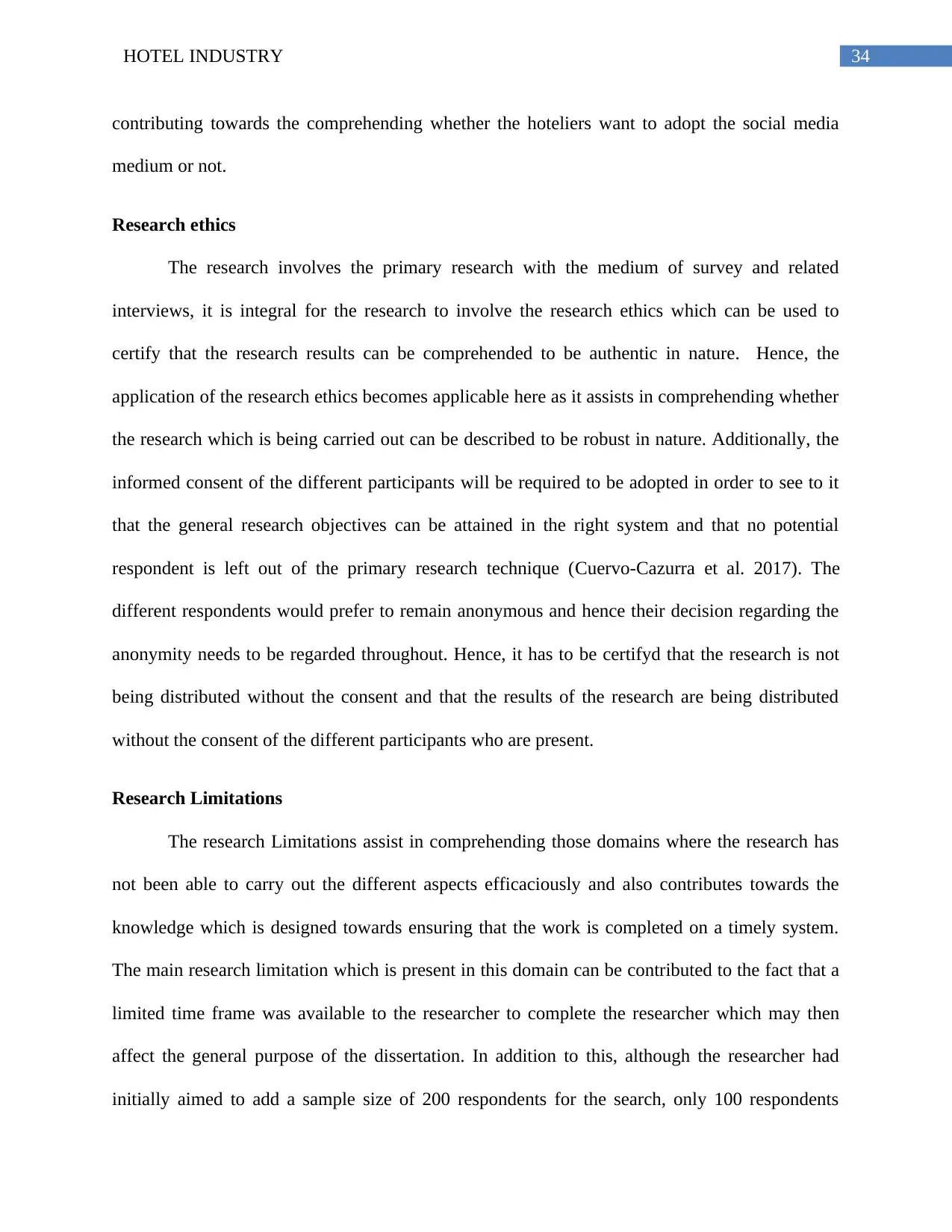
34HOTEL INDUSTRY
contributing towards the comprehending whether the hoteliers want to adopt the social media
medium or not.
Research ethics
The research involves the primary research with the medium of survey and related
interviews, it is integral for the research to involve the research ethics which can be used to
certify that the research results can be comprehended to be authentic in nature. Hence, the
application of the research ethics becomes applicable here as it assists in comprehending whether
the research which is being carried out can be described to be robust in nature. Additionally, the
informed consent of the different participants will be required to be adopted in order to see to it
that the general research objectives can be attained in the right system and that no potential
respondent is left out of the primary research technique (Cuervo‐Cazurra et al. 2017). The
different respondents would prefer to remain anonymous and hence their decision regarding the
anonymity needs to be regarded throughout. Hence, it has to be certifyd that the research is not
being distributed without the consent and that the results of the research are being distributed
without the consent of the different participants who are present.
Research Limitations
The research Limitations assist in comprehending those domains where the research has
not been able to carry out the different aspects efficaciously and also contributes towards the
knowledge which is designed towards ensuring that the work is completed on a timely system.
The main research limitation which is present in this domain can be contributed to the fact that a
limited time frame was available to the researcher to complete the researcher which may then
affect the general purpose of the dissertation. In addition to this, although the researcher had
initially aimed to add a sample size of 200 respondents for the search, only 100 respondents
contributing towards the comprehending whether the hoteliers want to adopt the social media
medium or not.
Research ethics
The research involves the primary research with the medium of survey and related
interviews, it is integral for the research to involve the research ethics which can be used to
certify that the research results can be comprehended to be authentic in nature. Hence, the
application of the research ethics becomes applicable here as it assists in comprehending whether
the research which is being carried out can be described to be robust in nature. Additionally, the
informed consent of the different participants will be required to be adopted in order to see to it
that the general research objectives can be attained in the right system and that no potential
respondent is left out of the primary research technique (Cuervo‐Cazurra et al. 2017). The
different respondents would prefer to remain anonymous and hence their decision regarding the
anonymity needs to be regarded throughout. Hence, it has to be certifyd that the research is not
being distributed without the consent and that the results of the research are being distributed
without the consent of the different participants who are present.
Research Limitations
The research Limitations assist in comprehending those domains where the research has
not been able to carry out the different aspects efficaciously and also contributes towards the
knowledge which is designed towards ensuring that the work is completed on a timely system.
The main research limitation which is present in this domain can be contributed to the fact that a
limited time frame was available to the researcher to complete the researcher which may then
affect the general purpose of the dissertation. In addition to this, although the researcher had
initially aimed to add a sample size of 200 respondents for the search, only 100 respondents
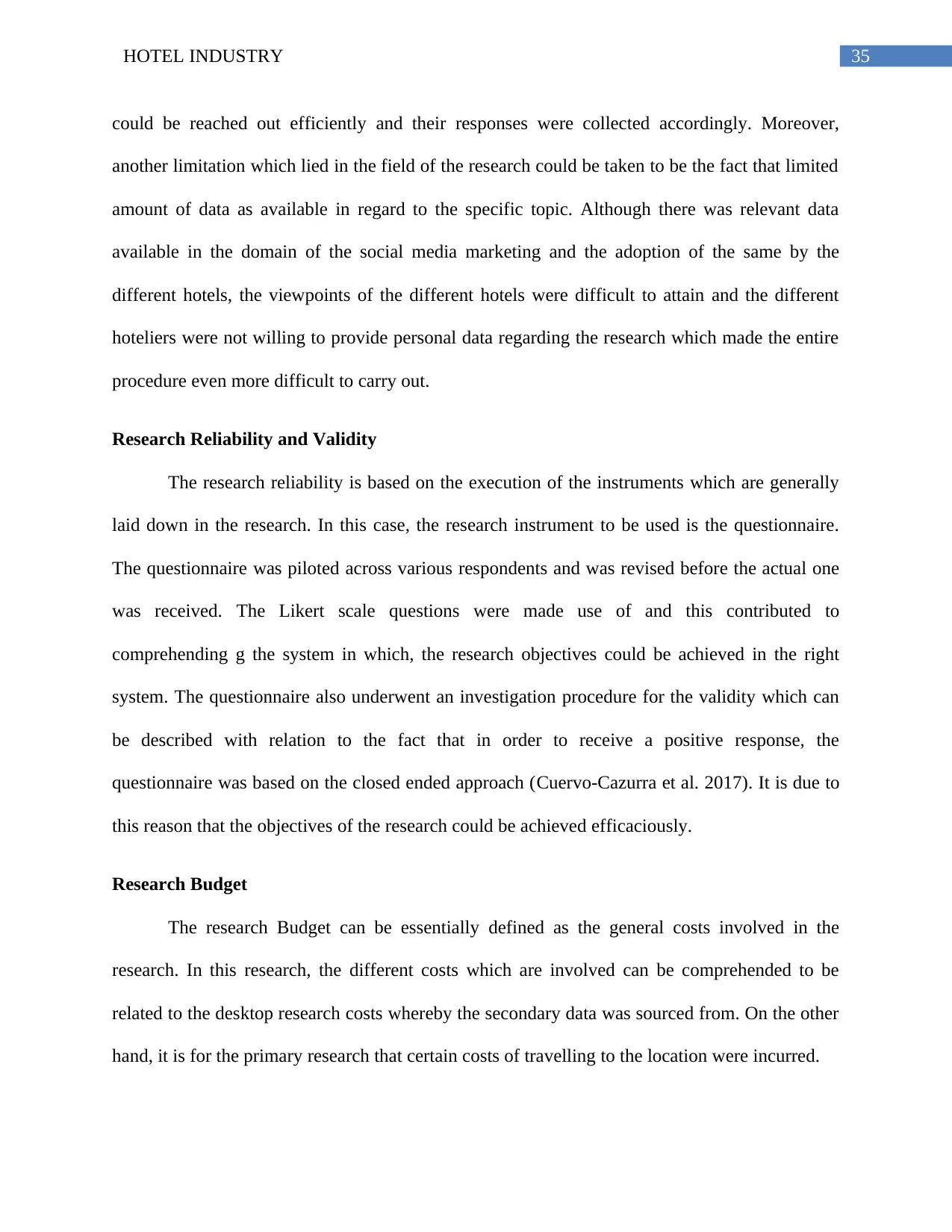
35HOTEL INDUSTRY
could be reached out efficiently and their responses were collected accordingly. Moreover,
another limitation which lied in the field of the research could be taken to be the fact that limited
amount of data as available in regard to the specific topic. Although there was relevant data
available in the domain of the social media marketing and the adoption of the same by the
different hotels, the viewpoints of the different hotels were difficult to attain and the different
hoteliers were not willing to provide personal data regarding the research which made the entire
procedure even more difficult to carry out.
Research Reliability and Validity
The research reliability is based on the execution of the instruments which are generally
laid down in the research. In this case, the research instrument to be used is the questionnaire.
The questionnaire was piloted across various respondents and was revised before the actual one
was received. The Likert scale questions were made use of and this contributed to
comprehending g the system in which, the research objectives could be achieved in the right
system. The questionnaire also underwent an investigation procedure for the validity which can
be described with relation to the fact that in order to receive a positive response, the
questionnaire was based on the closed ended approach (Cuervo‐Cazurra et al. 2017). It is due to
this reason that the objectives of the research could be achieved efficaciously.
Research Budget
The research Budget can be essentially defined as the general costs involved in the
research. In this research, the different costs which are involved can be comprehended to be
related to the desktop research costs whereby the secondary data was sourced from. On the other
hand, it is for the primary research that certain costs of travelling to the location were incurred.
could be reached out efficiently and their responses were collected accordingly. Moreover,
another limitation which lied in the field of the research could be taken to be the fact that limited
amount of data as available in regard to the specific topic. Although there was relevant data
available in the domain of the social media marketing and the adoption of the same by the
different hotels, the viewpoints of the different hotels were difficult to attain and the different
hoteliers were not willing to provide personal data regarding the research which made the entire
procedure even more difficult to carry out.
Research Reliability and Validity
The research reliability is based on the execution of the instruments which are generally
laid down in the research. In this case, the research instrument to be used is the questionnaire.
The questionnaire was piloted across various respondents and was revised before the actual one
was received. The Likert scale questions were made use of and this contributed to
comprehending g the system in which, the research objectives could be achieved in the right
system. The questionnaire also underwent an investigation procedure for the validity which can
be described with relation to the fact that in order to receive a positive response, the
questionnaire was based on the closed ended approach (Cuervo‐Cazurra et al. 2017). It is due to
this reason that the objectives of the research could be achieved efficaciously.
Research Budget
The research Budget can be essentially defined as the general costs involved in the
research. In this research, the different costs which are involved can be comprehended to be
related to the desktop research costs whereby the secondary data was sourced from. On the other
hand, it is for the primary research that certain costs of travelling to the location were incurred.
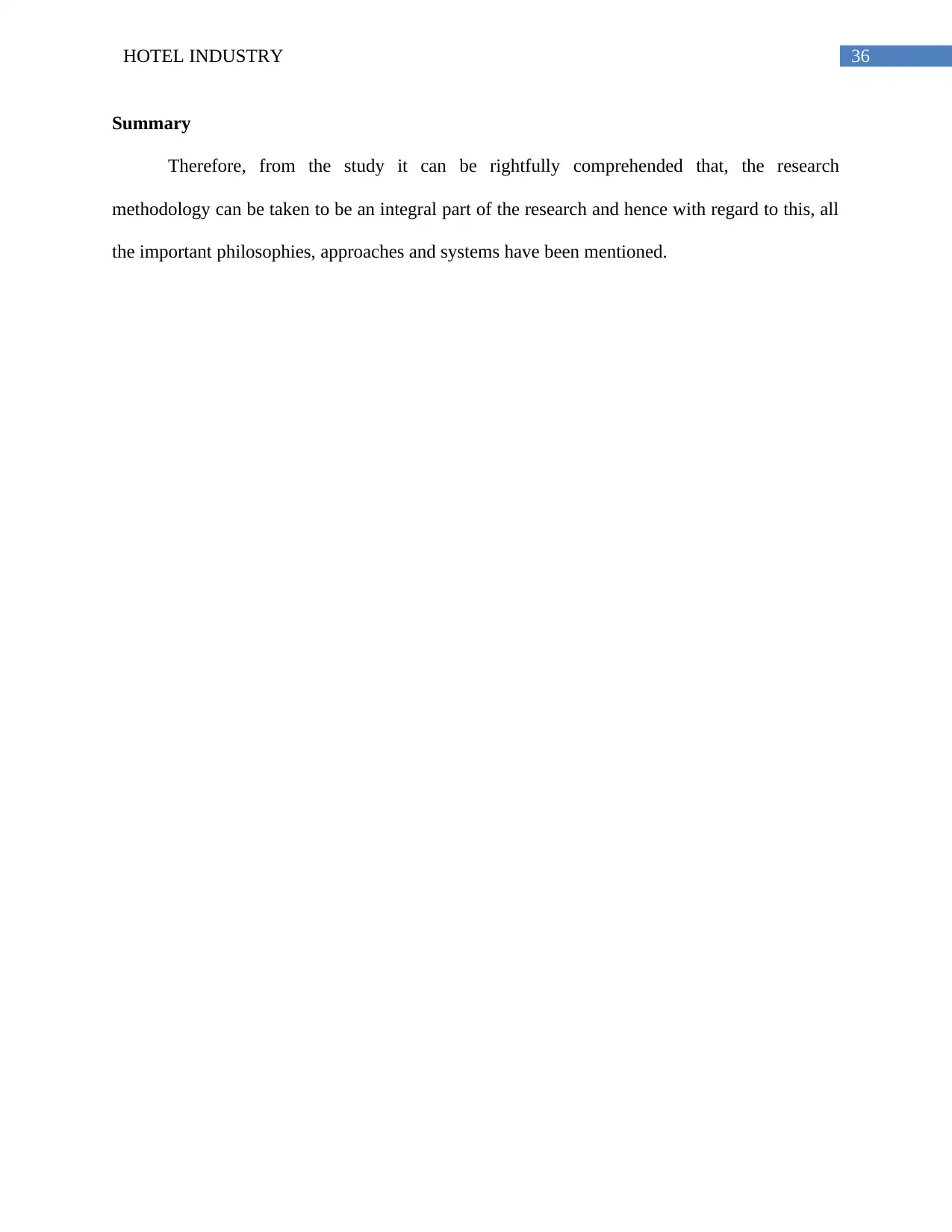
36HOTEL INDUSTRY
Summary
Therefore, from the study it can be rightfully comprehended that, the research
methodology can be taken to be an integral part of the research and hence with regard to this, all
the important philosophies, approaches and systems have been mentioned.
Summary
Therefore, from the study it can be rightfully comprehended that, the research
methodology can be taken to be an integral part of the research and hence with regard to this, all
the important philosophies, approaches and systems have been mentioned.
Paraphrase This Document
Need a fresh take? Get an instant paraphrase of this document with our AI Paraphraser
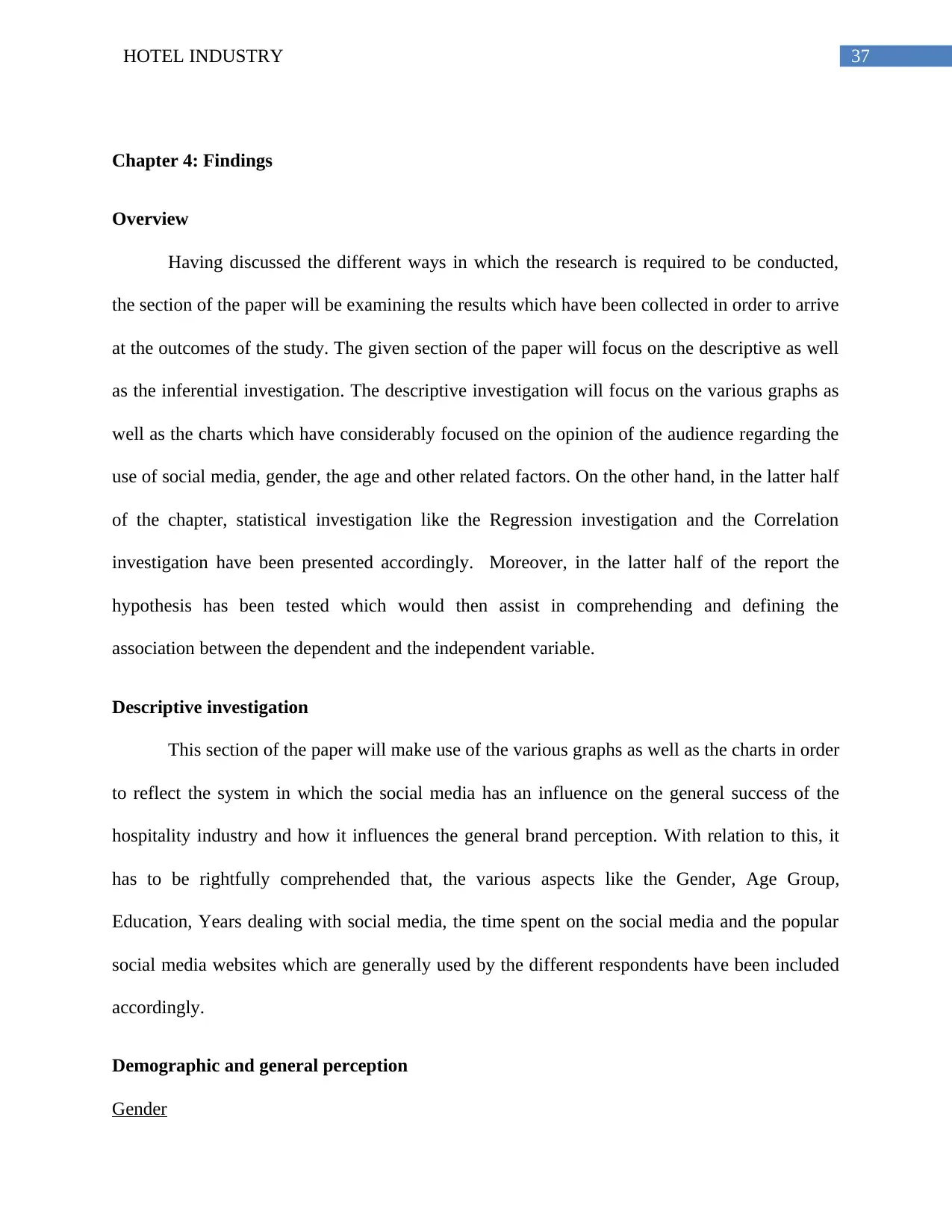
37HOTEL INDUSTRY
Chapter 4: Findings
Overview
Having discussed the different ways in which the research is required to be conducted,
the section of the paper will be examining the results which have been collected in order to arrive
at the outcomes of the study. The given section of the paper will focus on the descriptive as well
as the inferential investigation. The descriptive investigation will focus on the various graphs as
well as the charts which have considerably focused on the opinion of the audience regarding the
use of social media, gender, the age and other related factors. On the other hand, in the latter half
of the chapter, statistical investigation like the Regression investigation and the Correlation
investigation have been presented accordingly. Moreover, in the latter half of the report the
hypothesis has been tested which would then assist in comprehending and defining the
association between the dependent and the independent variable.
Descriptive investigation
This section of the paper will make use of the various graphs as well as the charts in order
to reflect the system in which the social media has an influence on the general success of the
hospitality industry and how it influences the general brand perception. With relation to this, it
has to be rightfully comprehended that, the various aspects like the Gender, Age Group,
Education, Years dealing with social media, the time spent on the social media and the popular
social media websites which are generally used by the different respondents have been included
accordingly.
Demographic and general perception
Gender
Chapter 4: Findings
Overview
Having discussed the different ways in which the research is required to be conducted,
the section of the paper will be examining the results which have been collected in order to arrive
at the outcomes of the study. The given section of the paper will focus on the descriptive as well
as the inferential investigation. The descriptive investigation will focus on the various graphs as
well as the charts which have considerably focused on the opinion of the audience regarding the
use of social media, gender, the age and other related factors. On the other hand, in the latter half
of the chapter, statistical investigation like the Regression investigation and the Correlation
investigation have been presented accordingly. Moreover, in the latter half of the report the
hypothesis has been tested which would then assist in comprehending and defining the
association between the dependent and the independent variable.
Descriptive investigation
This section of the paper will make use of the various graphs as well as the charts in order
to reflect the system in which the social media has an influence on the general success of the
hospitality industry and how it influences the general brand perception. With relation to this, it
has to be rightfully comprehended that, the various aspects like the Gender, Age Group,
Education, Years dealing with social media, the time spent on the social media and the popular
social media websites which are generally used by the different respondents have been included
accordingly.
Demographic and general perception
Gender
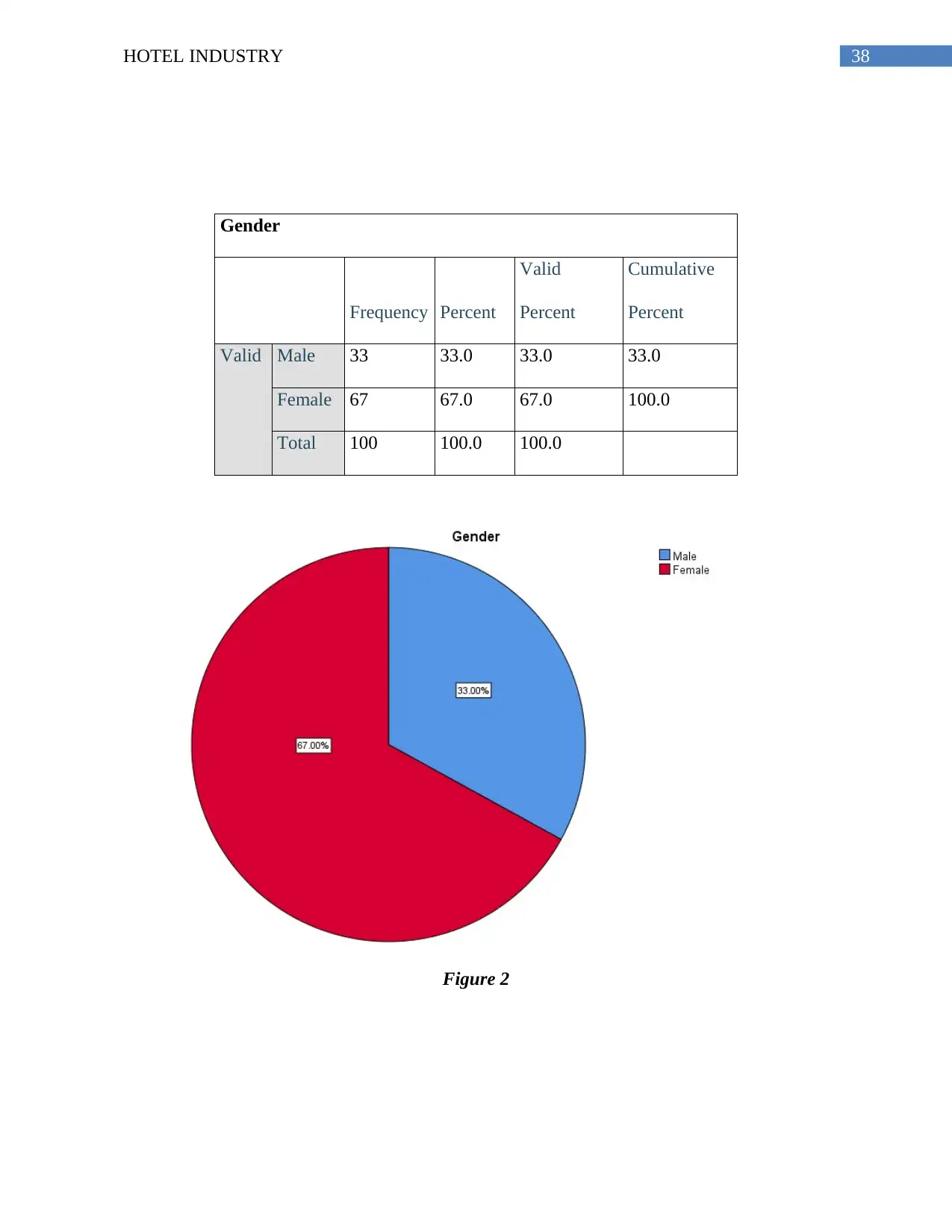
38HOTEL INDUSTRY
Gender
Frequency Percent
Valid
Percent
Cumulative
Percent
Valid Male 33 33.0 33.0 33.0
Female 67 67.0 67.0 100.0
Total 100 100.0 100.0
Figure 2
Gender
Frequency Percent
Valid
Percent
Cumulative
Percent
Valid Male 33 33.0 33.0 33.0
Female 67 67.0 67.0 100.0
Total 100 100.0 100.0
Figure 2
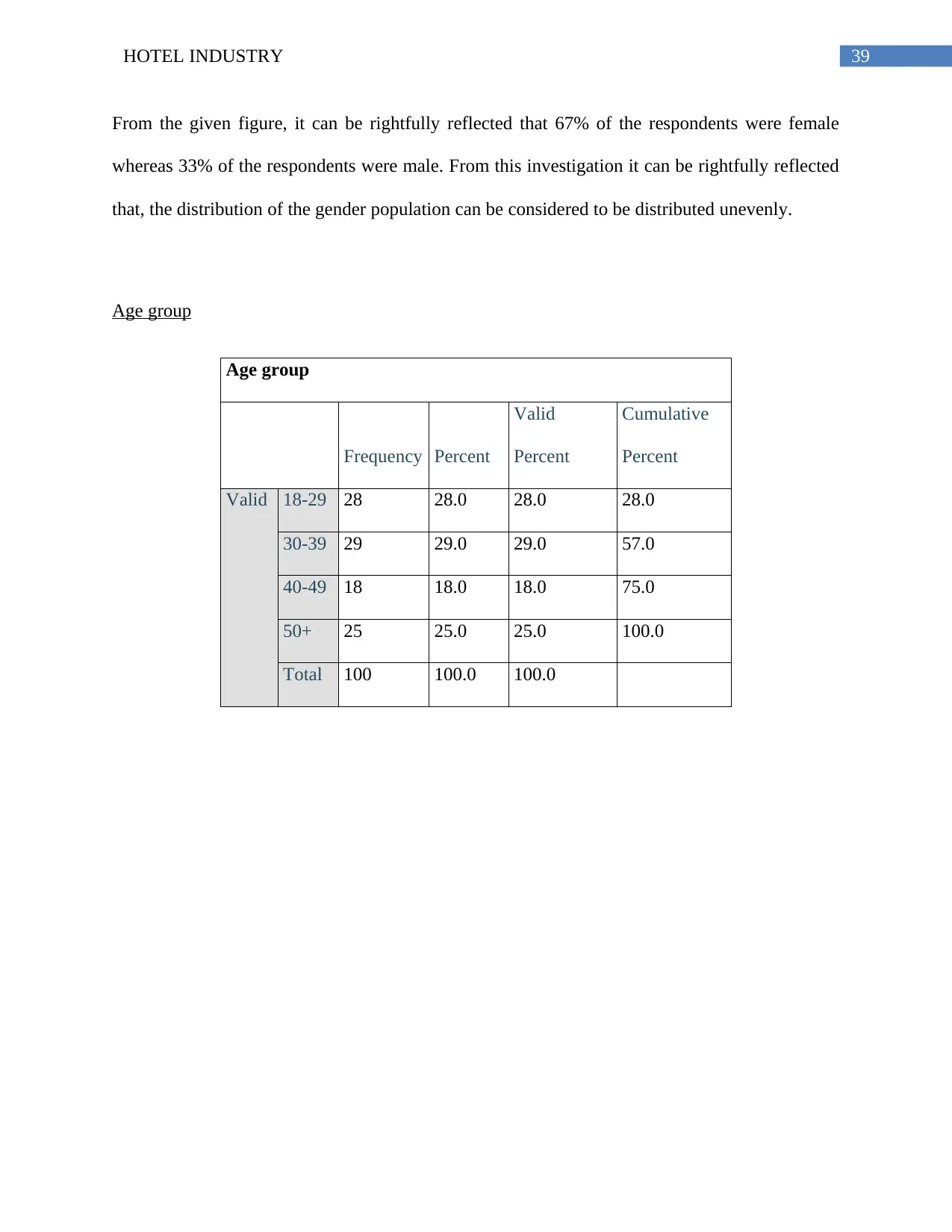
39HOTEL INDUSTRY
From the given figure, it can be rightfully reflected that 67% of the respondents were female
whereas 33% of the respondents were male. From this investigation it can be rightfully reflected
that, the distribution of the gender population can be considered to be distributed unevenly.
Age group
Age group
Frequency Percent
Valid
Percent
Cumulative
Percent
Valid 18-29 28 28.0 28.0 28.0
30-39 29 29.0 29.0 57.0
40-49 18 18.0 18.0 75.0
50+ 25 25.0 25.0 100.0
Total 100 100.0 100.0
From the given figure, it can be rightfully reflected that 67% of the respondents were female
whereas 33% of the respondents were male. From this investigation it can be rightfully reflected
that, the distribution of the gender population can be considered to be distributed unevenly.
Age group
Age group
Frequency Percent
Valid
Percent
Cumulative
Percent
Valid 18-29 28 28.0 28.0 28.0
30-39 29 29.0 29.0 57.0
40-49 18 18.0 18.0 75.0
50+ 25 25.0 25.0 100.0
Total 100 100.0 100.0
Secure Best Marks with AI Grader
Need help grading? Try our AI Grader for instant feedback on your assignments.
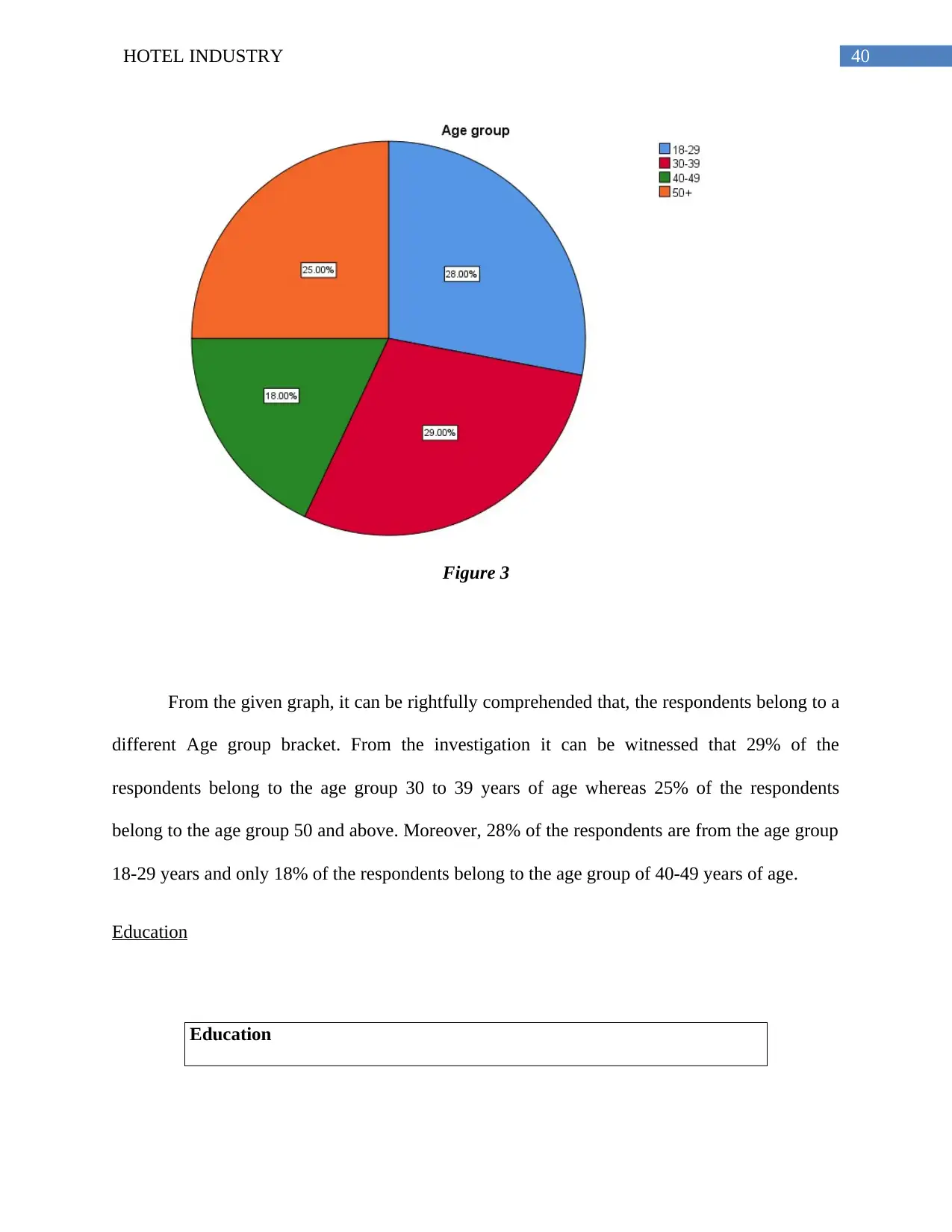
40HOTEL INDUSTRY
Figure 3
From the given graph, it can be rightfully comprehended that, the respondents belong to a
different Age group bracket. From the investigation it can be witnessed that 29% of the
respondents belong to the age group 30 to 39 years of age whereas 25% of the respondents
belong to the age group 50 and above. Moreover, 28% of the respondents are from the age group
18-29 years and only 18% of the respondents belong to the age group of 40-49 years of age.
Education
Education
Figure 3
From the given graph, it can be rightfully comprehended that, the respondents belong to a
different Age group bracket. From the investigation it can be witnessed that 29% of the
respondents belong to the age group 30 to 39 years of age whereas 25% of the respondents
belong to the age group 50 and above. Moreover, 28% of the respondents are from the age group
18-29 years and only 18% of the respondents belong to the age group of 40-49 years of age.
Education
Education
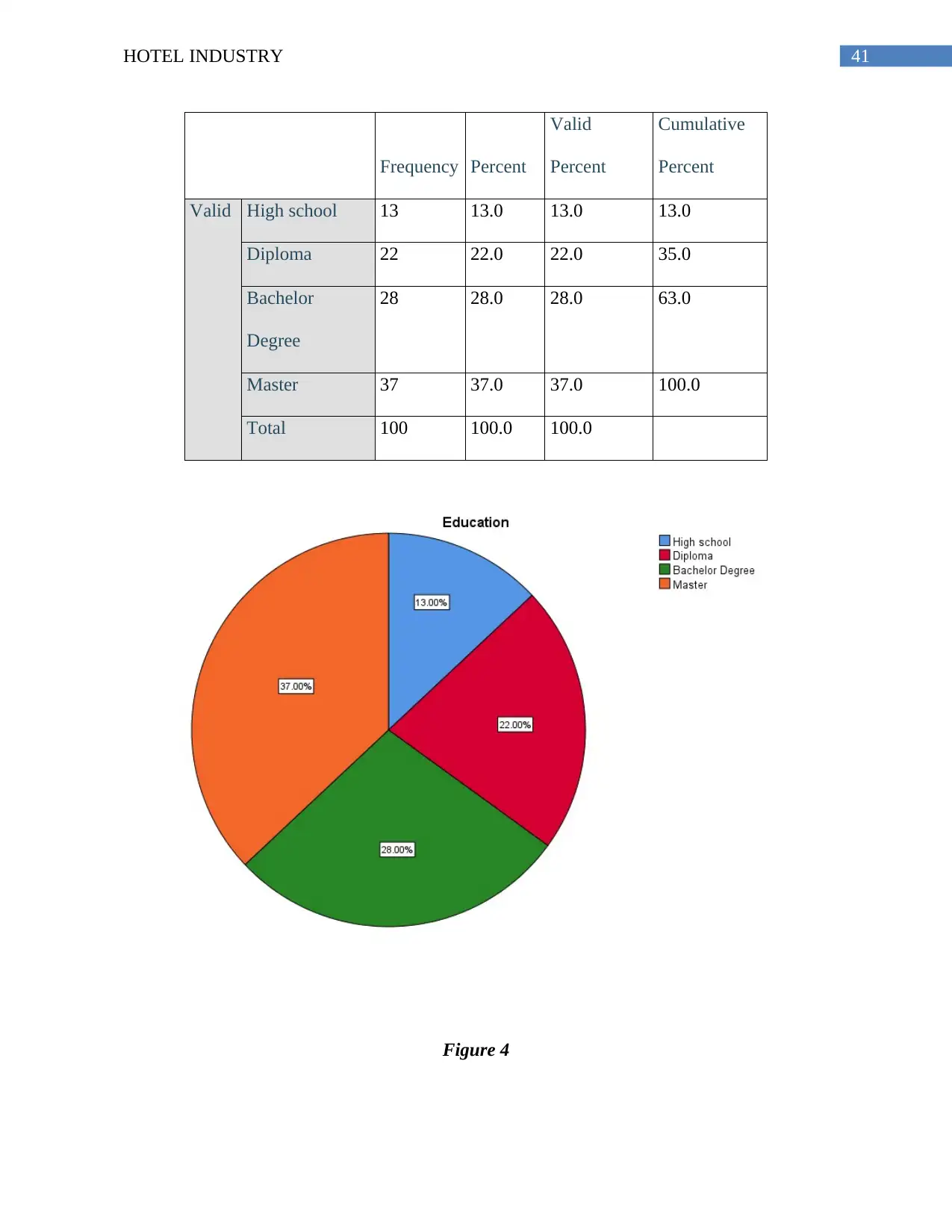
41HOTEL INDUSTRY
Frequency Percent
Valid
Percent
Cumulative
Percent
Valid High school 13 13.0 13.0 13.0
Diploma 22 22.0 22.0 35.0
Bachelor
Degree
28 28.0 28.0 63.0
Master 37 37.0 37.0 100.0
Total 100 100.0 100.0
Figure 4
Frequency Percent
Valid
Percent
Cumulative
Percent
Valid High school 13 13.0 13.0 13.0
Diploma 22 22.0 22.0 35.0
Bachelor
Degree
28 28.0 28.0 63.0
Master 37 37.0 37.0 100.0
Total 100 100.0 100.0
Figure 4
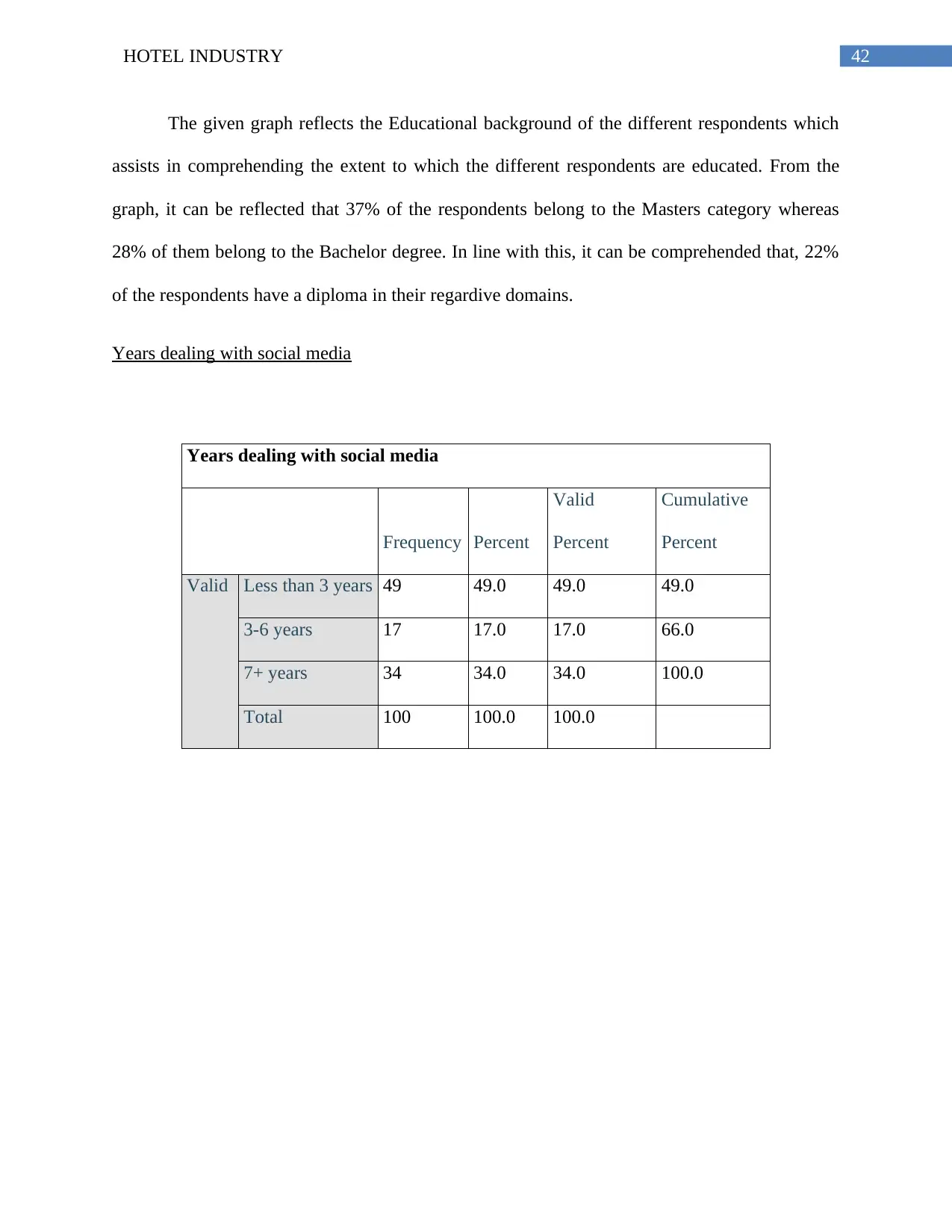
42HOTEL INDUSTRY
The given graph reflects the Educational background of the different respondents which
assists in comprehending the extent to which the different respondents are educated. From the
graph, it can be reflected that 37% of the respondents belong to the Masters category whereas
28% of them belong to the Bachelor degree. In line with this, it can be comprehended that, 22%
of the respondents have a diploma in their regardive domains.
Years dealing with social media
Years dealing with social media
Frequency Percent
Valid
Percent
Cumulative
Percent
Valid Less than 3 years 49 49.0 49.0 49.0
3-6 years 17 17.0 17.0 66.0
7+ years 34 34.0 34.0 100.0
Total 100 100.0 100.0
The given graph reflects the Educational background of the different respondents which
assists in comprehending the extent to which the different respondents are educated. From the
graph, it can be reflected that 37% of the respondents belong to the Masters category whereas
28% of them belong to the Bachelor degree. In line with this, it can be comprehended that, 22%
of the respondents have a diploma in their regardive domains.
Years dealing with social media
Years dealing with social media
Frequency Percent
Valid
Percent
Cumulative
Percent
Valid Less than 3 years 49 49.0 49.0 49.0
3-6 years 17 17.0 17.0 66.0
7+ years 34 34.0 34.0 100.0
Total 100 100.0 100.0
Paraphrase This Document
Need a fresh take? Get an instant paraphrase of this document with our AI Paraphraser
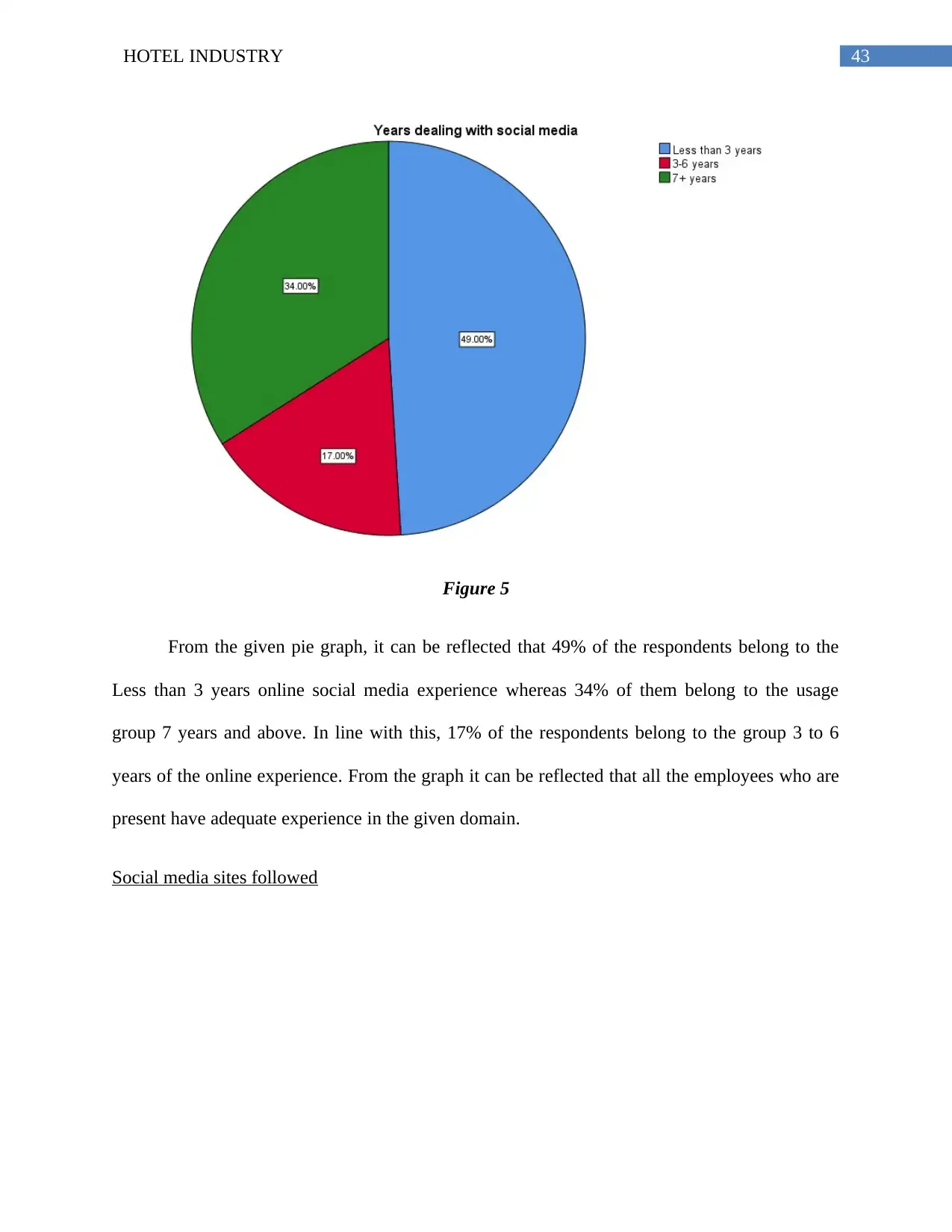
43HOTEL INDUSTRY
Figure 5
From the given pie graph, it can be reflected that 49% of the respondents belong to the
Less than 3 years online social media experience whereas 34% of them belong to the usage
group 7 years and above. In line with this, 17% of the respondents belong to the group 3 to 6
years of the online experience. From the graph it can be reflected that all the employees who are
present have adequate experience in the given domain.
Social media sites followed
Figure 5
From the given pie graph, it can be reflected that 49% of the respondents belong to the
Less than 3 years online social media experience whereas 34% of them belong to the usage
group 7 years and above. In line with this, 17% of the respondents belong to the group 3 to 6
years of the online experience. From the graph it can be reflected that all the employees who are
present have adequate experience in the given domain.
Social media sites followed
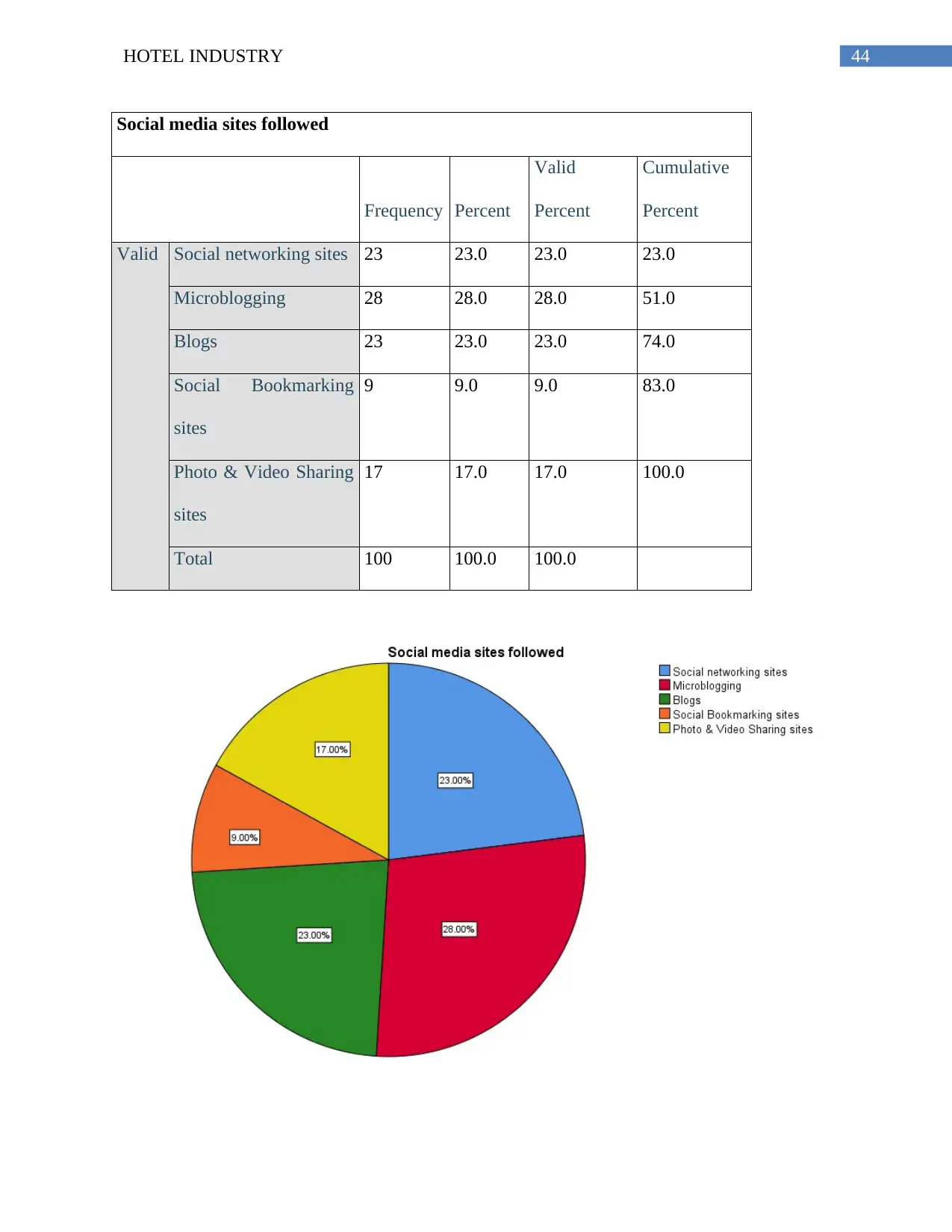
44HOTEL INDUSTRY
Social media sites followed
Frequency Percent
Valid
Percent
Cumulative
Percent
Valid Social networking sites 23 23.0 23.0 23.0
Microblogging 28 28.0 28.0 51.0
Blogs 23 23.0 23.0 74.0
Social Bookmarking
sites
9 9.0 9.0 83.0
Photo & Video Sharing
sites
17 17.0 17.0 100.0
Total 100 100.0 100.0
Social media sites followed
Frequency Percent
Valid
Percent
Cumulative
Percent
Valid Social networking sites 23 23.0 23.0 23.0
Microblogging 28 28.0 28.0 51.0
Blogs 23 23.0 23.0 74.0
Social Bookmarking
sites
9 9.0 9.0 83.0
Photo & Video Sharing
sites
17 17.0 17.0 100.0
Total 100 100.0 100.0
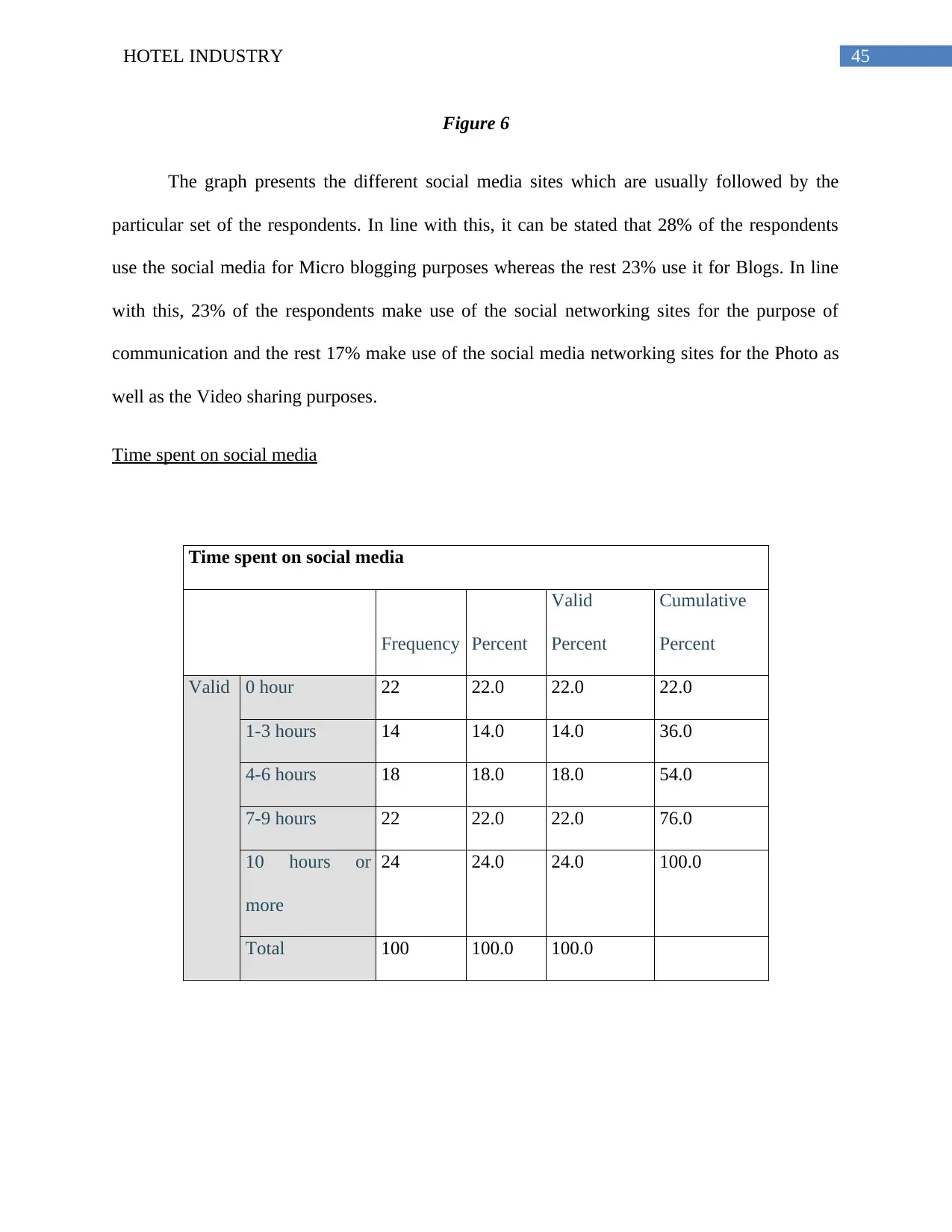
45HOTEL INDUSTRY
Figure 6
The graph presents the different social media sites which are usually followed by the
particular set of the respondents. In line with this, it can be stated that 28% of the respondents
use the social media for Micro blogging purposes whereas the rest 23% use it for Blogs. In line
with this, 23% of the respondents make use of the social networking sites for the purpose of
communication and the rest 17% make use of the social media networking sites for the Photo as
well as the Video sharing purposes.
Time spent on social media
Time spent on social media
Frequency Percent
Valid
Percent
Cumulative
Percent
Valid 0 hour 22 22.0 22.0 22.0
1-3 hours 14 14.0 14.0 36.0
4-6 hours 18 18.0 18.0 54.0
7-9 hours 22 22.0 22.0 76.0
10 hours or
more
24 24.0 24.0 100.0
Total 100 100.0 100.0
Figure 6
The graph presents the different social media sites which are usually followed by the
particular set of the respondents. In line with this, it can be stated that 28% of the respondents
use the social media for Micro blogging purposes whereas the rest 23% use it for Blogs. In line
with this, 23% of the respondents make use of the social networking sites for the purpose of
communication and the rest 17% make use of the social media networking sites for the Photo as
well as the Video sharing purposes.
Time spent on social media
Time spent on social media
Frequency Percent
Valid
Percent
Cumulative
Percent
Valid 0 hour 22 22.0 22.0 22.0
1-3 hours 14 14.0 14.0 36.0
4-6 hours 18 18.0 18.0 54.0
7-9 hours 22 22.0 22.0 76.0
10 hours or
more
24 24.0 24.0 100.0
Total 100 100.0 100.0
Secure Best Marks with AI Grader
Need help grading? Try our AI Grader for instant feedback on your assignments.
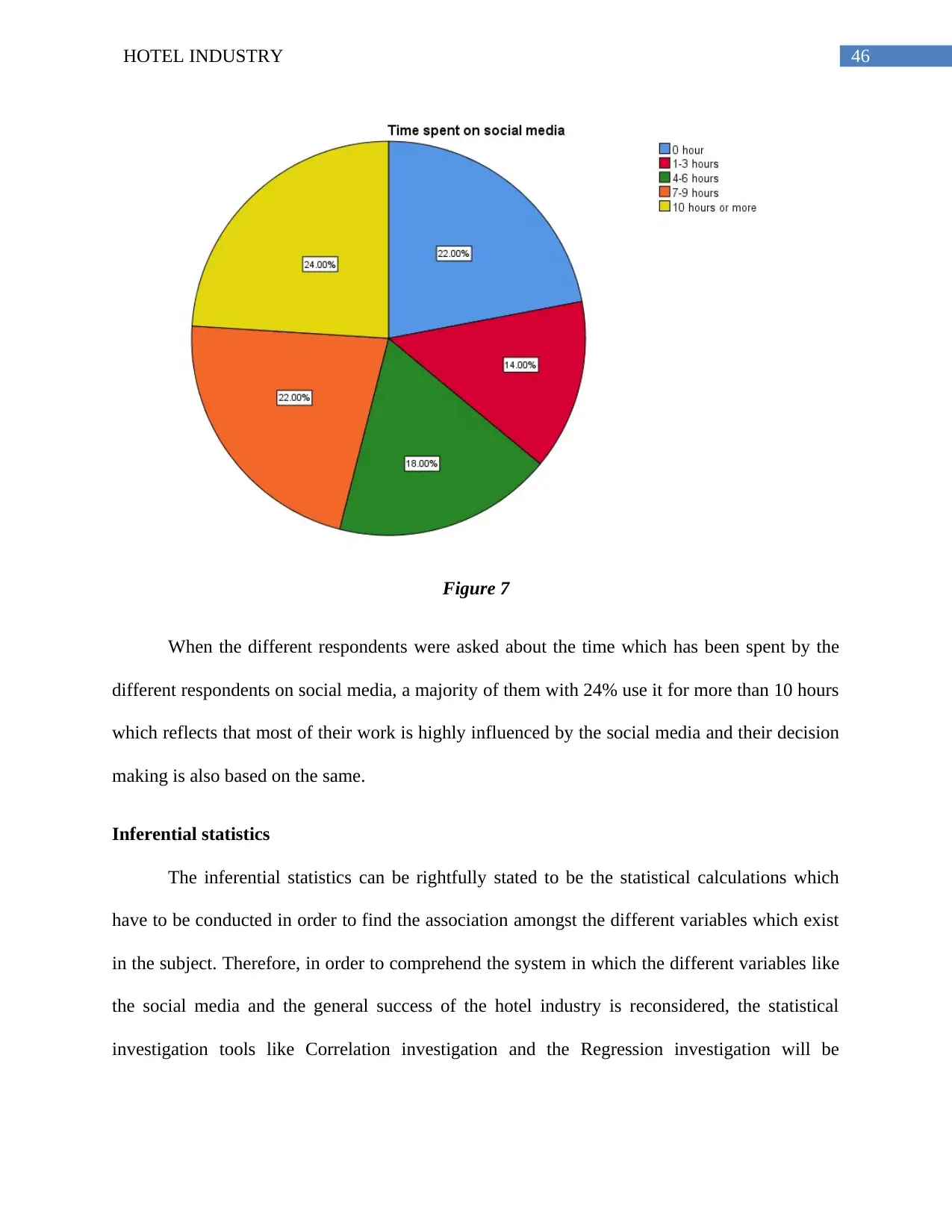
46HOTEL INDUSTRY
Figure 7
When the different respondents were asked about the time which has been spent by the
different respondents on social media, a majority of them with 24% use it for more than 10 hours
which reflects that most of their work is highly influenced by the social media and their decision
making is also based on the same.
Inferential statistics
The inferential statistics can be rightfully stated to be the statistical calculations which
have to be conducted in order to find the association amongst the different variables which exist
in the subject. Therefore, in order to comprehend the system in which the different variables like
the social media and the general success of the hotel industry is reconsidered, the statistical
investigation tools like Correlation investigation and the Regression investigation will be
Figure 7
When the different respondents were asked about the time which has been spent by the
different respondents on social media, a majority of them with 24% use it for more than 10 hours
which reflects that most of their work is highly influenced by the social media and their decision
making is also based on the same.
Inferential statistics
The inferential statistics can be rightfully stated to be the statistical calculations which
have to be conducted in order to find the association amongst the different variables which exist
in the subject. Therefore, in order to comprehend the system in which the different variables like
the social media and the general success of the hotel industry is reconsidered, the statistical
investigation tools like Correlation investigation and the Regression investigation will be
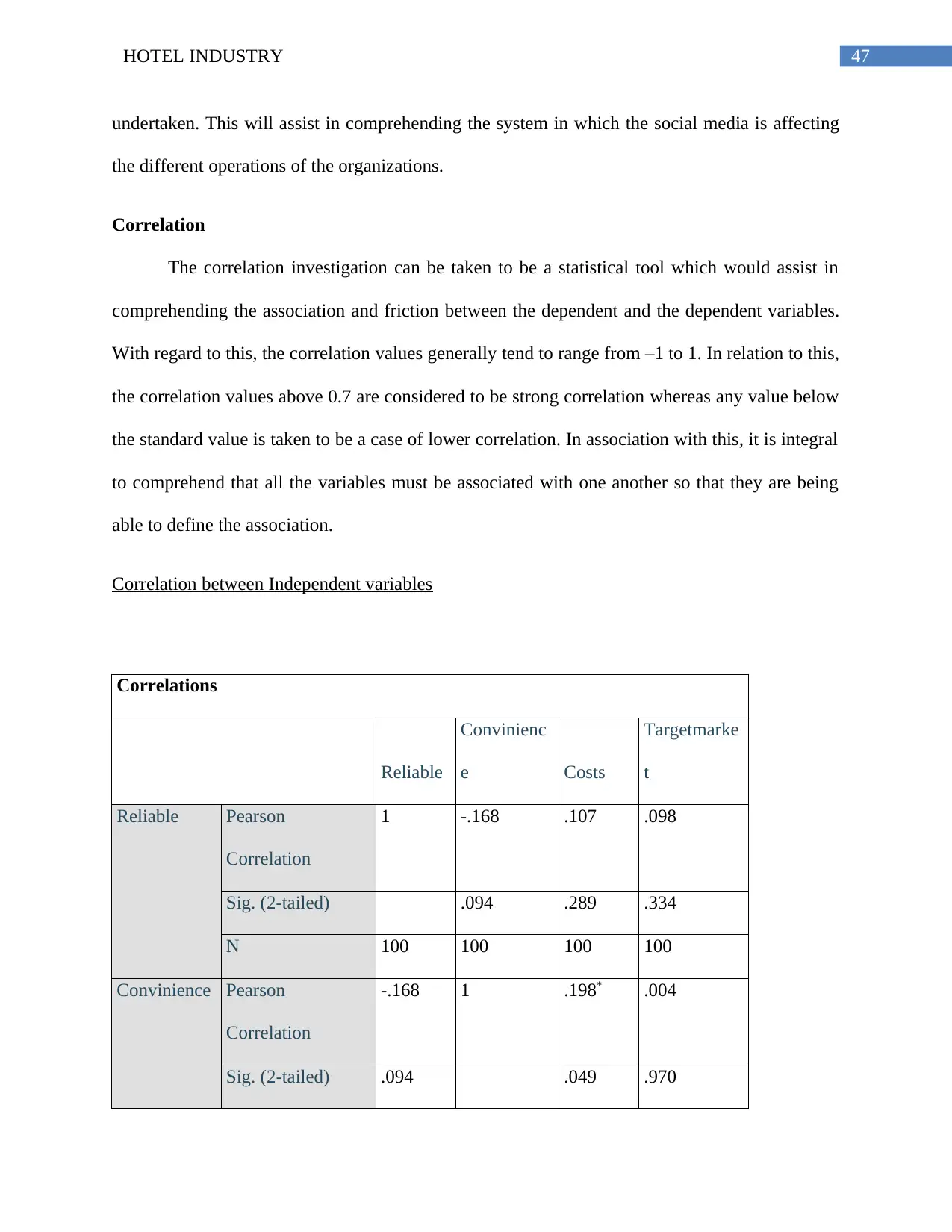
47HOTEL INDUSTRY
undertaken. This will assist in comprehending the system in which the social media is affecting
the different operations of the organizations.
Correlation
The correlation investigation can be taken to be a statistical tool which would assist in
comprehending the association and friction between the dependent and the dependent variables.
With regard to this, the correlation values generally tend to range from –1 to 1. In relation to this,
the correlation values above 0.7 are considered to be strong correlation whereas any value below
the standard value is taken to be a case of lower correlation. In association with this, it is integral
to comprehend that all the variables must be associated with one another so that they are being
able to define the association.
Correlation between Independent variables
Correlations
Reliable
Convinienc
e Costs
Targetmarke
t
Reliable Pearson
Correlation
1 -.168 .107 .098
Sig. (2-tailed) .094 .289 .334
N 100 100 100 100
Convinience Pearson
Correlation
-.168 1 .198* .004
Sig. (2-tailed) .094 .049 .970
undertaken. This will assist in comprehending the system in which the social media is affecting
the different operations of the organizations.
Correlation
The correlation investigation can be taken to be a statistical tool which would assist in
comprehending the association and friction between the dependent and the dependent variables.
With regard to this, the correlation values generally tend to range from –1 to 1. In relation to this,
the correlation values above 0.7 are considered to be strong correlation whereas any value below
the standard value is taken to be a case of lower correlation. In association with this, it is integral
to comprehend that all the variables must be associated with one another so that they are being
able to define the association.
Correlation between Independent variables
Correlations
Reliable
Convinienc
e Costs
Targetmarke
t
Reliable Pearson
Correlation
1 -.168 .107 .098
Sig. (2-tailed) .094 .289 .334
N 100 100 100 100
Convinience Pearson
Correlation
-.168 1 .198* .004
Sig. (2-tailed) .094 .049 .970
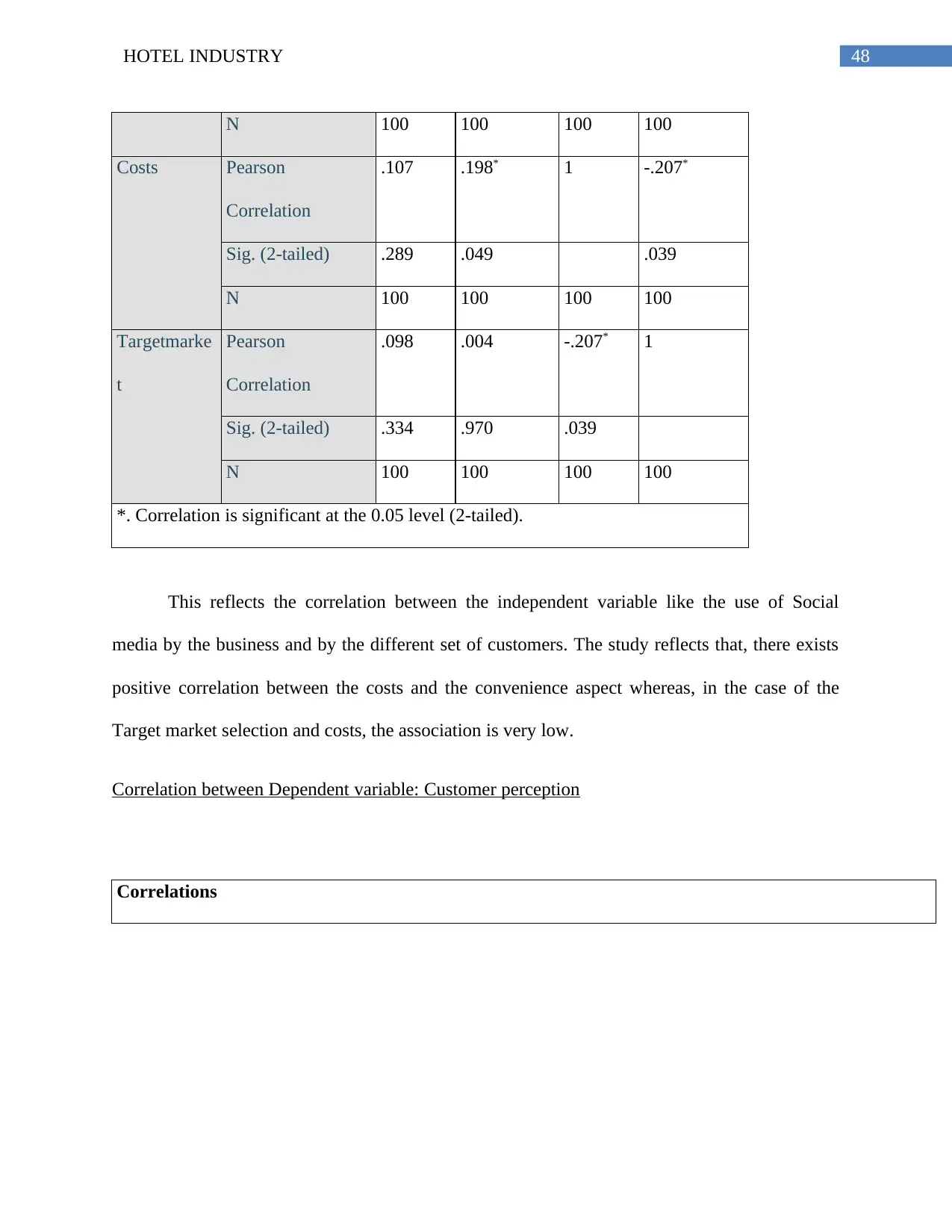
48HOTEL INDUSTRY
N 100 100 100 100
Costs Pearson
Correlation
.107 .198* 1 -.207*
Sig. (2-tailed) .289 .049 .039
N 100 100 100 100
Targetmarke
t
Pearson
Correlation
.098 .004 -.207* 1
Sig. (2-tailed) .334 .970 .039
N 100 100 100 100
*. Correlation is significant at the 0.05 level (2-tailed).
This reflects the correlation between the independent variable like the use of Social
media by the business and by the different set of customers. The study reflects that, there exists
positive correlation between the costs and the convenience aspect whereas, in the case of the
Target market selection and costs, the association is very low.
Correlation between Dependent variable: Customer perception
Correlations
N 100 100 100 100
Costs Pearson
Correlation
.107 .198* 1 -.207*
Sig. (2-tailed) .289 .049 .039
N 100 100 100 100
Targetmarke
t
Pearson
Correlation
.098 .004 -.207* 1
Sig. (2-tailed) .334 .970 .039
N 100 100 100 100
*. Correlation is significant at the 0.05 level (2-tailed).
This reflects the correlation between the independent variable like the use of Social
media by the business and by the different set of customers. The study reflects that, there exists
positive correlation between the costs and the convenience aspect whereas, in the case of the
Target market selection and costs, the association is very low.
Correlation between Dependent variable: Customer perception
Correlations
Paraphrase This Document
Need a fresh take? Get an instant paraphrase of this document with our AI Paraphraser

49HOTEL INDUSTRY
The brand
perception of
the customer
is based on
the success of
the brand
Brands with
better
presence have
a better
customer
perception
Low prices
help in
building
valued brand
perceptions
Valued
services
improve
Customer
brand
perception
The brand perception of
the customer is based on
the success of the brand
Pearson Correlation 1 .264** .167 -.399**
Sig. (2-tailed) .008 .098 .000
N 100 100 100 100
Brands with better
presence have a better
customer perception
Pearson Correlation .264** 1 -.303** -.154
Sig. (2-tailed) .008 .002 .127
N 100 100 100 100
Low prices help in
building valued brand
perceptions
Pearson Correlation .167 -.303** 1 -.171
Sig. (2-tailed) .098 .002 .089
N 100 100 100 100
Valued services improve
Customer brand
perception
Pearson Correlation -.399** -.154 -.171 1
Sig. (2-tailed) .000 .127 .089
N 100 100 100 100
**. Correlation is significant at the 0.01 level (2-tailed).
The given table reflects the correlation coefficient which takes place between the
different sub factors of the dependent variable which is the Customer satisfaction. The study
reflects that, the correlation between the different variables like the success of the brand and the
The brand
perception of
the customer
is based on
the success of
the brand
Brands with
better
presence have
a better
customer
perception
Low prices
help in
building
valued brand
perceptions
Valued
services
improve
Customer
brand
perception
The brand perception of
the customer is based on
the success of the brand
Pearson Correlation 1 .264** .167 -.399**
Sig. (2-tailed) .008 .098 .000
N 100 100 100 100
Brands with better
presence have a better
customer perception
Pearson Correlation .264** 1 -.303** -.154
Sig. (2-tailed) .008 .002 .127
N 100 100 100 100
Low prices help in
building valued brand
perceptions
Pearson Correlation .167 -.303** 1 -.171
Sig. (2-tailed) .098 .002 .089
N 100 100 100 100
Valued services improve
Customer brand
perception
Pearson Correlation -.399** -.154 -.171 1
Sig. (2-tailed) .000 .127 .089
N 100 100 100 100
**. Correlation is significant at the 0.01 level (2-tailed).
The given table reflects the correlation coefficient which takes place between the
different sub factors of the dependent variable which is the Customer satisfaction. The study
reflects that, the correlation between the different variables like the success of the brand and the
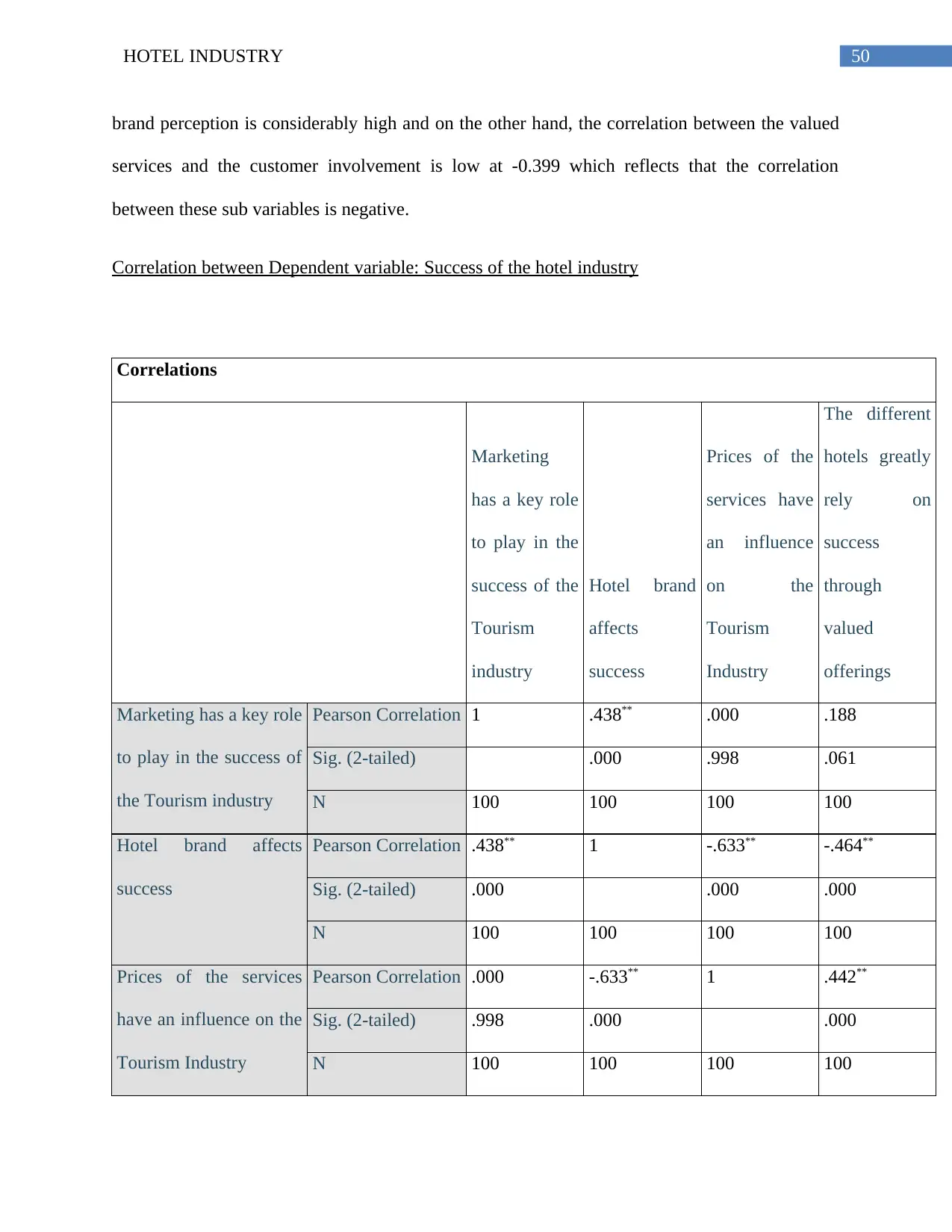
50HOTEL INDUSTRY
brand perception is considerably high and on the other hand, the correlation between the valued
services and the customer involvement is low at -0.399 which reflects that the correlation
between these sub variables is negative.
Correlation between Dependent variable: Success of the hotel industry
Correlations
Marketing
has a key role
to play in the
success of the
Tourism
industry
Hotel brand
affects
success
Prices of the
services have
an influence
on the
Tourism
Industry
The different
hotels greatly
rely on
success
through
valued
offerings
Marketing has a key role
to play in the success of
the Tourism industry
Pearson Correlation 1 .438** .000 .188
Sig. (2-tailed) .000 .998 .061
N 100 100 100 100
Hotel brand affects
success
Pearson Correlation .438** 1 -.633** -.464**
Sig. (2-tailed) .000 .000 .000
N 100 100 100 100
Prices of the services
have an influence on the
Tourism Industry
Pearson Correlation .000 -.633** 1 .442**
Sig. (2-tailed) .998 .000 .000
N 100 100 100 100
brand perception is considerably high and on the other hand, the correlation between the valued
services and the customer involvement is low at -0.399 which reflects that the correlation
between these sub variables is negative.
Correlation between Dependent variable: Success of the hotel industry
Correlations
Marketing
has a key role
to play in the
success of the
Tourism
industry
Hotel brand
affects
success
Prices of the
services have
an influence
on the
Tourism
Industry
The different
hotels greatly
rely on
success
through
valued
offerings
Marketing has a key role
to play in the success of
the Tourism industry
Pearson Correlation 1 .438** .000 .188
Sig. (2-tailed) .000 .998 .061
N 100 100 100 100
Hotel brand affects
success
Pearson Correlation .438** 1 -.633** -.464**
Sig. (2-tailed) .000 .000 .000
N 100 100 100 100
Prices of the services
have an influence on the
Tourism Industry
Pearson Correlation .000 -.633** 1 .442**
Sig. (2-tailed) .998 .000 .000
N 100 100 100 100
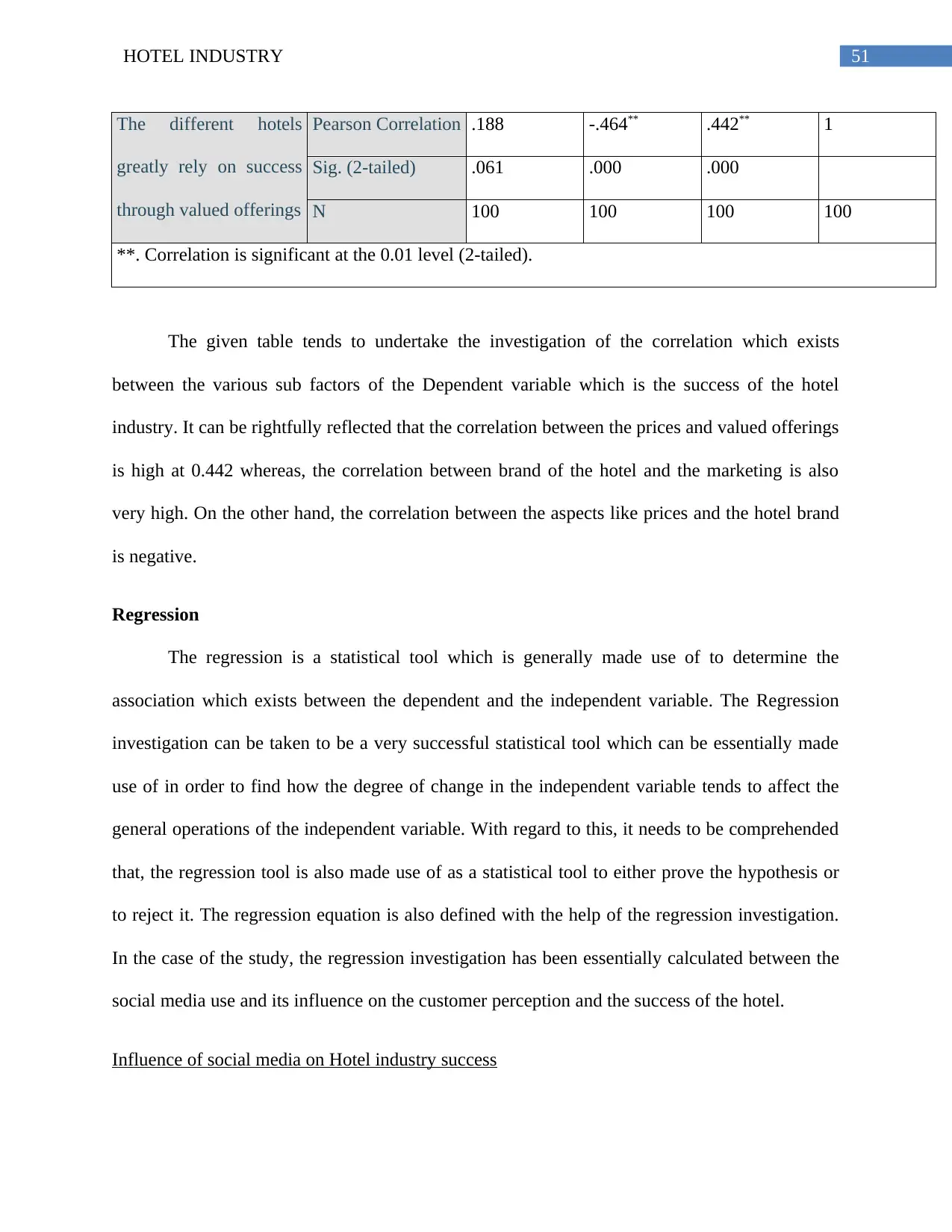
51HOTEL INDUSTRY
The different hotels
greatly rely on success
through valued offerings
Pearson Correlation .188 -.464** .442** 1
Sig. (2-tailed) .061 .000 .000
N 100 100 100 100
**. Correlation is significant at the 0.01 level (2-tailed).
The given table tends to undertake the investigation of the correlation which exists
between the various sub factors of the Dependent variable which is the success of the hotel
industry. It can be rightfully reflected that the correlation between the prices and valued offerings
is high at 0.442 whereas, the correlation between brand of the hotel and the marketing is also
very high. On the other hand, the correlation between the aspects like prices and the hotel brand
is negative.
Regression
The regression is a statistical tool which is generally made use of to determine the
association which exists between the dependent and the independent variable. The Regression
investigation can be taken to be a very successful statistical tool which can be essentially made
use of in order to find how the degree of change in the independent variable tends to affect the
general operations of the independent variable. With regard to this, it needs to be comprehended
that, the regression tool is also made use of as a statistical tool to either prove the hypothesis or
to reject it. The regression equation is also defined with the help of the regression investigation.
In the case of the study, the regression investigation has been essentially calculated between the
social media use and its influence on the customer perception and the success of the hotel.
Influence of social media on Hotel industry success
The different hotels
greatly rely on success
through valued offerings
Pearson Correlation .188 -.464** .442** 1
Sig. (2-tailed) .061 .000 .000
N 100 100 100 100
**. Correlation is significant at the 0.01 level (2-tailed).
The given table tends to undertake the investigation of the correlation which exists
between the various sub factors of the Dependent variable which is the success of the hotel
industry. It can be rightfully reflected that the correlation between the prices and valued offerings
is high at 0.442 whereas, the correlation between brand of the hotel and the marketing is also
very high. On the other hand, the correlation between the aspects like prices and the hotel brand
is negative.
Regression
The regression is a statistical tool which is generally made use of to determine the
association which exists between the dependent and the independent variable. The Regression
investigation can be taken to be a very successful statistical tool which can be essentially made
use of in order to find how the degree of change in the independent variable tends to affect the
general operations of the independent variable. With regard to this, it needs to be comprehended
that, the regression tool is also made use of as a statistical tool to either prove the hypothesis or
to reject it. The regression equation is also defined with the help of the regression investigation.
In the case of the study, the regression investigation has been essentially calculated between the
social media use and its influence on the customer perception and the success of the hotel.
Influence of social media on Hotel industry success
Secure Best Marks with AI Grader
Need help grading? Try our AI Grader for instant feedback on your assignments.
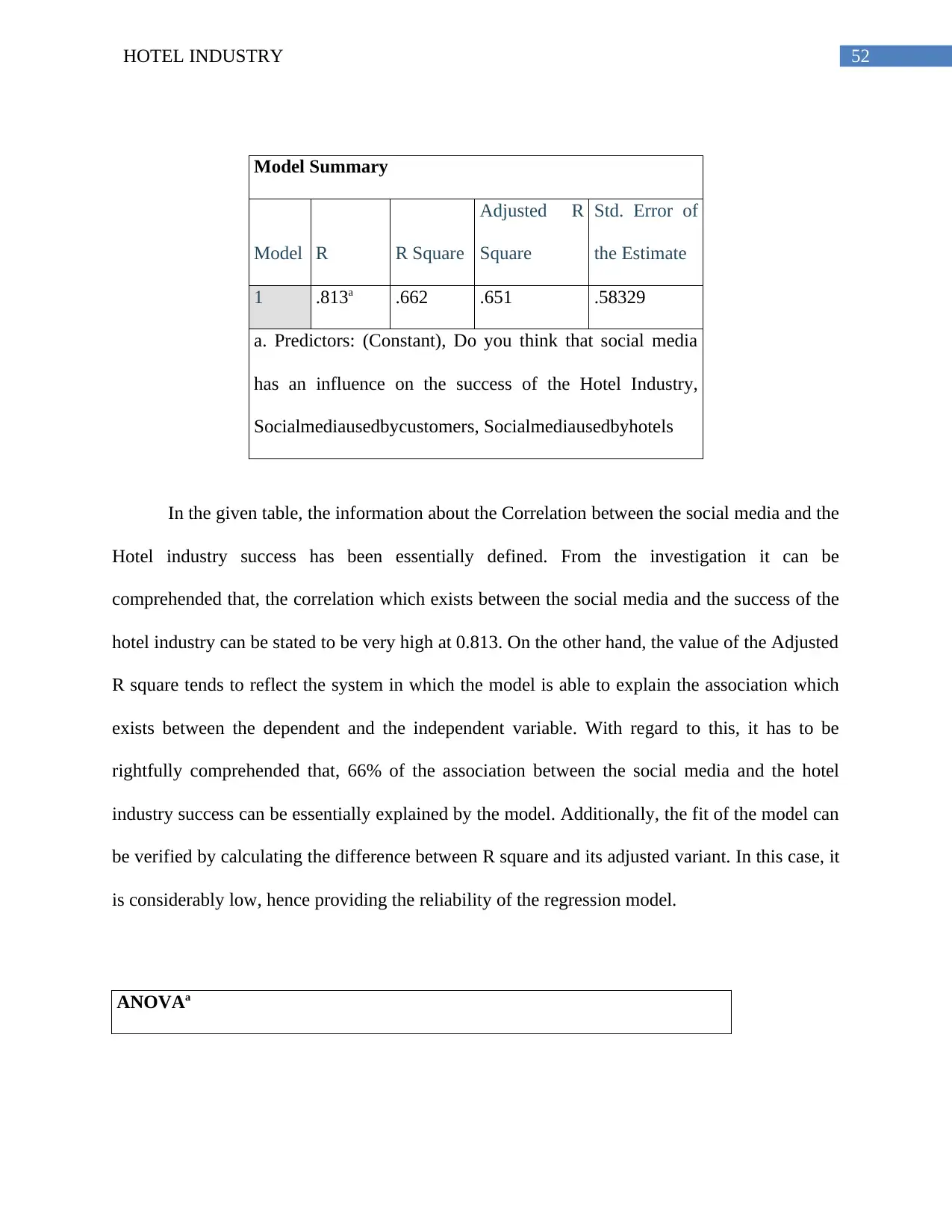
52HOTEL INDUSTRY
Model Summary
Model R R Square
Adjusted R
Square
Std. Error of
the Estimate
1 .813a .662 .651 .58329
a. Predictors: (Constant), Do you think that social media
has an influence on the success of the Hotel Industry,
Socialmediausedbycustomers, Socialmediausedbyhotels
In the given table, the information about the Correlation between the social media and the
Hotel industry success has been essentially defined. From the investigation it can be
comprehended that, the correlation which exists between the social media and the success of the
hotel industry can be stated to be very high at 0.813. On the other hand, the value of the Adjusted
R square tends to reflect the system in which the model is able to explain the association which
exists between the dependent and the independent variable. With regard to this, it has to be
rightfully comprehended that, 66% of the association between the social media and the hotel
industry success can be essentially explained by the model. Additionally, the fit of the model can
be verified by calculating the difference between R square and its adjusted variant. In this case, it
is considerably low, hence providing the reliability of the regression model.
ANOVAa
Model Summary
Model R R Square
Adjusted R
Square
Std. Error of
the Estimate
1 .813a .662 .651 .58329
a. Predictors: (Constant), Do you think that social media
has an influence on the success of the Hotel Industry,
Socialmediausedbycustomers, Socialmediausedbyhotels
In the given table, the information about the Correlation between the social media and the
Hotel industry success has been essentially defined. From the investigation it can be
comprehended that, the correlation which exists between the social media and the success of the
hotel industry can be stated to be very high at 0.813. On the other hand, the value of the Adjusted
R square tends to reflect the system in which the model is able to explain the association which
exists between the dependent and the independent variable. With regard to this, it has to be
rightfully comprehended that, 66% of the association between the social media and the hotel
industry success can be essentially explained by the model. Additionally, the fit of the model can
be verified by calculating the difference between R square and its adjusted variant. In this case, it
is considerably low, hence providing the reliability of the regression model.
ANOVAa
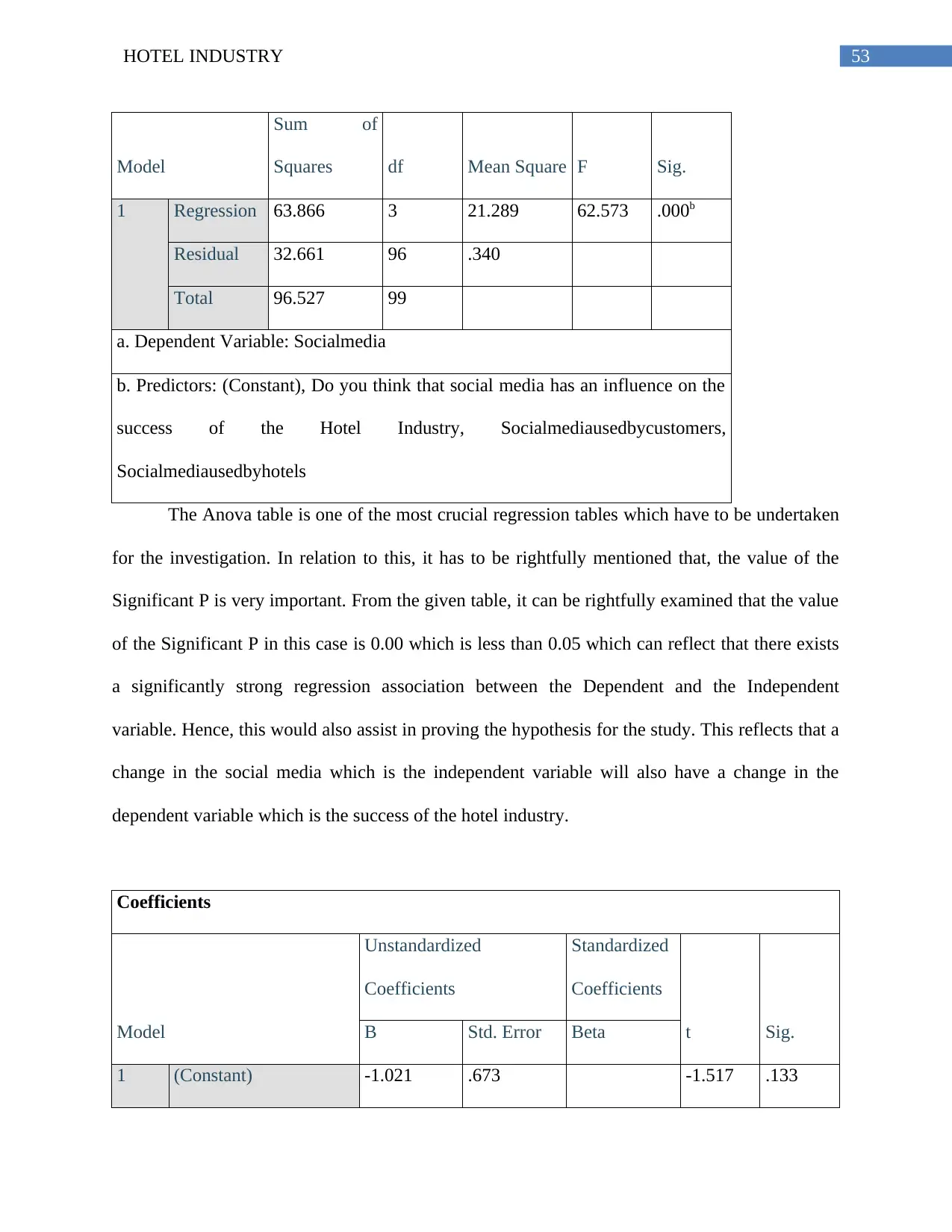
53HOTEL INDUSTRY
Model
Sum of
Squares df Mean Square F Sig.
1 Regression 63.866 3 21.289 62.573 .000b
Residual 32.661 96 .340
Total 96.527 99
a. Dependent Variable: Socialmedia
b. Predictors: (Constant), Do you think that social media has an influence on the
success of the Hotel Industry, Socialmediausedbycustomers,
Socialmediausedbyhotels
The Anova table is one of the most crucial regression tables which have to be undertaken
for the investigation. In relation to this, it has to be rightfully mentioned that, the value of the
Significant P is very important. From the given table, it can be rightfully examined that the value
of the Significant P in this case is 0.00 which is less than 0.05 which can reflect that there exists
a significantly strong regression association between the Dependent and the Independent
variable. Hence, this would also assist in proving the hypothesis for the study. This reflects that a
change in the social media which is the independent variable will also have a change in the
dependent variable which is the success of the hotel industry.
Coefficients
Model
Unstandardized
Coefficients
Standardized
Coefficients
t Sig.B Std. Error Beta
1 (Constant) -1.021 .673 -1.517 .133
Model
Sum of
Squares df Mean Square F Sig.
1 Regression 63.866 3 21.289 62.573 .000b
Residual 32.661 96 .340
Total 96.527 99
a. Dependent Variable: Socialmedia
b. Predictors: (Constant), Do you think that social media has an influence on the
success of the Hotel Industry, Socialmediausedbycustomers,
Socialmediausedbyhotels
The Anova table is one of the most crucial regression tables which have to be undertaken
for the investigation. In relation to this, it has to be rightfully mentioned that, the value of the
Significant P is very important. From the given table, it can be rightfully examined that the value
of the Significant P in this case is 0.00 which is less than 0.05 which can reflect that there exists
a significantly strong regression association between the Dependent and the Independent
variable. Hence, this would also assist in proving the hypothesis for the study. This reflects that a
change in the social media which is the independent variable will also have a change in the
dependent variable which is the success of the hotel industry.
Coefficients
Model
Unstandardized
Coefficients
Standardized
Coefficients
t Sig.B Std. Error Beta
1 (Constant) -1.021 .673 -1.517 .133

54HOTEL INDUSTRY
Socialmediausedbycust
omers
1.231 .094 .798 13.068 .000
Socialmediausedbyhote
ls
.083 .091 .056 .908 .366
Do you think that social
media has an influence
on the success of the
Hotel Industry
-.121 .118 -.061 -1.028 .306
a. Dependent Variable: Socialmedia
The given table provides the information about the dependent variable and the
independent variable and also defines the coefficient of the correlation which exists between the
different variables. The regression equation is also defined essentially.
Influence of social media on customer brand perception
Model Summary
Model R R Square
Adjusted R
Square
Std. Error of
the Estimate
1 .321a .103 .075 .67200
a. Predictors: (Constant), Do you think that social media
has an influence on the customer brand perception,
Socialmediausedbyhotels, Socialmediausedbycustomers
Socialmediausedbycust
omers
1.231 .094 .798 13.068 .000
Socialmediausedbyhote
ls
.083 .091 .056 .908 .366
Do you think that social
media has an influence
on the success of the
Hotel Industry
-.121 .118 -.061 -1.028 .306
a. Dependent Variable: Socialmedia
The given table provides the information about the dependent variable and the
independent variable and also defines the coefficient of the correlation which exists between the
different variables. The regression equation is also defined essentially.
Influence of social media on customer brand perception
Model Summary
Model R R Square
Adjusted R
Square
Std. Error of
the Estimate
1 .321a .103 .075 .67200
a. Predictors: (Constant), Do you think that social media
has an influence on the customer brand perception,
Socialmediausedbyhotels, Socialmediausedbycustomers
Paraphrase This Document
Need a fresh take? Get an instant paraphrase of this document with our AI Paraphraser
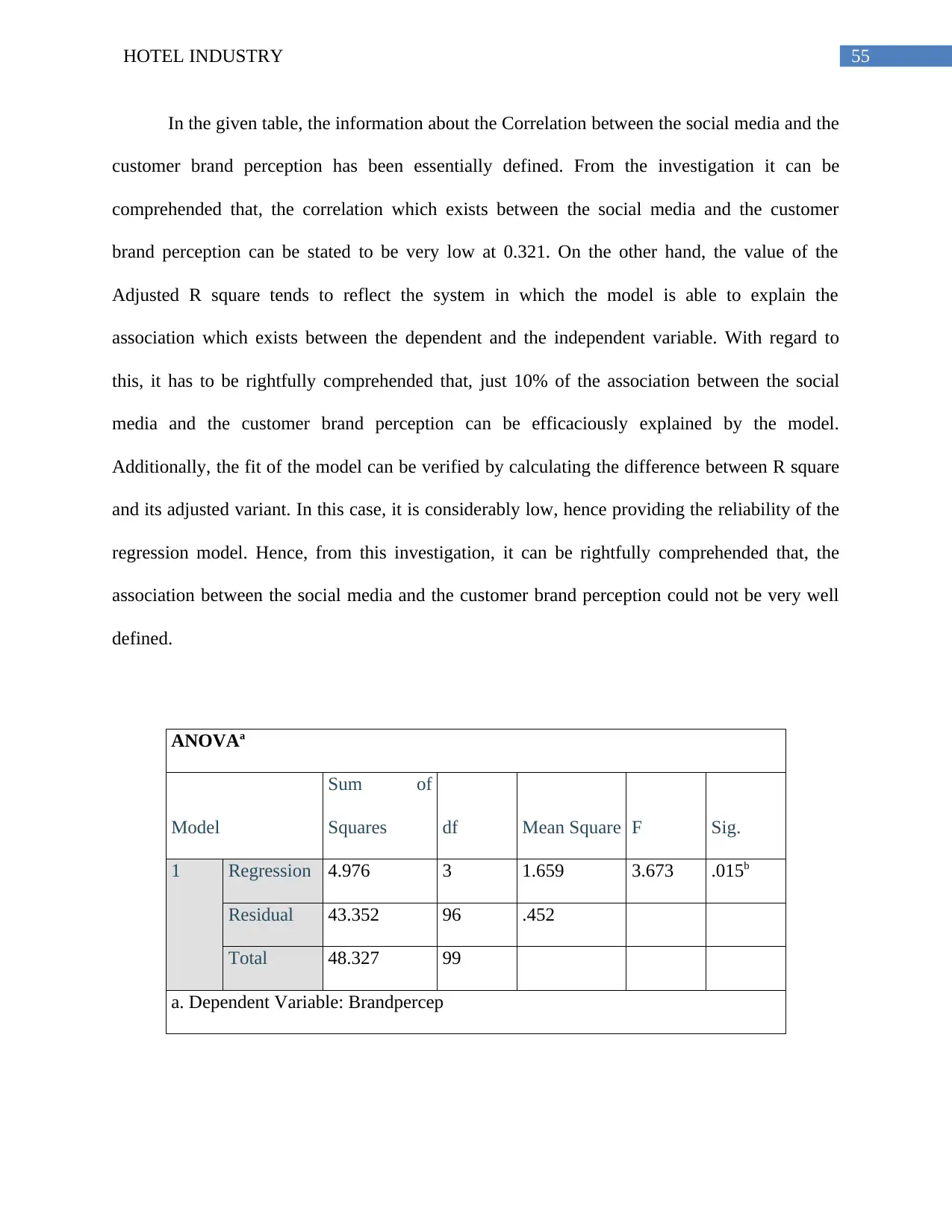
55HOTEL INDUSTRY
In the given table, the information about the Correlation between the social media and the
customer brand perception has been essentially defined. From the investigation it can be
comprehended that, the correlation which exists between the social media and the customer
brand perception can be stated to be very low at 0.321. On the other hand, the value of the
Adjusted R square tends to reflect the system in which the model is able to explain the
association which exists between the dependent and the independent variable. With regard to
this, it has to be rightfully comprehended that, just 10% of the association between the social
media and the customer brand perception can be efficaciously explained by the model.
Additionally, the fit of the model can be verified by calculating the difference between R square
and its adjusted variant. In this case, it is considerably low, hence providing the reliability of the
regression model. Hence, from this investigation, it can be rightfully comprehended that, the
association between the social media and the customer brand perception could not be very well
defined.
ANOVAa
Model
Sum of
Squares df Mean Square F Sig.
1 Regression 4.976 3 1.659 3.673 .015b
Residual 43.352 96 .452
Total 48.327 99
a. Dependent Variable: Brandpercep
In the given table, the information about the Correlation between the social media and the
customer brand perception has been essentially defined. From the investigation it can be
comprehended that, the correlation which exists between the social media and the customer
brand perception can be stated to be very low at 0.321. On the other hand, the value of the
Adjusted R square tends to reflect the system in which the model is able to explain the
association which exists between the dependent and the independent variable. With regard to
this, it has to be rightfully comprehended that, just 10% of the association between the social
media and the customer brand perception can be efficaciously explained by the model.
Additionally, the fit of the model can be verified by calculating the difference between R square
and its adjusted variant. In this case, it is considerably low, hence providing the reliability of the
regression model. Hence, from this investigation, it can be rightfully comprehended that, the
association between the social media and the customer brand perception could not be very well
defined.
ANOVAa
Model
Sum of
Squares df Mean Square F Sig.
1 Regression 4.976 3 1.659 3.673 .015b
Residual 43.352 96 .452
Total 48.327 99
a. Dependent Variable: Brandpercep

56HOTEL INDUSTRY
b. Predictors: (Constant), Do you think that social media has an impact on the
customer brand perception, Socialmediausedbyhotels,
Socialmediausedbycustomers
The Anova table is one of the most crucial regression tables which have to be undertaken
for the investigation. In relation to this, it has to be rightfully mentioned that, the value of the
Significant P is very crucial. From the given table, it can be rightfully examined that the value of
the Significant P in this case is 0.015 which is less than 0.05 which can reflect that there exists a
significantly strong regression association between the Dependent and the Independent variable.
Hence, this would also assist in proving the hypothesis for the study. This reflects that a change
in the social media which is the independent variable will also have a change in the dependent
variable which is the customer brand perception.
Coefficientsa
Model
Unstandardized
Coefficients
Standardized
Coefficients
t Sig.B Std. Error Beta
1 (Constant) 2.365 .522 4.534 .000
Socialmediausedbycust
omers
.378 .127 .346 2.972 .004
Socialmediausedbyhote
ls
.107 .105 .102 1.013 .314
b. Predictors: (Constant), Do you think that social media has an impact on the
customer brand perception, Socialmediausedbyhotels,
Socialmediausedbycustomers
The Anova table is one of the most crucial regression tables which have to be undertaken
for the investigation. In relation to this, it has to be rightfully mentioned that, the value of the
Significant P is very crucial. From the given table, it can be rightfully examined that the value of
the Significant P in this case is 0.015 which is less than 0.05 which can reflect that there exists a
significantly strong regression association between the Dependent and the Independent variable.
Hence, this would also assist in proving the hypothesis for the study. This reflects that a change
in the social media which is the independent variable will also have a change in the dependent
variable which is the customer brand perception.
Coefficientsa
Model
Unstandardized
Coefficients
Standardized
Coefficients
t Sig.B Std. Error Beta
1 (Constant) 2.365 .522 4.534 .000
Socialmediausedbycust
omers
.378 .127 .346 2.972 .004
Socialmediausedbyhote
ls
.107 .105 .102 1.013 .314

57HOTEL INDUSTRY
Do you think that social
media has an impact on
the customer brand
perception
-.087 .061 -.166 -1.421 .159
a. Dependent Variable: Brandpercep
The given table provides the information about the dependent variable and the independent
variable and also defines the coefficient of the correlation which exists between the different
variables. The regression equation is also defined essentially.
Hypothesis testing
Therefore, as the hypothesis testing has already been provided with the help of the
Regression investigation, in this section the hypothesis between the dependent and the
independent variable will be proved accordingly.
Hypothesis 1: The impact of social media on the success of the Hotel industry
H1: The social media has a very strong impact on the success of the hotel industry
H0: The social media does not have a strong impact on the success of the hotel industry.
Hence, as the value of the Significant P during the regression investigation came up to
0.00 which is very less than 0.05, it has to be comprehended that the null hypothesis has been
rejected and the alternate hypothesis has to be accepted which thereby proves that the social
media usage by the firm and the customers has a very strong impact on the success of the Hotel
industry as a whole.
Do you think that social
media has an impact on
the customer brand
perception
-.087 .061 -.166 -1.421 .159
a. Dependent Variable: Brandpercep
The given table provides the information about the dependent variable and the independent
variable and also defines the coefficient of the correlation which exists between the different
variables. The regression equation is also defined essentially.
Hypothesis testing
Therefore, as the hypothesis testing has already been provided with the help of the
Regression investigation, in this section the hypothesis between the dependent and the
independent variable will be proved accordingly.
Hypothesis 1: The impact of social media on the success of the Hotel industry
H1: The social media has a very strong impact on the success of the hotel industry
H0: The social media does not have a strong impact on the success of the hotel industry.
Hence, as the value of the Significant P during the regression investigation came up to
0.00 which is very less than 0.05, it has to be comprehended that the null hypothesis has been
rejected and the alternate hypothesis has to be accepted which thereby proves that the social
media usage by the firm and the customers has a very strong impact on the success of the Hotel
industry as a whole.
Secure Best Marks with AI Grader
Need help grading? Try our AI Grader for instant feedback on your assignments.
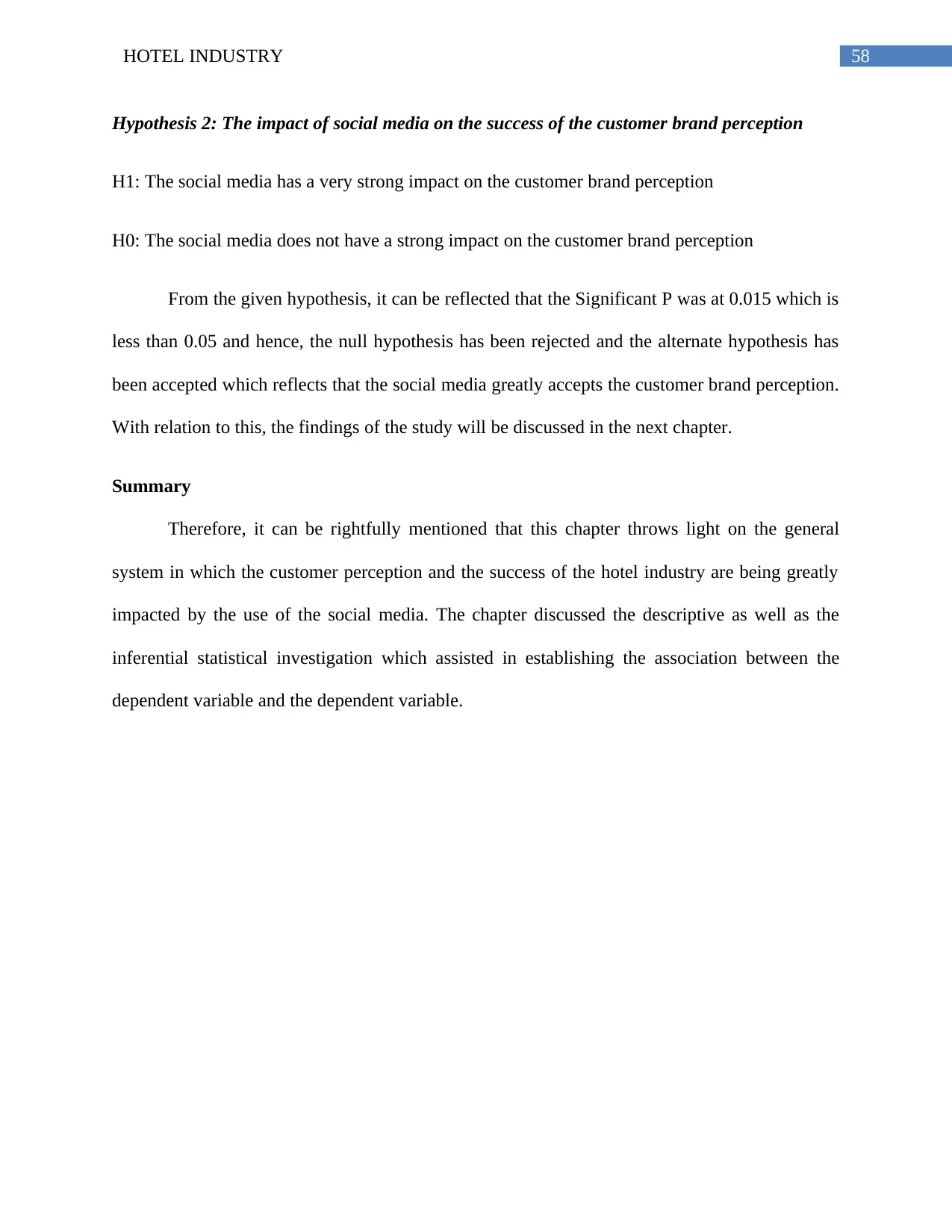
58HOTEL INDUSTRY
Hypothesis 2: The impact of social media on the success of the customer brand perception
H1: The social media has a very strong impact on the customer brand perception
H0: The social media does not have a strong impact on the customer brand perception
From the given hypothesis, it can be reflected that the Significant P was at 0.015 which is
less than 0.05 and hence, the null hypothesis has been rejected and the alternate hypothesis has
been accepted which reflects that the social media greatly accepts the customer brand perception.
With relation to this, the findings of the study will be discussed in the next chapter.
Summary
Therefore, it can be rightfully mentioned that this chapter throws light on the general
system in which the customer perception and the success of the hotel industry are being greatly
impacted by the use of the social media. The chapter discussed the descriptive as well as the
inferential statistical investigation which assisted in establishing the association between the
dependent variable and the dependent variable.
Hypothesis 2: The impact of social media on the success of the customer brand perception
H1: The social media has a very strong impact on the customer brand perception
H0: The social media does not have a strong impact on the customer brand perception
From the given hypothesis, it can be reflected that the Significant P was at 0.015 which is
less than 0.05 and hence, the null hypothesis has been rejected and the alternate hypothesis has
been accepted which reflects that the social media greatly accepts the customer brand perception.
With relation to this, the findings of the study will be discussed in the next chapter.
Summary
Therefore, it can be rightfully mentioned that this chapter throws light on the general
system in which the customer perception and the success of the hotel industry are being greatly
impacted by the use of the social media. The chapter discussed the descriptive as well as the
inferential statistical investigation which assisted in establishing the association between the
dependent variable and the dependent variable.

59HOTEL INDUSTRY
Chapter 5: Investigation and Discussion
Overview
The previous chapter threw light on the results which were a product of the Regression
investigation which had taken place (Jansen 2018). With reverence to this, it can be mentioned
that the primary objective of the given chapter is to highlight and comprehend the system in
which the social media has affected the success of the hotel industry and to identify the different
ways in which the social media as a tool will have an impact on the general way in which the
customer perceive the brand. Hence, in this chapter of the dissertation, the findings of the study
will be discussed which will then be followed by the discussion related to the study.
Findings of the study
The findings of the study with the help of the Literature review and the Statistical
investigation which was conducted in the study has been defined as follows:
The Social media has become considerably popular and it is due to this reason why it has
become very important for the firms involved in the different industries to see to it that
they are efficaciously able to engage in a long term association with the different
customers with the help of the social media as a tool as this will enable the firm to be
efficaciously able to engage in long term success.
The hotel industry has been changing to a great extent and it is in relation to this tat it
becomes considerably crucial for the industry to take up the new and modern means of
development which will enable the different hotels to certify that they are being able to
succeed and attain a competitive advantage in the long run (Jansen 2018).. Additionally,
it also becomes relevant for the firm to see to it that, they are being able to conversate
Chapter 5: Investigation and Discussion
Overview
The previous chapter threw light on the results which were a product of the Regression
investigation which had taken place (Jansen 2018). With reverence to this, it can be mentioned
that the primary objective of the given chapter is to highlight and comprehend the system in
which the social media has affected the success of the hotel industry and to identify the different
ways in which the social media as a tool will have an impact on the general way in which the
customer perceive the brand. Hence, in this chapter of the dissertation, the findings of the study
will be discussed which will then be followed by the discussion related to the study.
Findings of the study
The findings of the study with the help of the Literature review and the Statistical
investigation which was conducted in the study has been defined as follows:
The Social media has become considerably popular and it is due to this reason why it has
become very important for the firms involved in the different industries to see to it that
they are efficaciously able to engage in a long term association with the different
customers with the help of the social media as a tool as this will enable the firm to be
efficaciously able to engage in long term success.
The hotel industry has been changing to a great extent and it is in relation to this tat it
becomes considerably crucial for the industry to take up the new and modern means of
development which will enable the different hotels to certify that they are being able to
succeed and attain a competitive advantage in the long run (Jansen 2018).. Additionally,
it also becomes relevant for the firm to see to it that, they are being able to conversate
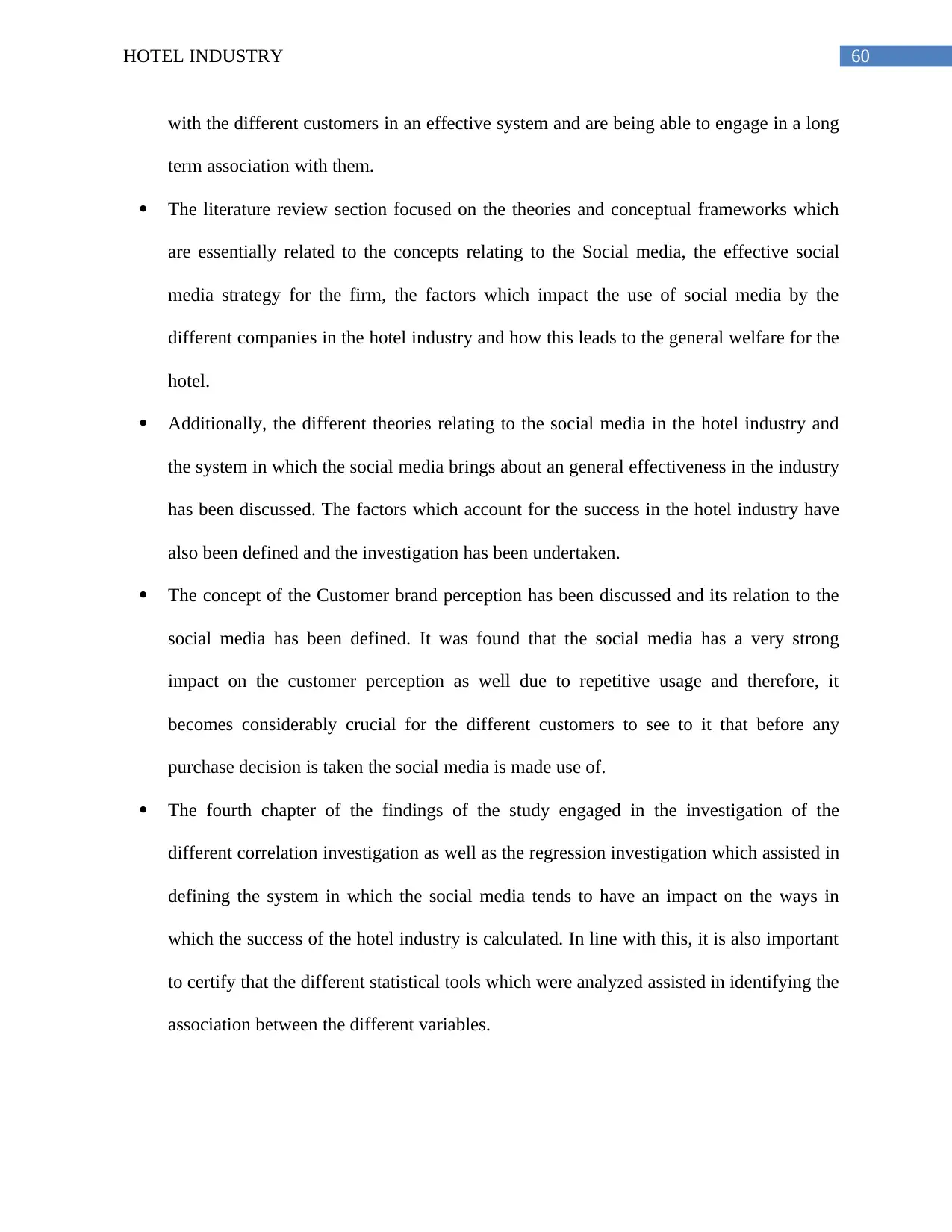
60HOTEL INDUSTRY
with the different customers in an effective system and are being able to engage in a long
term association with them.
The literature review section focused on the theories and conceptual frameworks which
are essentially related to the concepts relating to the Social media, the effective social
media strategy for the firm, the factors which impact the use of social media by the
different companies in the hotel industry and how this leads to the general welfare for the
hotel.
Additionally, the different theories relating to the social media in the hotel industry and
the system in which the social media brings about an general effectiveness in the industry
has been discussed. The factors which account for the success in the hotel industry have
also been defined and the investigation has been undertaken.
The concept of the Customer brand perception has been discussed and its relation to the
social media has been defined. It was found that the social media has a very strong
impact on the customer perception as well due to repetitive usage and therefore, it
becomes considerably crucial for the different customers to see to it that before any
purchase decision is taken the social media is made use of.
The fourth chapter of the findings of the study engaged in the investigation of the
different correlation investigation as well as the regression investigation which assisted in
defining the system in which the social media tends to have an impact on the ways in
which the success of the hotel industry is calculated. In line with this, it is also important
to certify that the different statistical tools which were analyzed assisted in identifying the
association between the different variables.
with the different customers in an effective system and are being able to engage in a long
term association with them.
The literature review section focused on the theories and conceptual frameworks which
are essentially related to the concepts relating to the Social media, the effective social
media strategy for the firm, the factors which impact the use of social media by the
different companies in the hotel industry and how this leads to the general welfare for the
hotel.
Additionally, the different theories relating to the social media in the hotel industry and
the system in which the social media brings about an general effectiveness in the industry
has been discussed. The factors which account for the success in the hotel industry have
also been defined and the investigation has been undertaken.
The concept of the Customer brand perception has been discussed and its relation to the
social media has been defined. It was found that the social media has a very strong
impact on the customer perception as well due to repetitive usage and therefore, it
becomes considerably crucial for the different customers to see to it that before any
purchase decision is taken the social media is made use of.
The fourth chapter of the findings of the study engaged in the investigation of the
different correlation investigation as well as the regression investigation which assisted in
defining the system in which the social media tends to have an impact on the ways in
which the success of the hotel industry is calculated. In line with this, it is also important
to certify that the different statistical tools which were analyzed assisted in identifying the
association between the different variables.
Paraphrase This Document
Need a fresh take? Get an instant paraphrase of this document with our AI Paraphraser
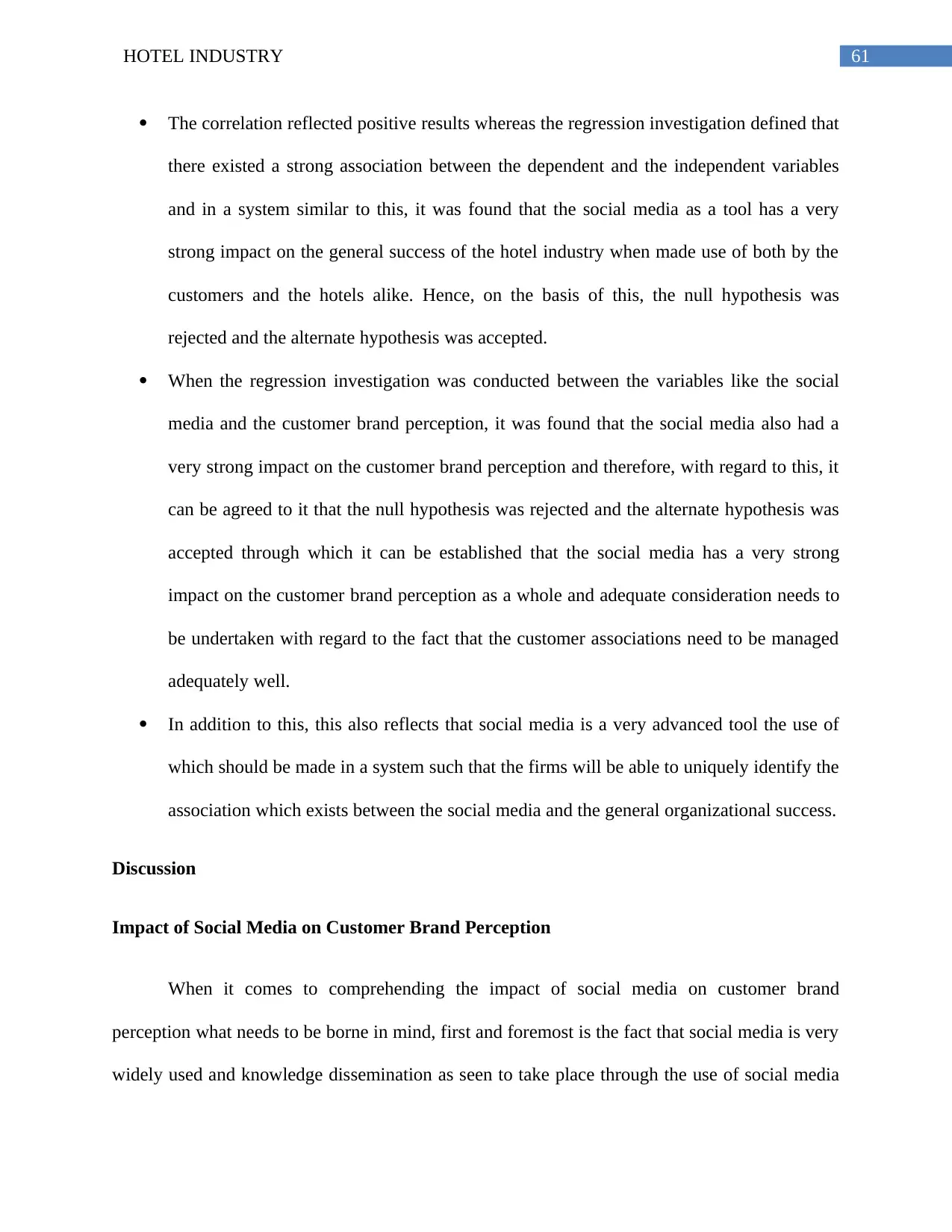
61HOTEL INDUSTRY
The correlation reflected positive results whereas the regression investigation defined that
there existed a strong association between the dependent and the independent variables
and in a system similar to this, it was found that the social media as a tool has a very
strong impact on the general success of the hotel industry when made use of both by the
customers and the hotels alike. Hence, on the basis of this, the null hypothesis was
rejected and the alternate hypothesis was accepted.
When the regression investigation was conducted between the variables like the social
media and the customer brand perception, it was found that the social media also had a
very strong impact on the customer brand perception and therefore, with regard to this, it
can be agreed to it that the null hypothesis was rejected and the alternate hypothesis was
accepted through which it can be established that the social media has a very strong
impact on the customer brand perception as a whole and adequate consideration needs to
be undertaken with regard to the fact that the customer associations need to be managed
adequately well.
In addition to this, this also reflects that social media is a very advanced tool the use of
which should be made in a system such that the firms will be able to uniquely identify the
association which exists between the social media and the general organizational success.
Discussion
Impact of Social Media on Customer Brand Perception
When it comes to comprehending the impact of social media on customer brand
perception what needs to be borne in mind, first and foremost is the fact that social media is very
widely used and knowledge dissemination as seen to take place through the use of social media
The correlation reflected positive results whereas the regression investigation defined that
there existed a strong association between the dependent and the independent variables
and in a system similar to this, it was found that the social media as a tool has a very
strong impact on the general success of the hotel industry when made use of both by the
customers and the hotels alike. Hence, on the basis of this, the null hypothesis was
rejected and the alternate hypothesis was accepted.
When the regression investigation was conducted between the variables like the social
media and the customer brand perception, it was found that the social media also had a
very strong impact on the customer brand perception and therefore, with regard to this, it
can be agreed to it that the null hypothesis was rejected and the alternate hypothesis was
accepted through which it can be established that the social media has a very strong
impact on the customer brand perception as a whole and adequate consideration needs to
be undertaken with regard to the fact that the customer associations need to be managed
adequately well.
In addition to this, this also reflects that social media is a very advanced tool the use of
which should be made in a system such that the firms will be able to uniquely identify the
association which exists between the social media and the general organizational success.
Discussion
Impact of Social Media on Customer Brand Perception
When it comes to comprehending the impact of social media on customer brand
perception what needs to be borne in mind, first and foremost is the fact that social media is very
widely used and knowledge dissemination as seen to take place through the use of social media
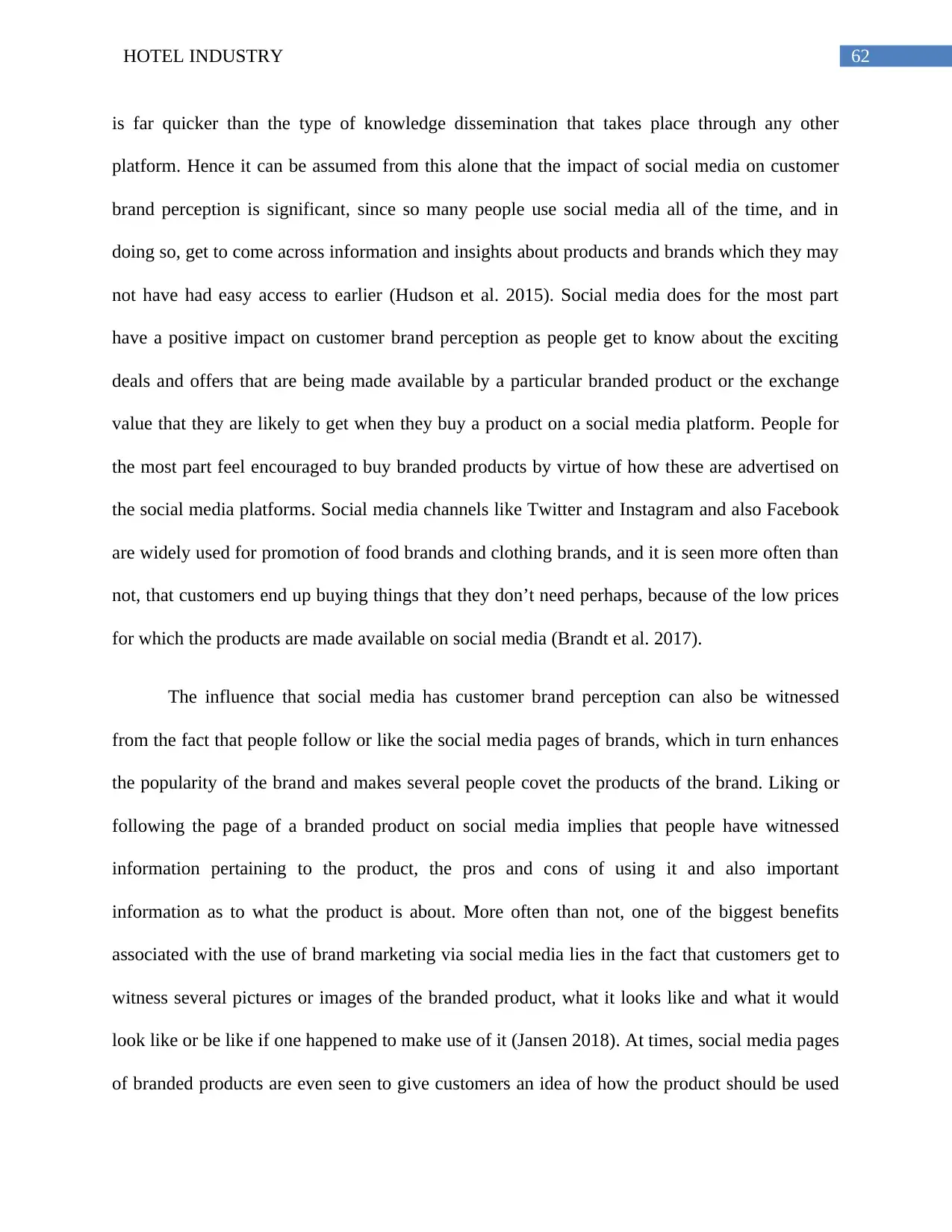
62HOTEL INDUSTRY
is far quicker than the type of knowledge dissemination that takes place through any other
platform. Hence it can be assumed from this alone that the impact of social media on customer
brand perception is significant, since so many people use social media all of the time, and in
doing so, get to come across information and insights about products and brands which they may
not have had easy access to earlier (Hudson et al. 2015). Social media does for the most part
have a positive impact on customer brand perception as people get to know about the exciting
deals and offers that are being made available by a particular branded product or the exchange
value that they are likely to get when they buy a product on a social media platform. People for
the most part feel encouraged to buy branded products by virtue of how these are advertised on
the social media platforms. Social media channels like Twitter and Instagram and also Facebook
are widely used for promotion of food brands and clothing brands, and it is seen more often than
not, that customers end up buying things that they don’t need perhaps, because of the low prices
for which the products are made available on social media (Brandt et al. 2017).
The influence that social media has customer brand perception can also be witnessed
from the fact that people follow or like the social media pages of brands, which in turn enhances
the popularity of the brand and makes several people covet the products of the brand. Liking or
following the page of a branded product on social media implies that people have witnessed
information pertaining to the product, the pros and cons of using it and also important
information as to what the product is about. More often than not, one of the biggest benefits
associated with the use of brand marketing via social media lies in the fact that customers get to
witness several pictures or images of the branded product, what it looks like and what it would
look like or be like if one happened to make use of it (Jansen 2018). At times, social media pages
of branded products are even seen to give customers an idea of how the product should be used
is far quicker than the type of knowledge dissemination that takes place through any other
platform. Hence it can be assumed from this alone that the impact of social media on customer
brand perception is significant, since so many people use social media all of the time, and in
doing so, get to come across information and insights about products and brands which they may
not have had easy access to earlier (Hudson et al. 2015). Social media does for the most part
have a positive impact on customer brand perception as people get to know about the exciting
deals and offers that are being made available by a particular branded product or the exchange
value that they are likely to get when they buy a product on a social media platform. People for
the most part feel encouraged to buy branded products by virtue of how these are advertised on
the social media platforms. Social media channels like Twitter and Instagram and also Facebook
are widely used for promotion of food brands and clothing brands, and it is seen more often than
not, that customers end up buying things that they don’t need perhaps, because of the low prices
for which the products are made available on social media (Brandt et al. 2017).
The influence that social media has customer brand perception can also be witnessed
from the fact that people follow or like the social media pages of brands, which in turn enhances
the popularity of the brand and makes several people covet the products of the brand. Liking or
following the page of a branded product on social media implies that people have witnessed
information pertaining to the product, the pros and cons of using it and also important
information as to what the product is about. More often than not, one of the biggest benefits
associated with the use of brand marketing via social media lies in the fact that customers get to
witness several pictures or images of the branded product, what it looks like and what it would
look like or be like if one happened to make use of it (Jansen 2018). At times, social media pages
of branded products are even seen to give customers an idea of how the product should be used
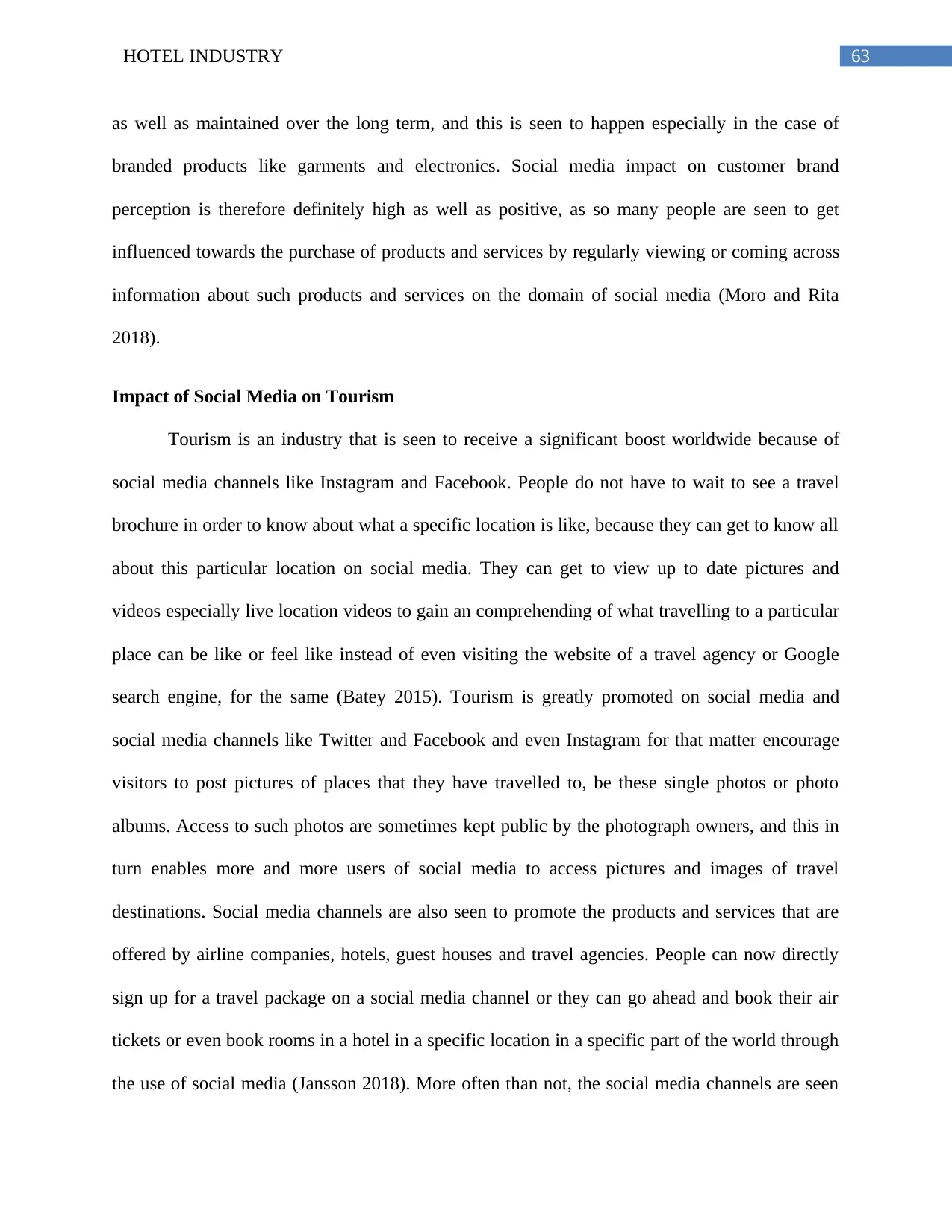
63HOTEL INDUSTRY
as well as maintained over the long term, and this is seen to happen especially in the case of
branded products like garments and electronics. Social media impact on customer brand
perception is therefore definitely high as well as positive, as so many people are seen to get
influenced towards the purchase of products and services by regularly viewing or coming across
information about such products and services on the domain of social media (Moro and Rita
2018).
Impact of Social Media on Tourism
Tourism is an industry that is seen to receive a significant boost worldwide because of
social media channels like Instagram and Facebook. People do not have to wait to see a travel
brochure in order to know about what a specific location is like, because they can get to know all
about this particular location on social media. They can get to view up to date pictures and
videos especially live location videos to gain an comprehending of what travelling to a particular
place can be like or feel like instead of even visiting the website of a travel agency or Google
search engine, for the same (Batey 2015). Tourism is greatly promoted on social media and
social media channels like Twitter and Facebook and even Instagram for that matter encourage
visitors to post pictures of places that they have travelled to, be these single photos or photo
albums. Access to such photos are sometimes kept public by the photograph owners, and this in
turn enables more and more users of social media to access pictures and images of travel
destinations. Social media channels are also seen to promote the products and services that are
offered by airline companies, hotels, guest houses and travel agencies. People can now directly
sign up for a travel package on a social media channel or they can go ahead and book their air
tickets or even book rooms in a hotel in a specific location in a specific part of the world through
the use of social media (Jansson 2018). More often than not, the social media channels are seen
as well as maintained over the long term, and this is seen to happen especially in the case of
branded products like garments and electronics. Social media impact on customer brand
perception is therefore definitely high as well as positive, as so many people are seen to get
influenced towards the purchase of products and services by regularly viewing or coming across
information about such products and services on the domain of social media (Moro and Rita
2018).
Impact of Social Media on Tourism
Tourism is an industry that is seen to receive a significant boost worldwide because of
social media channels like Instagram and Facebook. People do not have to wait to see a travel
brochure in order to know about what a specific location is like, because they can get to know all
about this particular location on social media. They can get to view up to date pictures and
videos especially live location videos to gain an comprehending of what travelling to a particular
place can be like or feel like instead of even visiting the website of a travel agency or Google
search engine, for the same (Batey 2015). Tourism is greatly promoted on social media and
social media channels like Twitter and Facebook and even Instagram for that matter encourage
visitors to post pictures of places that they have travelled to, be these single photos or photo
albums. Access to such photos are sometimes kept public by the photograph owners, and this in
turn enables more and more users of social media to access pictures and images of travel
destinations. Social media channels are also seen to promote the products and services that are
offered by airline companies, hotels, guest houses and travel agencies. People can now directly
sign up for a travel package on a social media channel or they can go ahead and book their air
tickets or even book rooms in a hotel in a specific location in a specific part of the world through
the use of social media (Jansson 2018). More often than not, the social media channels are seen
Secure Best Marks with AI Grader
Need help grading? Try our AI Grader for instant feedback on your assignments.

64HOTEL INDUSTRY
to offer great deals and discounts for customers who book their stay at a particular chain of
hotels or a particular brand of accommodation or guest housing, giving travelers the option to
save a lot of money and thus have an even more splendid travel experience than they otherwise
would have. Crucial information about places to visit, sightseeing destinations, places to dine at
in the locations that people are undertaking travel to are all made available quickly and easily
through the medium of social media. People also get to post their feedback about their stay at
resorts and hotels via social media channels which in turn gives other viewers and users of social
media an idea of the place that has been visited and whether or not they should consider going
there (Hansen et al. 2018).
The popularity of tourist destinations and locations is also something that is significantly
enhanced through the use of social media platforms like Twitter and Facebook. The more likes or
follows that the page of a specific location is seen to get on any one or both of these platforms,
the more popular in terms of tourist footfall the location is deemed to be (Cutler and Culotta
2017).
Thus it can be stated that social media has a positive and high impact on generating
tourist footfall in important locations and as such influences the growth and development of the
tourism industry quite significantly.
to offer great deals and discounts for customers who book their stay at a particular chain of
hotels or a particular brand of accommodation or guest housing, giving travelers the option to
save a lot of money and thus have an even more splendid travel experience than they otherwise
would have. Crucial information about places to visit, sightseeing destinations, places to dine at
in the locations that people are undertaking travel to are all made available quickly and easily
through the medium of social media. People also get to post their feedback about their stay at
resorts and hotels via social media channels which in turn gives other viewers and users of social
media an idea of the place that has been visited and whether or not they should consider going
there (Hansen et al. 2018).
The popularity of tourist destinations and locations is also something that is significantly
enhanced through the use of social media platforms like Twitter and Facebook. The more likes or
follows that the page of a specific location is seen to get on any one or both of these platforms,
the more popular in terms of tourist footfall the location is deemed to be (Cutler and Culotta
2017).
Thus it can be stated that social media has a positive and high impact on generating
tourist footfall in important locations and as such influences the growth and development of the
tourism industry quite significantly.
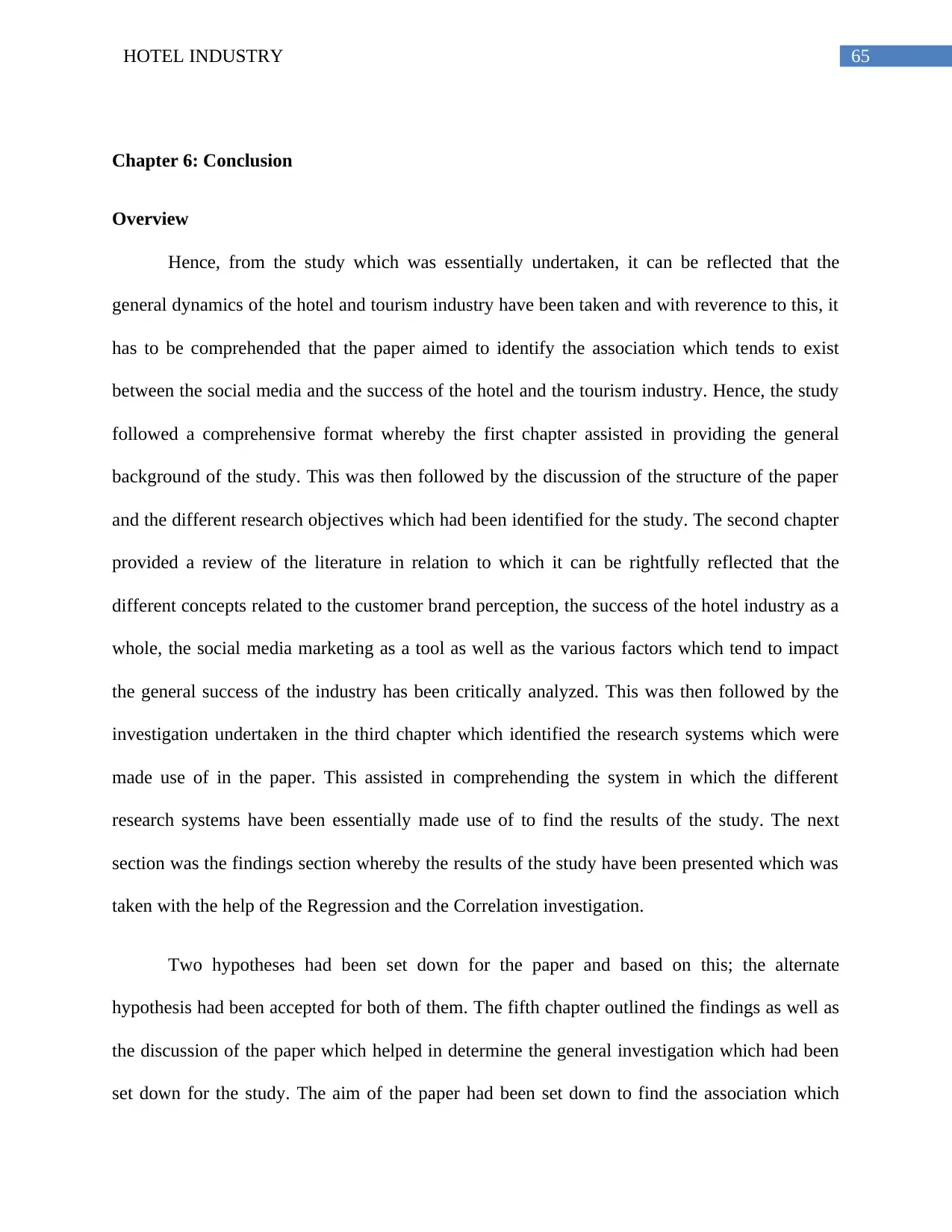
65HOTEL INDUSTRY
Chapter 6: Conclusion
Overview
Hence, from the study which was essentially undertaken, it can be reflected that the
general dynamics of the hotel and tourism industry have been taken and with reverence to this, it
has to be comprehended that the paper aimed to identify the association which tends to exist
between the social media and the success of the hotel and the tourism industry. Hence, the study
followed a comprehensive format whereby the first chapter assisted in providing the general
background of the study. This was then followed by the discussion of the structure of the paper
and the different research objectives which had been identified for the study. The second chapter
provided a review of the literature in relation to which it can be rightfully reflected that the
different concepts related to the customer brand perception, the success of the hotel industry as a
whole, the social media marketing as a tool as well as the various factors which tend to impact
the general success of the industry has been critically analyzed. This was then followed by the
investigation undertaken in the third chapter which identified the research systems which were
made use of in the paper. This assisted in comprehending the system in which the different
research systems have been essentially made use of to find the results of the study. The next
section was the findings section whereby the results of the study have been presented which was
taken with the help of the Regression and the Correlation investigation.
Two hypotheses had been set down for the paper and based on this; the alternate
hypothesis had been accepted for both of them. The fifth chapter outlined the findings as well as
the discussion of the paper which helped in determine the general investigation which had been
set down for the study. The aim of the paper had been set down to find the association which
Chapter 6: Conclusion
Overview
Hence, from the study which was essentially undertaken, it can be reflected that the
general dynamics of the hotel and tourism industry have been taken and with reverence to this, it
has to be comprehended that the paper aimed to identify the association which tends to exist
between the social media and the success of the hotel and the tourism industry. Hence, the study
followed a comprehensive format whereby the first chapter assisted in providing the general
background of the study. This was then followed by the discussion of the structure of the paper
and the different research objectives which had been identified for the study. The second chapter
provided a review of the literature in relation to which it can be rightfully reflected that the
different concepts related to the customer brand perception, the success of the hotel industry as a
whole, the social media marketing as a tool as well as the various factors which tend to impact
the general success of the industry has been critically analyzed. This was then followed by the
investigation undertaken in the third chapter which identified the research systems which were
made use of in the paper. This assisted in comprehending the system in which the different
research systems have been essentially made use of to find the results of the study. The next
section was the findings section whereby the results of the study have been presented which was
taken with the help of the Regression and the Correlation investigation.
Two hypotheses had been set down for the paper and based on this; the alternate
hypothesis had been accepted for both of them. The fifth chapter outlined the findings as well as
the discussion of the paper which helped in determine the general investigation which had been
set down for the study. The aim of the paper had been set down to find the association which

66HOTEL INDUSTRY
exists between the dependent and the independent variable which was established in the fourth
chapter whereby the null hypothesis has been rejected and hence, the association between the
different variables has been accepted. Hence, the objectives have been efficaciously attained
which aimed to find the association which exists between the customer satisfaction, the hotel
industry success and the brand perception of the different customers.
Limitations
The limitations of the study can be stated to be as follows:
1. The primary quantitative method of research has been undertaken which reflects that, the
investigation aspect of the study can be stated to be considerably limited in nature. This
defines that, the study has only been conducted from a single perspective and in relation
to this; the lack of the qualitative investigation on the data is a limitation.
2. The number of participants involved in the research can be taken to be very low and
hence, with regard to this, the shortage in the sample size can be taken to be a limitation
in the study.
Future scope
In the future, any researcher might plan to undertake a research based on the same topic
and domain with the help of qualitative investigation and this will then provide a clear image of
the impact of social media on the success of the hotel industry.
exists between the dependent and the independent variable which was established in the fourth
chapter whereby the null hypothesis has been rejected and hence, the association between the
different variables has been accepted. Hence, the objectives have been efficaciously attained
which aimed to find the association which exists between the customer satisfaction, the hotel
industry success and the brand perception of the different customers.
Limitations
The limitations of the study can be stated to be as follows:
1. The primary quantitative method of research has been undertaken which reflects that, the
investigation aspect of the study can be stated to be considerably limited in nature. This
defines that, the study has only been conducted from a single perspective and in relation
to this; the lack of the qualitative investigation on the data is a limitation.
2. The number of participants involved in the research can be taken to be very low and
hence, with regard to this, the shortage in the sample size can be taken to be a limitation
in the study.
Future scope
In the future, any researcher might plan to undertake a research based on the same topic
and domain with the help of qualitative investigation and this will then provide a clear image of
the impact of social media on the success of the hotel industry.
Paraphrase This Document
Need a fresh take? Get an instant paraphrase of this document with our AI Paraphraser
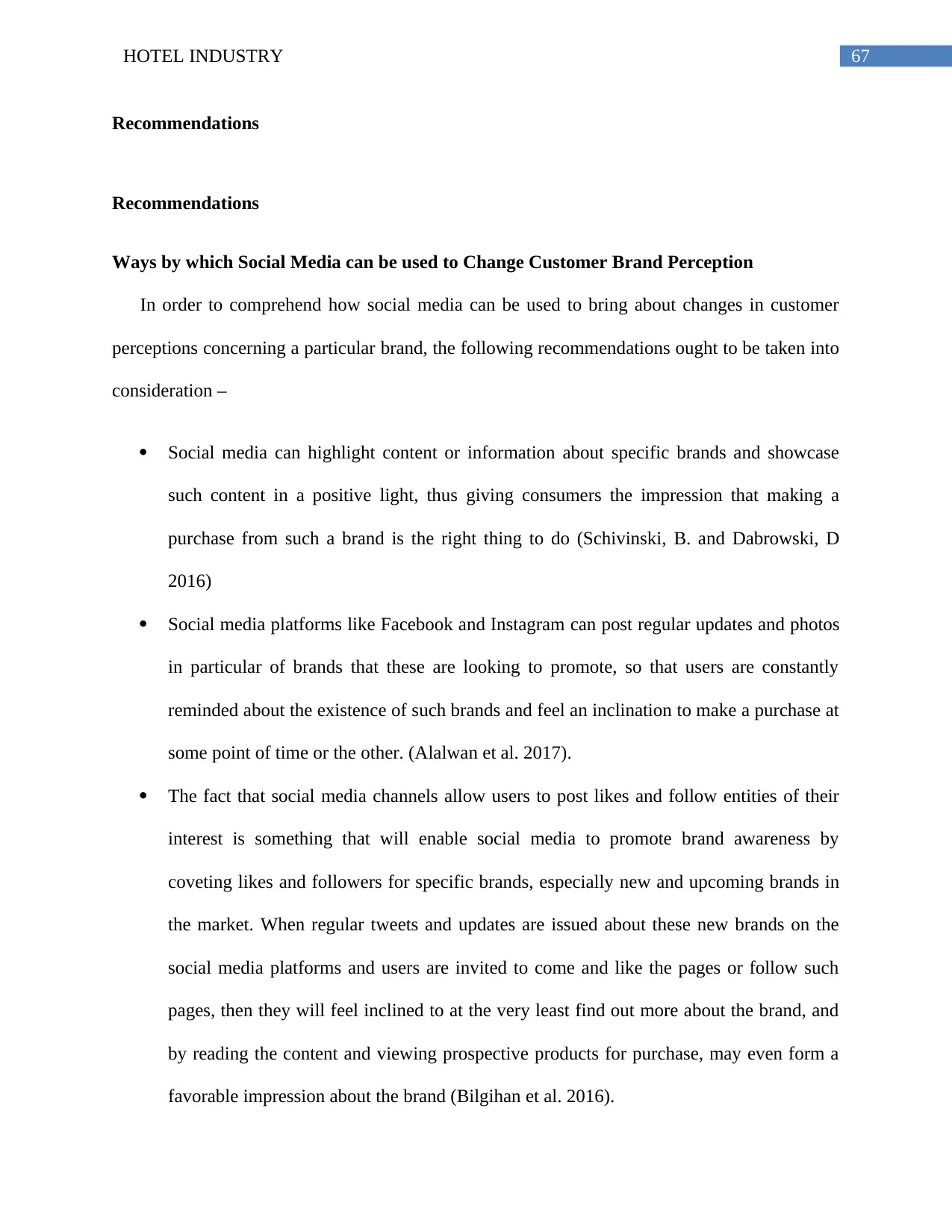
67HOTEL INDUSTRY
Recommendations
Recommendations
Ways by which Social Media can be used to Change Customer Brand Perception
In order to comprehend how social media can be used to bring about changes in customer
perceptions concerning a particular brand, the following recommendations ought to be taken into
consideration –
Social media can highlight content or information about specific brands and showcase
such content in a positive light, thus giving consumers the impression that making a
purchase from such a brand is the right thing to do (Schivinski, B. and Dabrowski, D
2016)
Social media platforms like Facebook and Instagram can post regular updates and photos
in particular of brands that these are looking to promote, so that users are constantly
reminded about the existence of such brands and feel an inclination to make a purchase at
some point of time or the other. (Alalwan et al. 2017).
The fact that social media channels allow users to post likes and follow entities of their
interest is something that will enable social media to promote brand awareness by
coveting likes and followers for specific brands, especially new and upcoming brands in
the market. When regular tweets and updates are issued about these new brands on the
social media platforms and users are invited to come and like the pages or follow such
pages, then they will feel inclined to at the very least find out more about the brand, and
by reading the content and viewing prospective products for purchase, may even form a
favorable impression about the brand (Bilgihan et al. 2016).
Recommendations
Recommendations
Ways by which Social Media can be used to Change Customer Brand Perception
In order to comprehend how social media can be used to bring about changes in customer
perceptions concerning a particular brand, the following recommendations ought to be taken into
consideration –
Social media can highlight content or information about specific brands and showcase
such content in a positive light, thus giving consumers the impression that making a
purchase from such a brand is the right thing to do (Schivinski, B. and Dabrowski, D
2016)
Social media platforms like Facebook and Instagram can post regular updates and photos
in particular of brands that these are looking to promote, so that users are constantly
reminded about the existence of such brands and feel an inclination to make a purchase at
some point of time or the other. (Alalwan et al. 2017).
The fact that social media channels allow users to post likes and follow entities of their
interest is something that will enable social media to promote brand awareness by
coveting likes and followers for specific brands, especially new and upcoming brands in
the market. When regular tweets and updates are issued about these new brands on the
social media platforms and users are invited to come and like the pages or follow such
pages, then they will feel inclined to at the very least find out more about the brand, and
by reading the content and viewing prospective products for purchase, may even form a
favorable impression about the brand (Bilgihan et al. 2016).
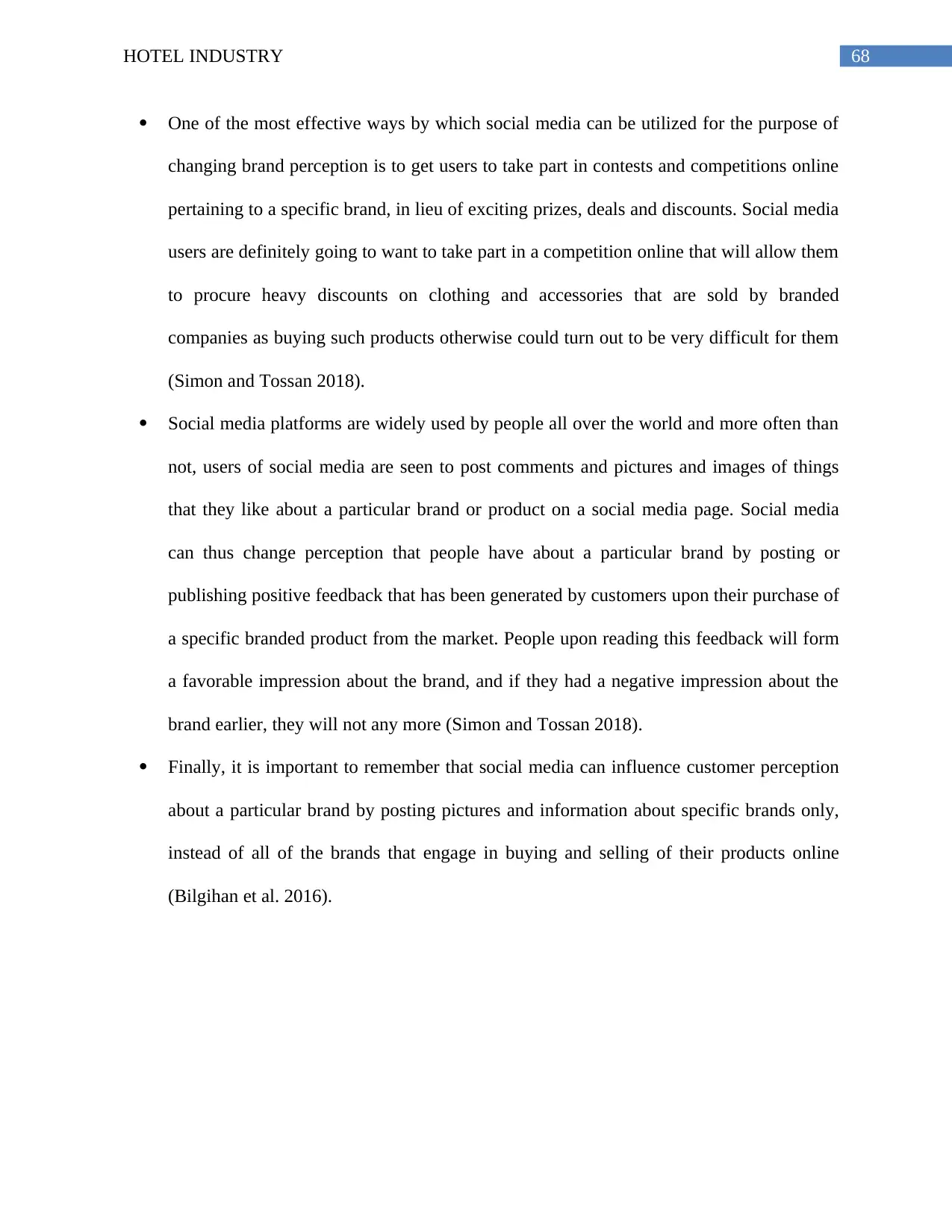
68HOTEL INDUSTRY
One of the most effective ways by which social media can be utilized for the purpose of
changing brand perception is to get users to take part in contests and competitions online
pertaining to a specific brand, in lieu of exciting prizes, deals and discounts. Social media
users are definitely going to want to take part in a competition online that will allow them
to procure heavy discounts on clothing and accessories that are sold by branded
companies as buying such products otherwise could turn out to be very difficult for them
(Simon and Tossan 2018).
Social media platforms are widely used by people all over the world and more often than
not, users of social media are seen to post comments and pictures and images of things
that they like about a particular brand or product on a social media page. Social media
can thus change perception that people have about a particular brand by posting or
publishing positive feedback that has been generated by customers upon their purchase of
a specific branded product from the market. People upon reading this feedback will form
a favorable impression about the brand, and if they had a negative impression about the
brand earlier, they will not any more (Simon and Tossan 2018).
Finally, it is important to remember that social media can influence customer perception
about a particular brand by posting pictures and information about specific brands only,
instead of all of the brands that engage in buying and selling of their products online
(Bilgihan et al. 2016).
One of the most effective ways by which social media can be utilized for the purpose of
changing brand perception is to get users to take part in contests and competitions online
pertaining to a specific brand, in lieu of exciting prizes, deals and discounts. Social media
users are definitely going to want to take part in a competition online that will allow them
to procure heavy discounts on clothing and accessories that are sold by branded
companies as buying such products otherwise could turn out to be very difficult for them
(Simon and Tossan 2018).
Social media platforms are widely used by people all over the world and more often than
not, users of social media are seen to post comments and pictures and images of things
that they like about a particular brand or product on a social media page. Social media
can thus change perception that people have about a particular brand by posting or
publishing positive feedback that has been generated by customers upon their purchase of
a specific branded product from the market. People upon reading this feedback will form
a favorable impression about the brand, and if they had a negative impression about the
brand earlier, they will not any more (Simon and Tossan 2018).
Finally, it is important to remember that social media can influence customer perception
about a particular brand by posting pictures and information about specific brands only,
instead of all of the brands that engage in buying and selling of their products online
(Bilgihan et al. 2016).
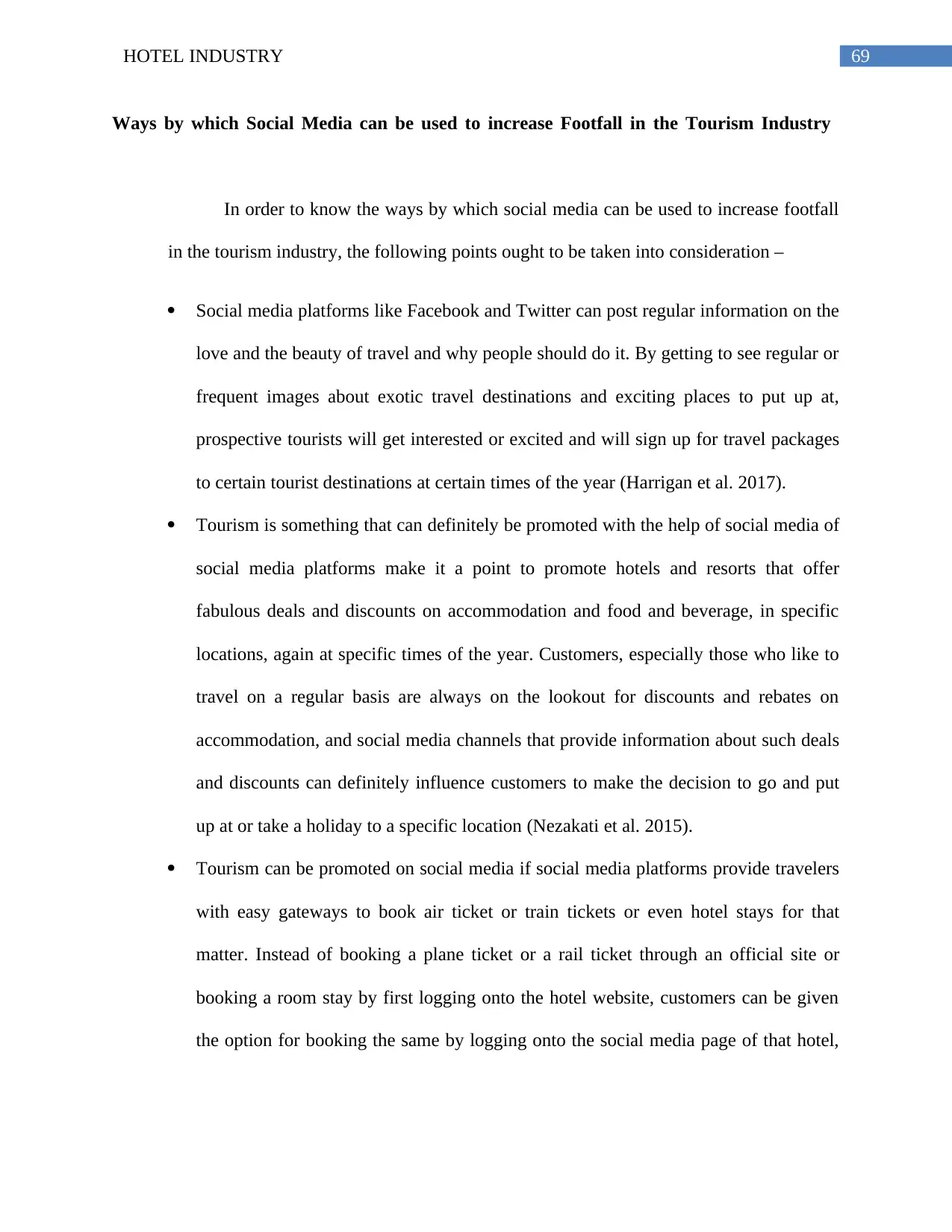
69HOTEL INDUSTRY
Ways by which Social Media can be used to increase Footfall in the Tourism Industry
In order to know the ways by which social media can be used to increase footfall
in the tourism industry, the following points ought to be taken into consideration –
Social media platforms like Facebook and Twitter can post regular information on the
love and the beauty of travel and why people should do it. By getting to see regular or
frequent images about exotic travel destinations and exciting places to put up at,
prospective tourists will get interested or excited and will sign up for travel packages
to certain tourist destinations at certain times of the year (Harrigan et al. 2017).
Tourism is something that can definitely be promoted with the help of social media of
social media platforms make it a point to promote hotels and resorts that offer
fabulous deals and discounts on accommodation and food and beverage, in specific
locations, again at specific times of the year. Customers, especially those who like to
travel on a regular basis are always on the lookout for discounts and rebates on
accommodation, and social media channels that provide information about such deals
and discounts can definitely influence customers to make the decision to go and put
up at or take a holiday to a specific location (Nezakati et al. 2015).
Tourism can be promoted on social media if social media platforms provide travelers
with easy gateways to book air ticket or train tickets or even hotel stays for that
matter. Instead of booking a plane ticket or a rail ticket through an official site or
booking a room stay by first logging onto the hotel website, customers can be given
the option for booking the same by logging onto the social media page of that hotel,
Ways by which Social Media can be used to increase Footfall in the Tourism Industry
In order to know the ways by which social media can be used to increase footfall
in the tourism industry, the following points ought to be taken into consideration –
Social media platforms like Facebook and Twitter can post regular information on the
love and the beauty of travel and why people should do it. By getting to see regular or
frequent images about exotic travel destinations and exciting places to put up at,
prospective tourists will get interested or excited and will sign up for travel packages
to certain tourist destinations at certain times of the year (Harrigan et al. 2017).
Tourism is something that can definitely be promoted with the help of social media of
social media platforms make it a point to promote hotels and resorts that offer
fabulous deals and discounts on accommodation and food and beverage, in specific
locations, again at specific times of the year. Customers, especially those who like to
travel on a regular basis are always on the lookout for discounts and rebates on
accommodation, and social media channels that provide information about such deals
and discounts can definitely influence customers to make the decision to go and put
up at or take a holiday to a specific location (Nezakati et al. 2015).
Tourism can be promoted on social media if social media platforms provide travelers
with easy gateways to book air ticket or train tickets or even hotel stays for that
matter. Instead of booking a plane ticket or a rail ticket through an official site or
booking a room stay by first logging onto the hotel website, customers can be given
the option for booking the same by logging onto the social media page of that hotel,
Secure Best Marks with AI Grader
Need help grading? Try our AI Grader for instant feedback on your assignments.
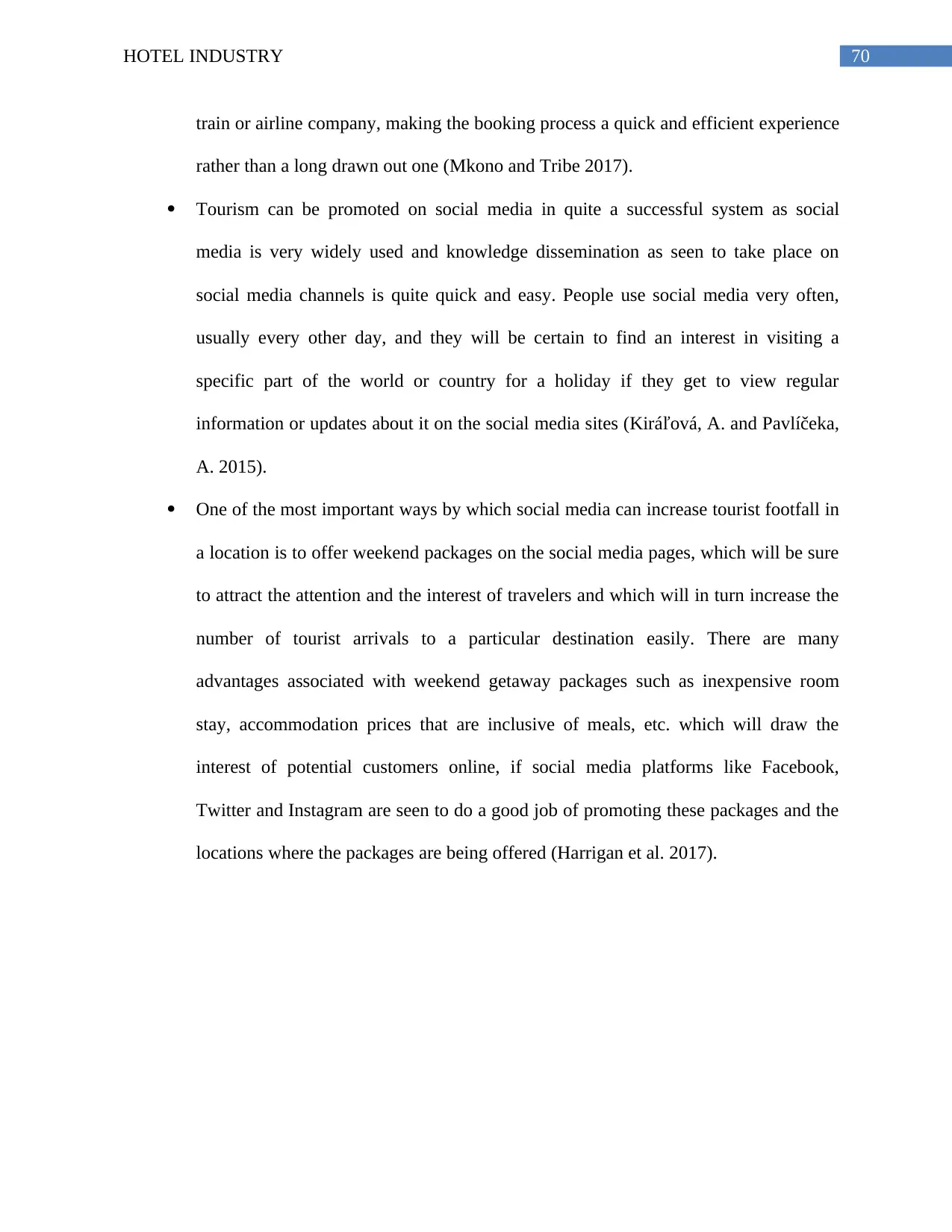
70HOTEL INDUSTRY
train or airline company, making the booking process a quick and efficient experience
rather than a long drawn out one (Mkono and Tribe 2017).
Tourism can be promoted on social media in quite a successful system as social
media is very widely used and knowledge dissemination as seen to take place on
social media channels is quite quick and easy. People use social media very often,
usually every other day, and they will be certain to find an interest in visiting a
specific part of the world or country for a holiday if they get to view regular
information or updates about it on the social media sites (Kiráľová, A. and Pavlíčeka,
A. 2015).
One of the most important ways by which social media can increase tourist footfall in
a location is to offer weekend packages on the social media pages, which will be sure
to attract the attention and the interest of travelers and which will in turn increase the
number of tourist arrivals to a particular destination easily. There are many
advantages associated with weekend getaway packages such as inexpensive room
stay, accommodation prices that are inclusive of meals, etc. which will draw the
interest of potential customers online, if social media platforms like Facebook,
Twitter and Instagram are seen to do a good job of promoting these packages and the
locations where the packages are being offered (Harrigan et al. 2017).
train or airline company, making the booking process a quick and efficient experience
rather than a long drawn out one (Mkono and Tribe 2017).
Tourism can be promoted on social media in quite a successful system as social
media is very widely used and knowledge dissemination as seen to take place on
social media channels is quite quick and easy. People use social media very often,
usually every other day, and they will be certain to find an interest in visiting a
specific part of the world or country for a holiday if they get to view regular
information or updates about it on the social media sites (Kiráľová, A. and Pavlíčeka,
A. 2015).
One of the most important ways by which social media can increase tourist footfall in
a location is to offer weekend packages on the social media pages, which will be sure
to attract the attention and the interest of travelers and which will in turn increase the
number of tourist arrivals to a particular destination easily. There are many
advantages associated with weekend getaway packages such as inexpensive room
stay, accommodation prices that are inclusive of meals, etc. which will draw the
interest of potential customers online, if social media platforms like Facebook,
Twitter and Instagram are seen to do a good job of promoting these packages and the
locations where the packages are being offered (Harrigan et al. 2017).
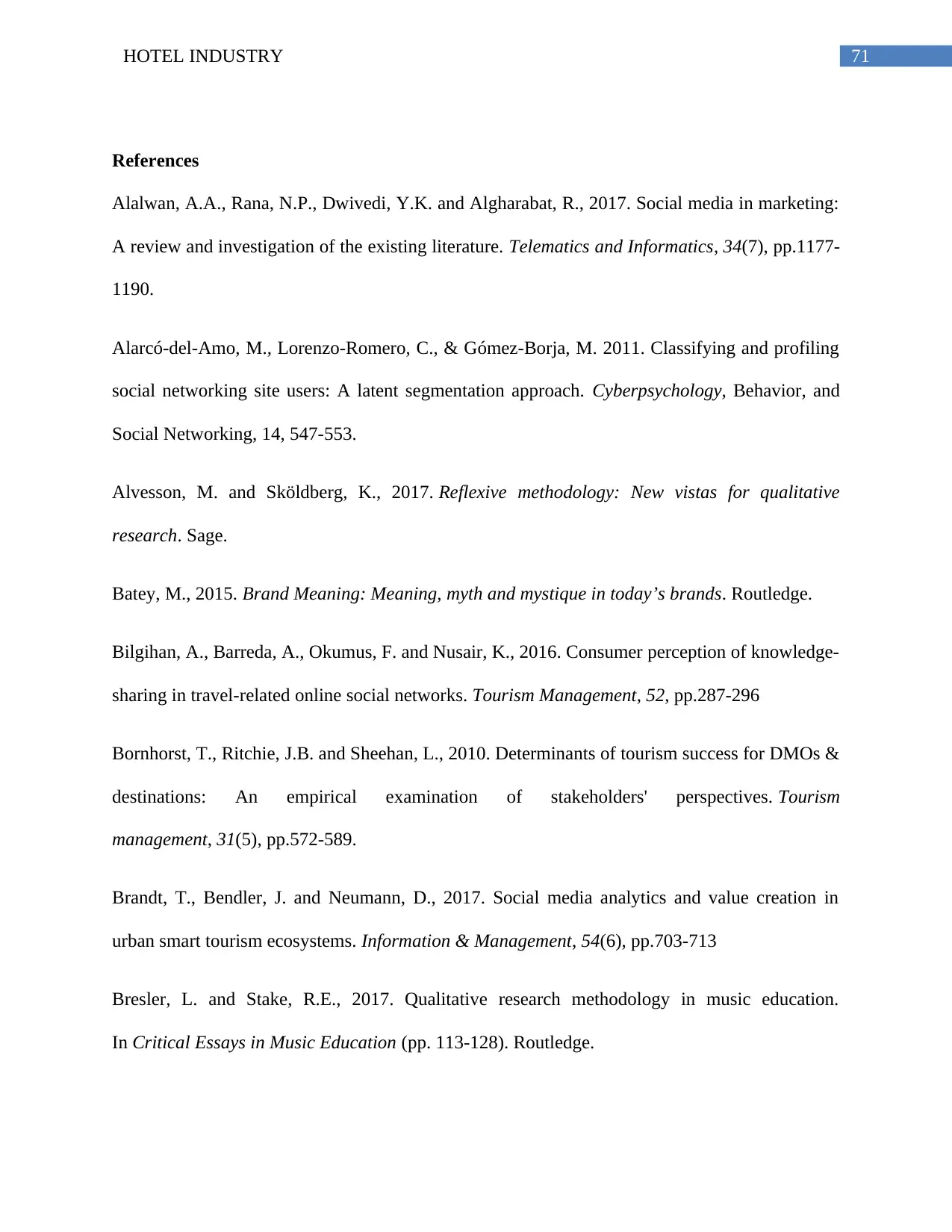
71HOTEL INDUSTRY
References
Alalwan, A.A., Rana, N.P., Dwivedi, Y.K. and Algharabat, R., 2017. Social media in marketing:
A review and investigation of the existing literature. Telematics and Informatics, 34(7), pp.1177-
1190.
Alarcó-del-Amo, M., Lorenzo-Romero, C., & Gómez-Borja, M. 2011. Classifying and profiling
social networking site users: A latent segmentation approach. Cyberpsychology, Behavior, and
Social Networking, 14, 547-553.
Alvesson, M. and Sköldberg, K., 2017. Reflexive methodology: New vistas for qualitative
research. Sage.
Batey, M., 2015. Brand Meaning: Meaning, myth and mystique in today’s brands. Routledge.
Bilgihan, A., Barreda, A., Okumus, F. and Nusair, K., 2016. Consumer perception of knowledge-
sharing in travel-related online social networks. Tourism Management, 52, pp.287-296
Bornhorst, T., Ritchie, J.B. and Sheehan, L., 2010. Determinants of tourism success for DMOs &
destinations: An empirical examination of stakeholders' perspectives. Tourism
management, 31(5), pp.572-589.
Brandt, T., Bendler, J. and Neumann, D., 2017. Social media analytics and value creation in
urban smart tourism ecosystems. Information & Management, 54(6), pp.703-713
Bresler, L. and Stake, R.E., 2017. Qualitative research methodology in music education.
In Critical Essays in Music Education (pp. 113-128). Routledge.
References
Alalwan, A.A., Rana, N.P., Dwivedi, Y.K. and Algharabat, R., 2017. Social media in marketing:
A review and investigation of the existing literature. Telematics and Informatics, 34(7), pp.1177-
1190.
Alarcó-del-Amo, M., Lorenzo-Romero, C., & Gómez-Borja, M. 2011. Classifying and profiling
social networking site users: A latent segmentation approach. Cyberpsychology, Behavior, and
Social Networking, 14, 547-553.
Alvesson, M. and Sköldberg, K., 2017. Reflexive methodology: New vistas for qualitative
research. Sage.
Batey, M., 2015. Brand Meaning: Meaning, myth and mystique in today’s brands. Routledge.
Bilgihan, A., Barreda, A., Okumus, F. and Nusair, K., 2016. Consumer perception of knowledge-
sharing in travel-related online social networks. Tourism Management, 52, pp.287-296
Bornhorst, T., Ritchie, J.B. and Sheehan, L., 2010. Determinants of tourism success for DMOs &
destinations: An empirical examination of stakeholders' perspectives. Tourism
management, 31(5), pp.572-589.
Brandt, T., Bendler, J. and Neumann, D., 2017. Social media analytics and value creation in
urban smart tourism ecosystems. Information & Management, 54(6), pp.703-713
Bresler, L. and Stake, R.E., 2017. Qualitative research methodology in music education.
In Critical Essays in Music Education (pp. 113-128). Routledge.
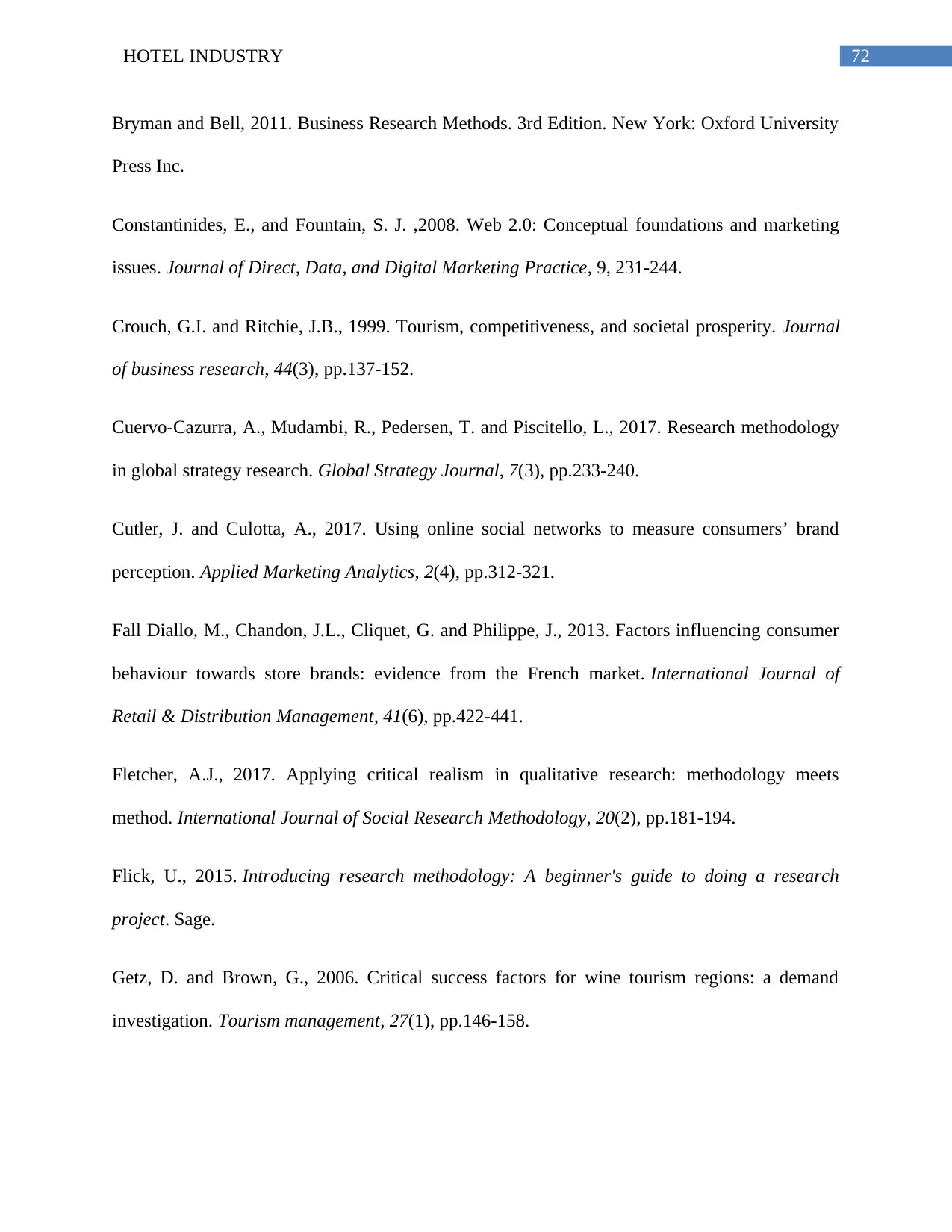
72HOTEL INDUSTRY
Bryman and Bell, 2011. Business Research Methods. 3rd Edition. New York: Oxford University
Press Inc.
Constantinides, E., and Fountain, S. J. ,2008. Web 2.0: Conceptual foundations and marketing
issues. Journal of Direct, Data, and Digital Marketing Practice, 9, 231-244.
Crouch, G.I. and Ritchie, J.B., 1999. Tourism, competitiveness, and societal prosperity. Journal
of business research, 44(3), pp.137-152.
Cuervo‐Cazurra, A., Mudambi, R., Pedersen, T. and Piscitello, L., 2017. Research methodology
in global strategy research. Global Strategy Journal, 7(3), pp.233-240.
Cutler, J. and Culotta, A., 2017. Using online social networks to measure consumers’ brand
perception. Applied Marketing Analytics, 2(4), pp.312-321.
Fall Diallo, M., Chandon, J.L., Cliquet, G. and Philippe, J., 2013. Factors influencing consumer
behaviour towards store brands: evidence from the French market. International Journal of
Retail & Distribution Management, 41(6), pp.422-441.
Fletcher, A.J., 2017. Applying critical realism in qualitative research: methodology meets
method. International Journal of Social Research Methodology, 20(2), pp.181-194.
Flick, U., 2015. Introducing research methodology: A beginner's guide to doing a research
project. Sage.
Getz, D. and Brown, G., 2006. Critical success factors for wine tourism regions: a demand
investigation. Tourism management, 27(1), pp.146-158.
Bryman and Bell, 2011. Business Research Methods. 3rd Edition. New York: Oxford University
Press Inc.
Constantinides, E., and Fountain, S. J. ,2008. Web 2.0: Conceptual foundations and marketing
issues. Journal of Direct, Data, and Digital Marketing Practice, 9, 231-244.
Crouch, G.I. and Ritchie, J.B., 1999. Tourism, competitiveness, and societal prosperity. Journal
of business research, 44(3), pp.137-152.
Cuervo‐Cazurra, A., Mudambi, R., Pedersen, T. and Piscitello, L., 2017. Research methodology
in global strategy research. Global Strategy Journal, 7(3), pp.233-240.
Cutler, J. and Culotta, A., 2017. Using online social networks to measure consumers’ brand
perception. Applied Marketing Analytics, 2(4), pp.312-321.
Fall Diallo, M., Chandon, J.L., Cliquet, G. and Philippe, J., 2013. Factors influencing consumer
behaviour towards store brands: evidence from the French market. International Journal of
Retail & Distribution Management, 41(6), pp.422-441.
Fletcher, A.J., 2017. Applying critical realism in qualitative research: methodology meets
method. International Journal of Social Research Methodology, 20(2), pp.181-194.
Flick, U., 2015. Introducing research methodology: A beginner's guide to doing a research
project. Sage.
Getz, D. and Brown, G., 2006. Critical success factors for wine tourism regions: a demand
investigation. Tourism management, 27(1), pp.146-158.
Paraphrase This Document
Need a fresh take? Get an instant paraphrase of this document with our AI Paraphraser
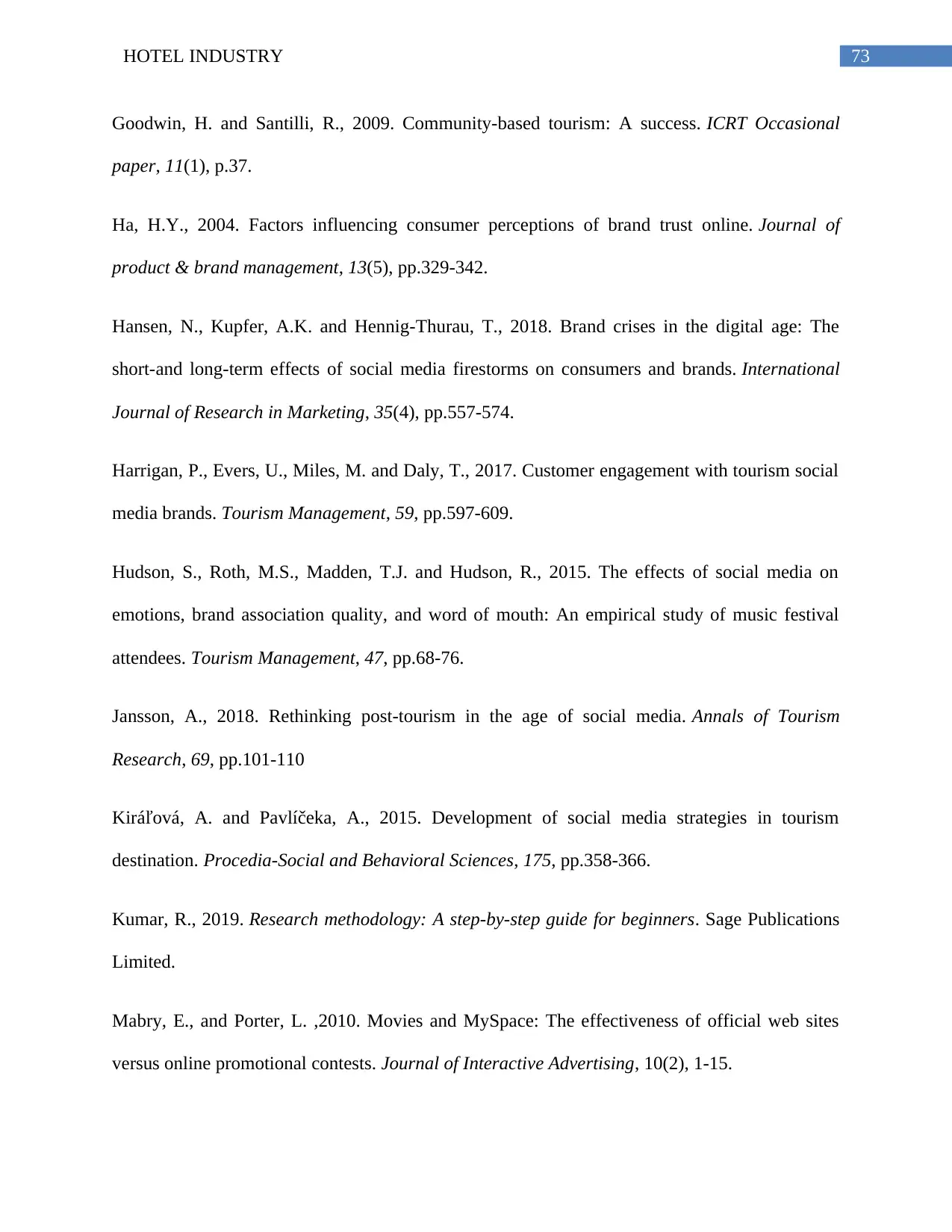
73HOTEL INDUSTRY
Goodwin, H. and Santilli, R., 2009. Community-based tourism: A success. ICRT Occasional
paper, 11(1), p.37.
Ha, H.Y., 2004. Factors influencing consumer perceptions of brand trust online. Journal of
product & brand management, 13(5), pp.329-342.
Hansen, N., Kupfer, A.K. and Hennig-Thurau, T., 2018. Brand crises in the digital age: The
short-and long-term effects of social media firestorms on consumers and brands. International
Journal of Research in Marketing, 35(4), pp.557-574.
Harrigan, P., Evers, U., Miles, M. and Daly, T., 2017. Customer engagement with tourism social
media brands. Tourism Management, 59, pp.597-609.
Hudson, S., Roth, M.S., Madden, T.J. and Hudson, R., 2015. The effects of social media on
emotions, brand association quality, and word of mouth: An empirical study of music festival
attendees. Tourism Management, 47, pp.68-76.
Jansson, A., 2018. Rethinking post-tourism in the age of social media. Annals of Tourism
Research, 69, pp.101-110
Kiráľová, A. and Pavlíčeka, A., 2015. Development of social media strategies in tourism
destination. Procedia-Social and Behavioral Sciences, 175, pp.358-366.
Kumar, R., 2019. Research methodology: A step-by-step guide for beginners. Sage Publications
Limited.
Mabry, E., and Porter, L. ,2010. Movies and MySpace: The effectiveness of official web sites
versus online promotional contests. Journal of Interactive Advertising, 10(2), 1‐15.
Goodwin, H. and Santilli, R., 2009. Community-based tourism: A success. ICRT Occasional
paper, 11(1), p.37.
Ha, H.Y., 2004. Factors influencing consumer perceptions of brand trust online. Journal of
product & brand management, 13(5), pp.329-342.
Hansen, N., Kupfer, A.K. and Hennig-Thurau, T., 2018. Brand crises in the digital age: The
short-and long-term effects of social media firestorms on consumers and brands. International
Journal of Research in Marketing, 35(4), pp.557-574.
Harrigan, P., Evers, U., Miles, M. and Daly, T., 2017. Customer engagement with tourism social
media brands. Tourism Management, 59, pp.597-609.
Hudson, S., Roth, M.S., Madden, T.J. and Hudson, R., 2015. The effects of social media on
emotions, brand association quality, and word of mouth: An empirical study of music festival
attendees. Tourism Management, 47, pp.68-76.
Jansson, A., 2018. Rethinking post-tourism in the age of social media. Annals of Tourism
Research, 69, pp.101-110
Kiráľová, A. and Pavlíčeka, A., 2015. Development of social media strategies in tourism
destination. Procedia-Social and Behavioral Sciences, 175, pp.358-366.
Kumar, R., 2019. Research methodology: A step-by-step guide for beginners. Sage Publications
Limited.
Mabry, E., and Porter, L. ,2010. Movies and MySpace: The effectiveness of official web sites
versus online promotional contests. Journal of Interactive Advertising, 10(2), 1‐15.

74HOTEL INDUSTRY
Mackey, A. and Gass, S.M., 2015. Second language research: Methodology and design.
Routledge.
media to grow their businesses. [ONLINE] Available at:
http://marketingwhitepapers.s3.amazonaws.com/smss09/SocialMediaMarketingIndustryReport.p
df [Accessed 24/06/19].
Merriam-Webster. 2012. “Social media” [ONLINE] Available at:
http://www.learnersdictionary.com/definition/social%20media [Accessed 24/06/19].
Mkono, M. and Tribe, J., 2017. Beyond reviewing: Uncovering the multiple roles of tourism
social media users. Journal of Travel Research, 56(3), pp.287-298.
Moro, S. and Rita, P., 2018. Brand strategies in social media in hospitality and
tourism. International Journal of Contemporary Hospitality Management, 30(1), pp.343-364.
Morrison, A., Lynch, P. and Johns, N., 2004. International tourism networks. International
Journal of Contemporary Hospitality Management, 16(3), pp.197-202.
Nezakati, H., Amidi, A., Jusoh, Y.Y., Moghadas, S., Aziz, Y.A. and Sohrabinezhadtalemi, R.,
2015. Review of social media potential on knowledge sharing and collaboration in tourism
industry. Procedia-social and behavioral sciences, 172, pp.120-125.
Nielsen, H. and Spenceley, A., 2011. The success of tourism in Rwanda: Gorillas and more. Yes
Africa Can: Success stories from a dynamic continent, pp.231-249.
Quinlan, C., Babin, B., Carr, J. and Griffin, M., 2019. Business research methods. South Western
Cengage.
Mackey, A. and Gass, S.M., 2015. Second language research: Methodology and design.
Routledge.
media to grow their businesses. [ONLINE] Available at:
http://marketingwhitepapers.s3.amazonaws.com/smss09/SocialMediaMarketingIndustryReport.p
df [Accessed 24/06/19].
Merriam-Webster. 2012. “Social media” [ONLINE] Available at:
http://www.learnersdictionary.com/definition/social%20media [Accessed 24/06/19].
Mkono, M. and Tribe, J., 2017. Beyond reviewing: Uncovering the multiple roles of tourism
social media users. Journal of Travel Research, 56(3), pp.287-298.
Moro, S. and Rita, P., 2018. Brand strategies in social media in hospitality and
tourism. International Journal of Contemporary Hospitality Management, 30(1), pp.343-364.
Morrison, A., Lynch, P. and Johns, N., 2004. International tourism networks. International
Journal of Contemporary Hospitality Management, 16(3), pp.197-202.
Nezakati, H., Amidi, A., Jusoh, Y.Y., Moghadas, S., Aziz, Y.A. and Sohrabinezhadtalemi, R.,
2015. Review of social media potential on knowledge sharing and collaboration in tourism
industry. Procedia-social and behavioral sciences, 172, pp.120-125.
Nielsen, H. and Spenceley, A., 2011. The success of tourism in Rwanda: Gorillas and more. Yes
Africa Can: Success stories from a dynamic continent, pp.231-249.
Quinlan, C., Babin, B., Carr, J. and Griffin, M., 2019. Business research methods. South Western
Cengage.

75HOTEL INDUSTRY
Rani, P., 2014. Factors influencing consumer behaviour. International journal of current
research and academic review, 2(9), pp.52-61.
Schivinski, B. and Dabrowski, D., 2016. The effect of social media communication on consumer
perceptions of brands. Journal of Marketing Communications, 22(2), pp.189-214.
Sethuraman, R. and Cole, C., 1999. Factors influencing the price premiums that consumers pay
for national brands over store brands. Journal of Product & Brand Management, 8(4), pp.340-
351
Sharpley, R., 2002. Rural tourism and the challenge of tourism diversification: the case of
Cyprus. Tourism management, 23(3), pp.233-244.
Silverman, D. ed., 2016. Qualitative research. Sage.
Simon, F. and Tossan, V., 2018. Does brand-consumer social sharing matter? A relational
framework of customer engagement to brand-hosted social media. Journal of Business
Research, 85, pp.175-184.
Smith, J.A. ed., 2015. Qualitative psychology: A practical guide to research methods. Sage.
Stelzner, M. A. 2009. Social media marketing industry report: How marketers are using social
Stelzner, M. A. 2011. 2011 social media marketing industry report: How marketers are using
social media to grow their businesses. [ONLINE] Available at:
https://www.socialmediaexaminer.com/social-media-marketing-industry-report-2011/ [Accessed
24/06/19].
Rani, P., 2014. Factors influencing consumer behaviour. International journal of current
research and academic review, 2(9), pp.52-61.
Schivinski, B. and Dabrowski, D., 2016. The effect of social media communication on consumer
perceptions of brands. Journal of Marketing Communications, 22(2), pp.189-214.
Sethuraman, R. and Cole, C., 1999. Factors influencing the price premiums that consumers pay
for national brands over store brands. Journal of Product & Brand Management, 8(4), pp.340-
351
Sharpley, R., 2002. Rural tourism and the challenge of tourism diversification: the case of
Cyprus. Tourism management, 23(3), pp.233-244.
Silverman, D. ed., 2016. Qualitative research. Sage.
Simon, F. and Tossan, V., 2018. Does brand-consumer social sharing matter? A relational
framework of customer engagement to brand-hosted social media. Journal of Business
Research, 85, pp.175-184.
Smith, J.A. ed., 2015. Qualitative psychology: A practical guide to research methods. Sage.
Stelzner, M. A. 2009. Social media marketing industry report: How marketers are using social
Stelzner, M. A. 2011. 2011 social media marketing industry report: How marketers are using
social media to grow their businesses. [ONLINE] Available at:
https://www.socialmediaexaminer.com/social-media-marketing-industry-report-2011/ [Accessed
24/06/19].
Secure Best Marks with AI Grader
Need help grading? Try our AI Grader for instant feedback on your assignments.
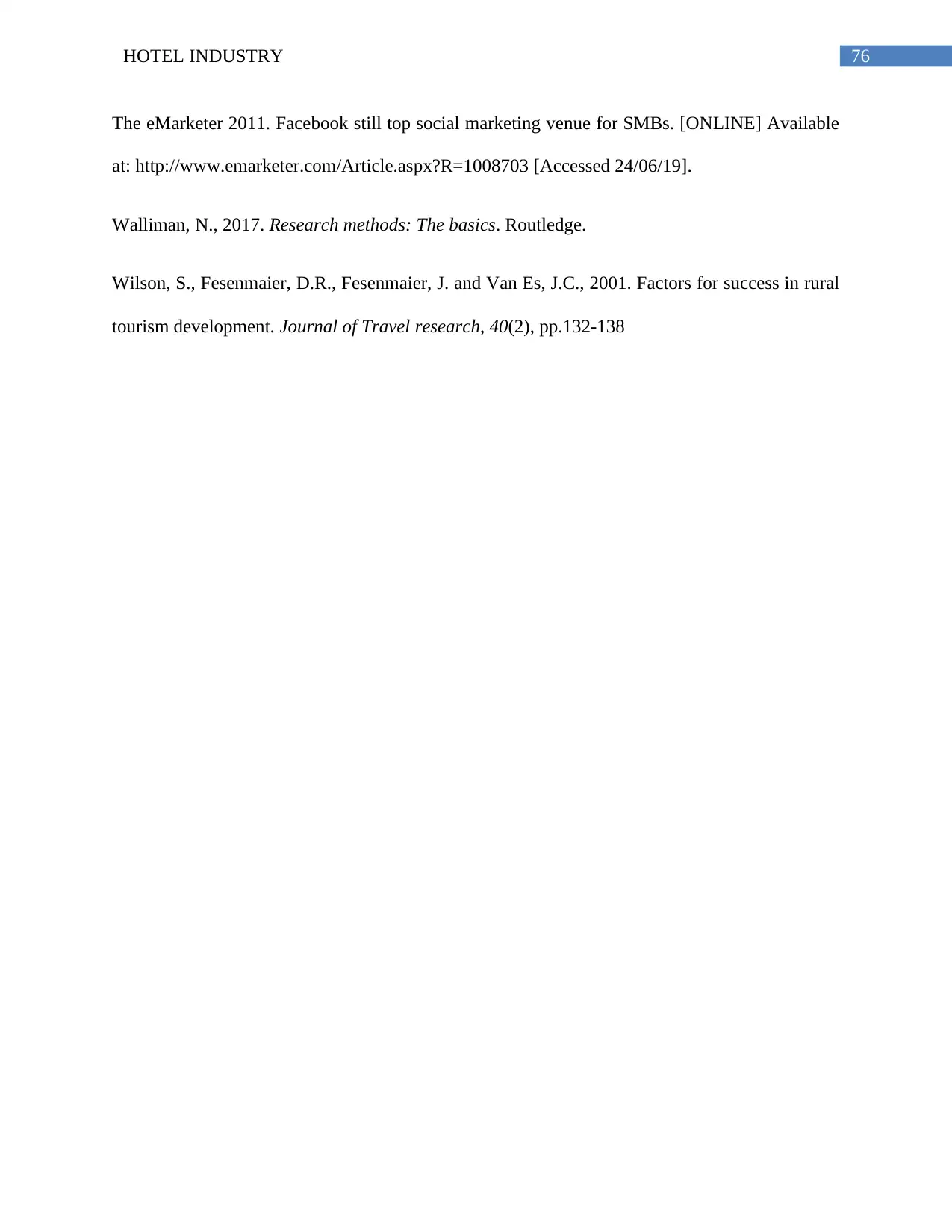
76HOTEL INDUSTRY
The eMarketer 2011. Facebook still top social marketing venue for SMBs. [ONLINE] Available
at: http://www.emarketer.com/Article.aspx?R=1008703 [Accessed 24/06/19].
Walliman, N., 2017. Research methods: The basics. Routledge.
Wilson, S., Fesenmaier, D.R., Fesenmaier, J. and Van Es, J.C., 2001. Factors for success in rural
tourism development. Journal of Travel research, 40(2), pp.132-138
The eMarketer 2011. Facebook still top social marketing venue for SMBs. [ONLINE] Available
at: http://www.emarketer.com/Article.aspx?R=1008703 [Accessed 24/06/19].
Walliman, N., 2017. Research methods: The basics. Routledge.
Wilson, S., Fesenmaier, D.R., Fesenmaier, J. and Van Es, J.C., 2001. Factors for success in rural
tourism development. Journal of Travel research, 40(2), pp.132-138
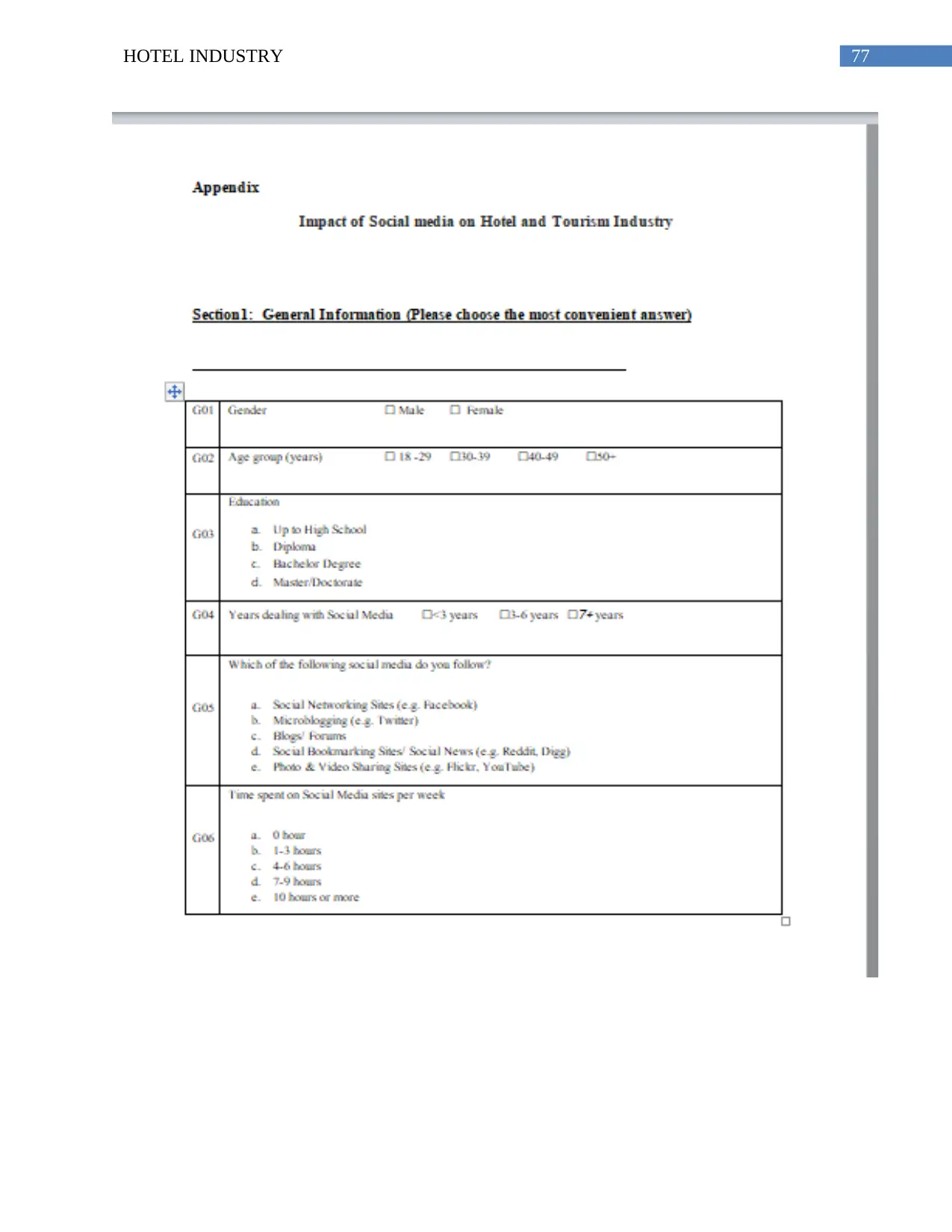
77HOTEL INDUSTRY

78HOTEL INDUSTRY
Paraphrase This Document
Need a fresh take? Get an instant paraphrase of this document with our AI Paraphraser
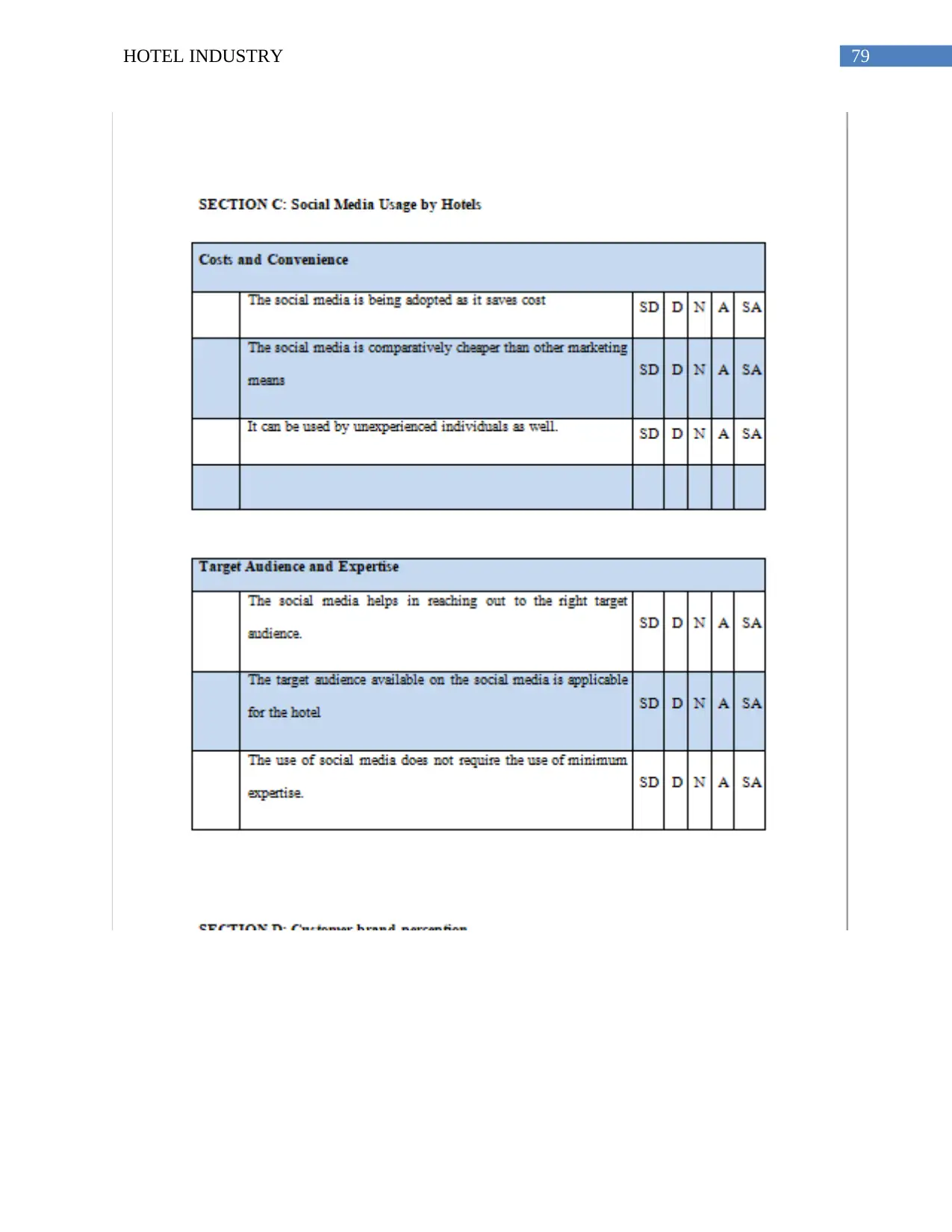
79HOTEL INDUSTRY
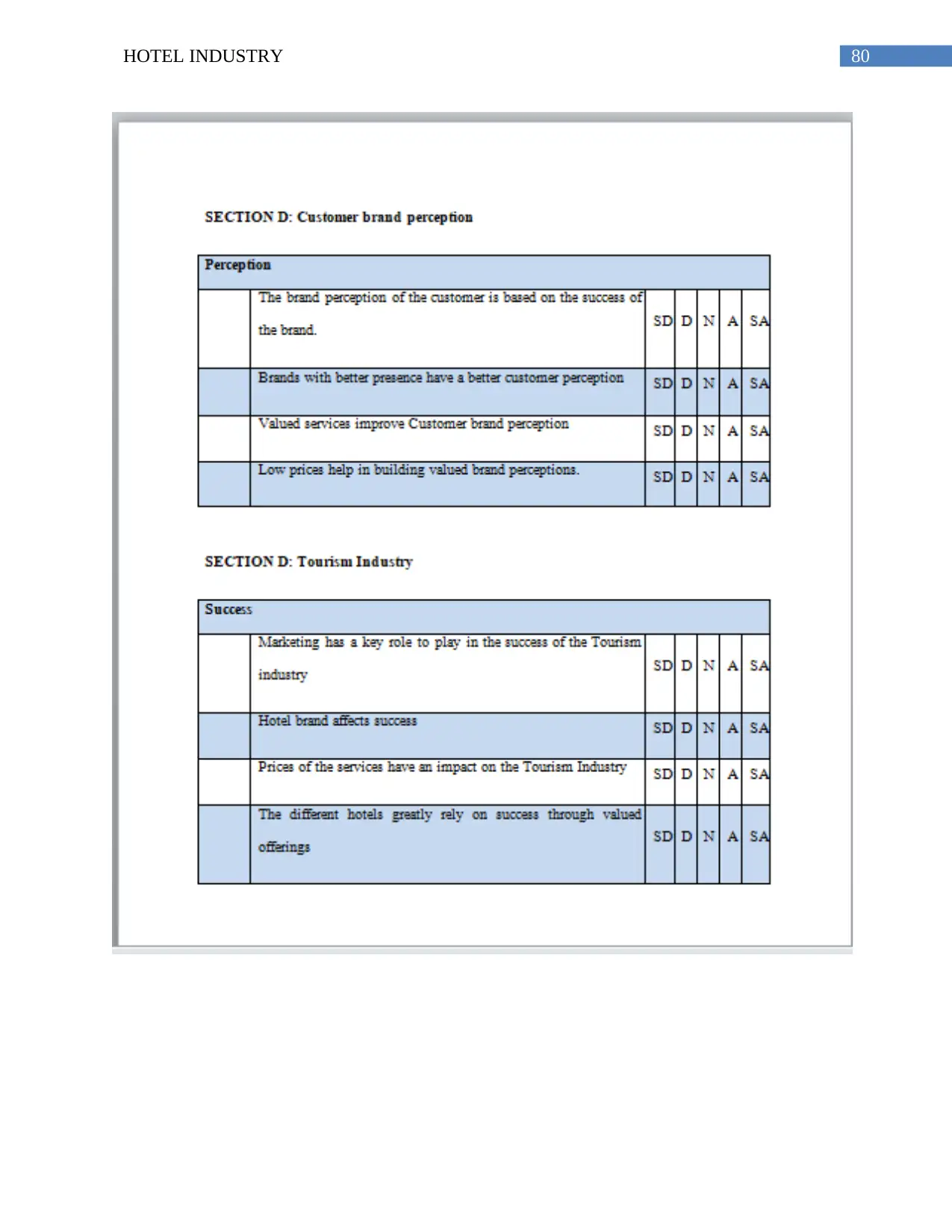
80HOTEL INDUSTRY

81HOTEL INDUSTRY
Secure Best Marks with AI Grader
Need help grading? Try our AI Grader for instant feedback on your assignments.
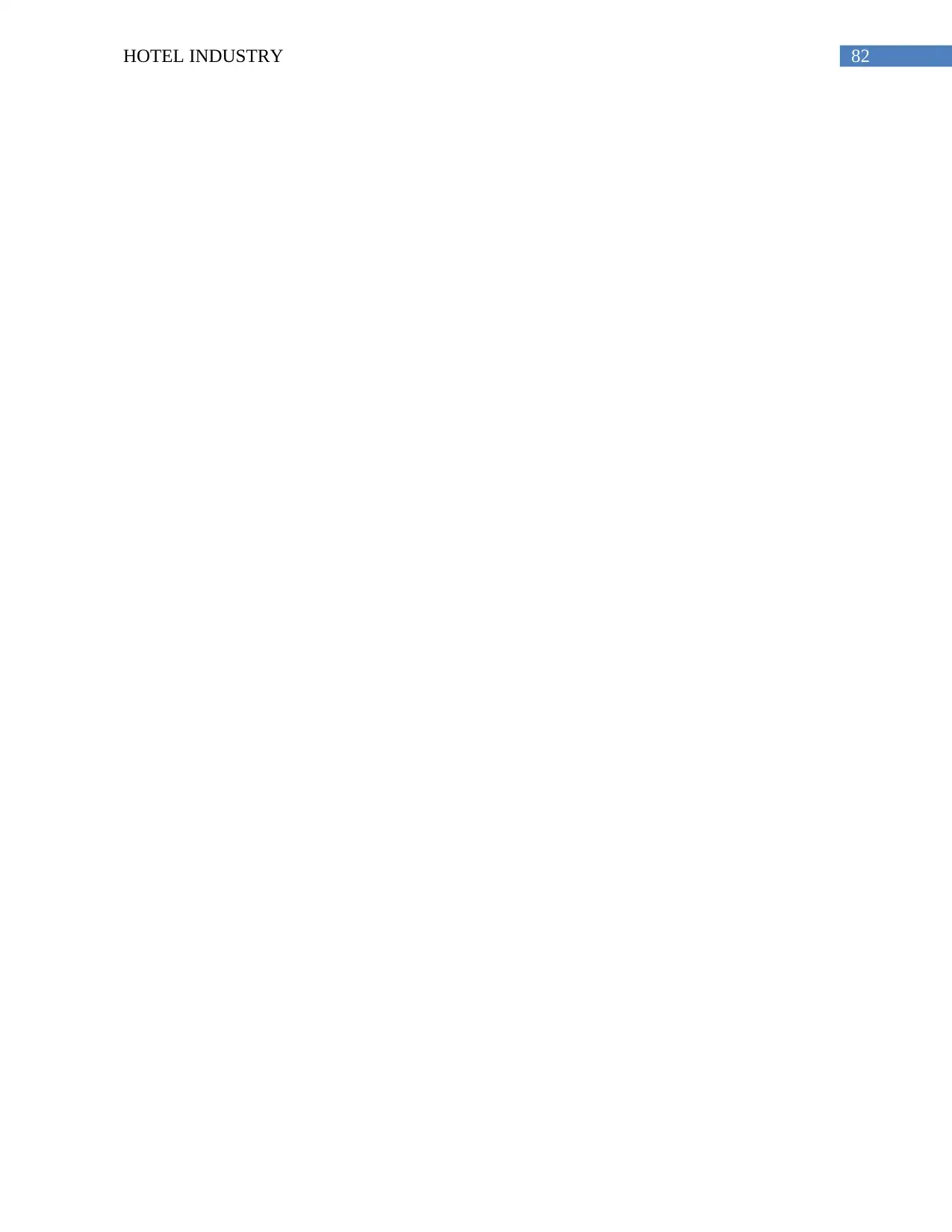
82HOTEL INDUSTRY
1 out of 83
Related Documents
Your All-in-One AI-Powered Toolkit for Academic Success.
+13062052269
info@desklib.com
Available 24*7 on WhatsApp / Email
![[object Object]](/_next/static/media/star-bottom.7253800d.svg)
Unlock your academic potential
© 2024 | Zucol Services PVT LTD | All rights reserved.





